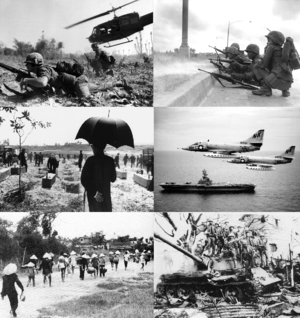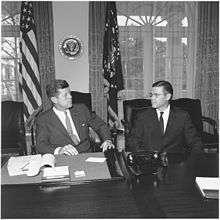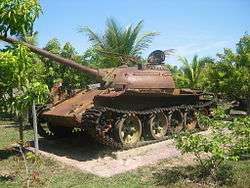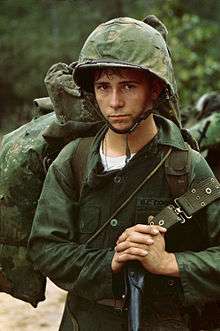Vietnam War
The Vietnam War (Vietnamese: Chiến tranh Việt Nam), also known as the Second Indochina War,[56] and in Vietnam as the Resistance War Against America (Vietnamese: Kháng chiến chống Mỹ) or simply the American War, was a conflict in Vietnam, Laos, and Cambodia from 1 November 1955[A 1] to the fall of Saigon on 30 April 1975.[5] It was the second of the Indochina Wars and was officially fought between North Vietnam and South Vietnam. North Vietnam was supported by the Soviet Union, China,[14] and other communist allies; South Vietnam was supported by the United States, South Korea, the Philippines, Australia, Thailand and other anti-communist allies.[57][58] The war, considered a Cold War-era proxy war by some,[59] lasted 19 years, with direct U.S. involvement ending in 1973, and included the Laotian Civil War and the Cambodian Civil War, which ended with all three countries becoming communist in 1975.
The conflict emerged from the First Indochina War against the communist-led Viet Minh.[60][A 4] Most of the funding for the French war effort was provided by the U.S.[61] After the French quit Indochina in 1954, the US assumed financial and military support for the South Vietnamese state. The Việt Cộng, also known as Front national de libération du Sud-Viêt Nam or NLF (the National Liberation Front), a South Vietnamese common front under the direction of North Vietnam, initiated a guerrilla war in the south. North Vietnam had also invaded Laos in the mid-1950s in support of insurgents, establishing the Ho Chi Minh Trail to supply and reinforce the Việt Cộng.[62]:16 U.S. involvement escalated under President John F. Kennedy through the MAAG program from just under a thousand military advisors in 1959 to 16,000 in 1963.[63][32]:131 By 1963, the North Vietnamese had sent 40,000 soldiers to fight in South Vietnam.[62]:16 North Vietnam was heavily backed by the USSR and the People's Republic of China. China also sent hundreds of PLA servicemen to North Vietnam to serve in air-defense and support roles.[32]:371–4[64]
By 1964, 23,000 US advisors were stationed in South Vietnam. In the Gulf of Tonkin incident in August, a U.S. destroyer was alleged to have clashed with North Vietnamese fast attack craft. In response, the U.S. Congress passed the Gulf of Tonkin Resolution and gave President Lyndon B. Johnson broad authority to increase American military presence in Vietnam. Johnson ordered the deployment of combat units for the first time and increased troop levels to 184,000.[63] Past this point, the People's Army of Vietnam (PAVN) (also known as the North Vietnamese Army or NVA) engaged in more conventional warfare with U.S and South Vietnamese forces. Despite little progress, the United States continued a significant built-up of forces. U.S. Secretary of Defense Robert McNamara, one of the principal architects of the war, began expressing doubts of victory by the end of 1966.[32]:287 U.S. and South Vietnam forces relied on air superiority and overwhelming firepower to conduct search and destroy operations, involving ground forces, artillery, and airstrikes. The U.S. also conducted a large-scale strategic bombing campaign against North Vietnam and Laos.
The Tet Offensive of 1968 showed the lack of progress with these doctrines. With the VC and PAVN mounting large-scale urban offensives throughout 1968, U.S domestic support for the war began fading. The Army of the Republic of Vietnam (ARVN) expanded following a period of neglect after Tet and was modeled after U.S doctrine. The VC sustained heavy losses during the Tet Offensive and subsequent U.S.-ARVN operations in the rest of 1968, losing over 50,000 men.[32]:481 The CIA's Phoenix Program further degraded the VC's membership and capabilities. By the end of the year, the VC insurgents held almost no territory in South Vietnam, and their recruitment dropped by over 80% in 1969, signifying a drastic reduction in guerrilla operations, necessitating increased use of PAVN regular soldiers from the north.[11]:247–9 In 1969, North Vietnam declared a Provisional Revolutionary Government in South Vietnam in an attempt to give the reduced VC a more international stature, but the southern guerrillas from then on were sidelined as PAVN forces began more conventional combined arms warfare. By 1970, over 70% of communist troops in the south were northerners, and southern-dominated VC units no longer existed.[65] Operations crossed national borders: Laos was invaded by North Vietnam early on, while Cambodia was used by North Vietnam as a supply route starting in 1967; the route through Cambodia began to be bombed by the U.S. in 1969, while the Laos route had been heavily bombed since 1964. The deposing of the monarch Norodom Sihanouk by the Cambodian National Assembly resulted in a PAVN invasion of the country at the request of the Khmer Rouge, escalating the Cambodian Civil War and resulting in a U.S.-ARVN counter-invasion.
In 1969, following the election of U.S President Richard Nixon, a policy of "Vietnamization" began, which saw the conflict fought by an expanded ARVN, with U.S. forces sidelined and increasingly demoralized by domestic opposition and reduced recruitment. U.S. ground forces had largely withdrawn by early 1972 and support was limited to air support, artillery support, advisers, and materiel shipments. The ARVN, buttressed by said U.S. support, stopped the first and largest mechanized PAVN offensive during the Easter Offensive of 1972. The offensive resulted in heavy casualties on both sides and the failure of the PAVN to subdue South Vietnam, but the ARVN itself failed to recapture all territory, leaving its military situation difficult. The Paris Peace Accords of January 1973 saw all U.S forces withdrawn; the Case–Church Amendment, passed by the U.S Congress on 15 August 1973, officially ended direct U.S military involvement.[66]:457 The Peace Accords were broken almost immediately, and fighting continued for two more years. Phnom Penh fell to the Khmer Rouge on 17 April 1975 while the 1975 Spring Offensive saw the capture of Saigon by the PAVN on 30 April; this marked the end of the war, and North and South Vietnam were reunified the following year.
The scale of fighting was enormous. By 1970, the ARVN was the world's fourth largest army, and the PAVN was not far behind with approximately one million regular soldiers.[67][17]:770 The war exacted an enormous human cost: estimates of the number of Vietnamese soldiers and civilians killed range from 966,000[27] to 3.8 million.[52] Some 275,000–310,000 Cambodians,[53][54][55] 20,000–62,000 Laotians,[52] and 58,220 U.S. service members also died in the conflict, and a further 1,626 remain missing in action.[A 3]
The Sino-Soviet split re-emerged following the lull during the Vietnam War. Conflict between North Vietnam and its Cambodian allies in the Royal Government of the National Union of Kampuchea, and the newly formed Democratic Kampuchea began almost immediately in a series of border raids by the Khmer Rouge, eventually escalating into the Cambodian–Vietnamese War. Chinese forces directly invaded Vietnam in the Sino-Vietnamese War, with subsequent border conflicts lasting until 1991. Insurgencies were fought by the unified Vietnam in all three countries. The end of the war and resumption of the Third Indochina War would precipitate the Vietnamese boat people and the larger Indochina refugee crisis, which saw millions of refugees leave Indochina (mainly southern Vietnam), with an estimated 250,000 of whom perished at sea. Within the U.S, the war gave rise to what was referred to as Vietnam Syndrome, a public aversion to American overseas military involvements,[68] which together with the Watergate scandal contributed to the crisis of confidence that affected America throughout the 1970s.[69]
Names
Various names have been applied to the conflict. Vietnam War is the most commonly used name in English. It has also been called the Second Indochina War[56] and the Vietnam Conflict.
Given that there have been several conflicts in Indochina, this particular conflict is known by the names of its primary protagonists to distinguish it from others. In Vietnamese, the war is generally known as Kháng chiến chống Mỹ (Resistance War Against America),[70] but less formally as 'Cuộc chiến tranh Mỹ' (The American War). It is also called Chiến tranh Việt Nam (The Vietnam War).[71]
Background
The primary military organizations involved in the war were the Army of the Republic of Vietnam (ARVN) and the United States armed forces, fighting against the People's Army of Vietnam (PAVN) (commonly called the North Vietnamese Army, or NVA, in English-language sources) and the National Front for the Liberation of South Vietnam (NLF, more commonly known as the Viet Cong (VC) in English language sources), a South Vietnamese communist guerrilla force.[17]:xli
Daniel Ellsberg contends that U.S. participation in Vietnam had begun in 1945 when it gave support to a French effort to reconquer its colony in Vietnam, a nation which had just declared independence in August 1945.[72]
Indochina was a French colony during the 19th century. When the Japanese invaded during World War II, the Viet Minh opposed them with support from the US, the Soviet Union and China. They received some Japanese arms when Japan surrendered. The Viet Minh, a Communist-led common front under the leadership of Ho Chi Minh, then initiated an insurgency against French rule. Hostilities escalated into the First Indochina War (beginning in December 1946). By the 1950s, the conflict had become entwined with the Cold War. In January 1950, China and the Soviet Union recognized the Viet Minh's Democratic Republic of Vietnam, based in Hanoi, as the legitimate government of Vietnam. The following month the United States and Great Britain recognized the French-backed State of Vietnam in Saigon, led by former Emperor Bảo Đại, as the legitimate Vietnamese government.[73]:377–9[32]:88 The outbreak of the Korean War in June 1950 convinced many Washington policymakers that the war in Indochina was an example of communist expansionism directed by the Soviet Union.[32]:33–5
Military advisors from the People's Republic of China (PRC) began assisting the Viet Minh in July 1950.[62]:14 PRC weapons, expertise, and laborers transformed the Viet Minh from a guerrilla force into a regular army.[32]:26[74] In September 1950, the United States created a Military Assistance and Advisory Group (MAAG) to screen French requests for aid, advise on strategy, and train Vietnamese soldiers.[75]:18 By 1954, the United States had spent $1 billion in support of the French military effort, shouldering 80 percent of the cost of the war.[32]:35
During the Battle of Dien Bien Phu (1954), U.S. carriers sailed to the Gulf of Tonkin and the U.S. conducted reconnaissance flights. France and the United States also discussed the use of three tactical nuclear weapons, although reports of how seriously this was considered and by whom are vague and contradictory.[76][32]:75 According to then-Vice President Richard Nixon, the Joint Chiefs of Staff drew up plans to use small tactical nuclear weapons to support the French.[76] Nixon, a so-called "hawk" on Vietnam, suggested that the United States might have to "put American boys in".[17]:76 President Dwight D. Eisenhower made American participation contingent on British support, but the British were opposed.[17]:76 Eisenhower, wary of involving the United States in a land war in Asia, decided against military intervention.[32]:75–6 Throughout the conflict, U.S. intelligence estimates remained sceptical of France's chance of success.[77]
On 7 May 1954, the French garrison at Dien Bien Phu surrendered. The defeat marked the end of French military involvement in Indochina. At the Geneva Conference, the French negotiated a ceasefire agreement with the Viet Minh, and independence was granted to Cambodia, Laos, and Vietnam.
Transition period
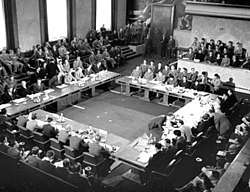
At the 1954 Geneva peace conference, Vietnam was temporarily partitioned at the 17th parallel. Ho Chi Minh had wished to continue the war in the south, but was restrained by his Chinese allies who convinced him that he could win control by electoral means.[78][32]:87–8 Under the terms of the Geneva Accords, civilians were allowed to move freely between the two provisional states for a 300-day period. Elections throughout the country were to be held in 1956 to establish a unified government.[32]:88–90 Around one million northerners, mainly minority Catholics, fled south, fearing persecution by the communists.[32]:96[79] This followed an American psychological warfare campaign, designed by Edward Lansdale for the Central Intelligence Agency (CIA), which exaggerated anti-Catholic sentiment among the Viet Minh and which falsely claimed the US was about to drop atomic bombs on Hanoi.[80][81][32]:96–7 The exodus was coordinated by a U.S.-funded $93 million relocation program, which included the use of the Seventh Fleet to ferry refugees.[82] The northern, mainly Catholic refugees gave the later Ngô Đình Diệm regime a strong anti-communist constituency.[83]:238 Diệm staffed his government's key posts mostly with northern and central Catholics.
In addition to the Catholics flowing south, up to 174,000 "Revolutionary Regroupees" and their 86,000 dependents went to the north for "regroupment", expecting to return to the south within two years.[66]:98 The Viet Minh left roughly 5,000 to 10,000 cadres in the south as a base for future insurgency.[32]:104 The last French soldiers left South Vietnam in April 1956.[32]:116 The PRC completed its withdrawal from North Vietnam at around the same time.[62]:14
Between 1953 and 1956, the North Vietnamese government instituted various agrarian reforms, including "rent reduction" and "land reform", which resulted in significant political oppression. During the land reform, testimony from North Vietnamese witnesses suggested a ratio of one execution for every 160 village residents, which extrapolated nationwide would indicate nearly 100,000 executions. Because the campaign was concentrated mainly in the Red River Delta area, a lower estimate of 50,000 executions became widely accepted by scholars at the time.[84]:143[85][86]:569[87] However, declassified documents from the Vietnamese and Hungarian archives indicate that the number of executions was much lower than reported at the time, although likely greater than 13,500.[88] In 1956, leaders in Hanoi admitted to "excesses" in implementing this program and restored a large amount of the land to the original owners.[32]:99–100
The south, meanwhile, constituted the State of Vietnam, with Bảo Đại as Emperor and Ngô Đình Diệm (appointed in July 1954) as his prime minister. Neither the United States government nor Ngô Đình Diệm's State of Vietnam signed anything at the 1954 Geneva Conference. With respect to the question of reunification, the non-communist Vietnamese delegation objected strenuously to any division of Vietnam, but lost out when the French accepted the proposal of Viet Minh delegate Phạm Văn Đồng,[89]:134 who proposed that Vietnam eventually be united by elections under the supervision of "local commissions".[89]:119 The United States countered with what became known as the "American Plan", with the support of South Vietnam and the United Kingdom.[89]:140 It provided for unification elections under the supervision of the United Nations, but was rejected by the Soviet delegation.[89]:140 The United States said, "With respect to the statement made by the representative of the State of Vietnam, the United States reiterates its traditional position that peoples are entitled to determine their own future and that it will not join in any arrangement which would hinder this".[89]:570–1 U.S. President Dwight D. Eisenhower wrote in 1954:
"I have never talked or corresponded with a person knowledgeable in Indochinese affairs who did not agree that had elections been held as of the time of the fighting, possibly eighty percent of the population would have voted for the Communist Ho Chi Minh as their leader rather than Chief of State Bảo Đại. Indeed, the lack of leadership and drive on the part of Bảo Đại was a factor in the feeling prevalent among Vietnamese that they had nothing to fight for."[90]
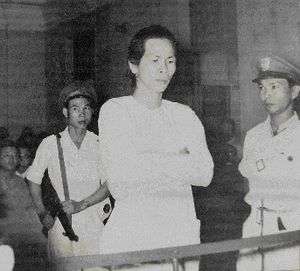
According to the Pentagon Papers, however, from 1954 to 1956 "Ngô Đình Diệm really did accomplish miracles" in South Vietnam: "It is almost certain that by 1956 the proportion which might have voted for Ho—in a free election against Diệm—would have been much smaller than eighty percent."[91] In 1957, independent observers from India, Poland, and Canada representing the International Control Commission (ICC) stated that fair, unbiased elections were not possible, with the ICC reporting that neither South nor North Vietnam had honored the armistice agreement.[92]
From April to June 1955, Diệm eliminated any political opposition in the south by launching military operations against two religious groups: the Cao Đài and Hòa Hảo of Ba Cụt. The campaign also focused on the Bình Xuyên organized crime group, which was allied with members of the communist party secret police and had some military elements. As broad-based opposition to his harsh tactics mounted, Diệm increasingly sought to blame the communists.[17]:
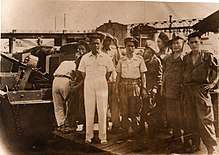
In a referendum on the future of the State of Vietnam on 23 October 1955, Diệm rigged the poll supervised by his brother Ngô Đình Nhu and was credited with 98.2 percent of the vote, including 133% in Saigon. His American advisors had recommended a more modest winning margin of "60 to 70 percent." Diệm, however, viewed the election as a test of authority.[83]:224 Three days later, he declared South Vietnam to be an independent state under the name Republic of Vietnam (ROV), with himself as president.[32]: Likewise, Ho Chi Minh and other communist officials always won at least 99% of the vote in North Vietnamese "elections".[84]:193–94, 202–03, 215–17
The domino theory, which argued that if one country fell to communism, then all of the surrounding countries would follow, was first proposed as policy by the Eisenhower administration.[73]:19 John F. Kennedy, then a U.S. senator, said in a speech to the American Friends of Vietnam: "Burma, Thailand, India, Japan, the Philippines and obviously Laos and Cambodia are among those whose security would be threatened if the Red Tide of Communism overflowed into Vietnam."[93]
Diệm era, 1954–1963
Rule
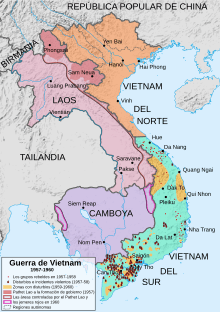
A devout Roman Catholic, Diệm was fervently anti-communist, nationalist, and socially conservative. Historian Luu Doan Huynh notes that "Diệm represented narrow and extremist nationalism coupled with autocracy and nepotism."[73]:200–1 Most Vietnamese people were Buddhist, and they were alarmed by Diệm's actions, like his dedication of the country to the Virgin Mary.
Beginning in the summer of 1955, Diệm launched the "Denounce the Communists" campaign, during which suspected communists and other anti-government elements were arrested, imprisoned, tortured, or executed. He instituted the death penalty against any activity deemed communist in August 1956.[94] About 12,000 suspected opponents of Diệm were killed between 1955 and 1957, and by the end of 1958, an estimated 40,000 political prisoners had been jailed.[66]:89
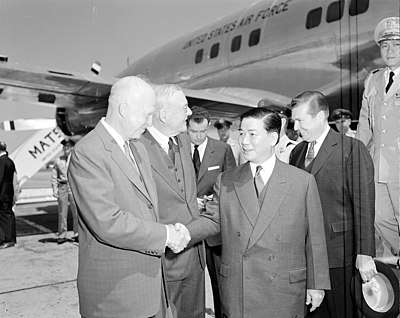
In May 1957, Diệm undertook a ten-day state visit to the United States. President Eisenhower pledged his continued support, and a parade was held in Diệm's honor in New York City. Although Diệm was publicly praised, Secretary of State John Foster Dulles privately conceded that Diệm had been selected because they could find no better alternative.[83]:230
Insurgency in the South, 1954–1960
Between 1954 and 1957, the Diệm government succeeded in quelling large-scale, disorganized dissidence in the countryside. In early 1957, South Vietnam enjoyed its first peace in over a decade. Incidents of political violence began to occur in mid-1957, but the government "did not construe it as a campaign, considering the disorders too diffuse to warrant committing major GVN [Government of Vietnam] resources." By early 1959, however, Diệm had come to regard the (increasingly frequent) disorders as an organized campaign and implemented Law 10/59, which made political violence punishable by death and property confiscation.[95] There had been some division among former Viet Minh whose main goal was to hold the elections promised in the Geneva Accords, leading to "wildcat" activities separate from the other communists and anti-GVN activists.[4]
In December 1960, the Viet Cong was formally created with the intent of uniting all anti-GVN activists, including non-communists. It was formed in Memot, Cambodia, and directed through a central office known as COSVN. According to the Pentagon Papers, the Viet Cong "placed heavy emphasis on the withdrawal of American advisors and influence, on land reform and liberalization of the GVN, on coalition government and the neutralization of Vietnam." The identities of the leaders of the organization often were kept secret.[4]
Support for the VC was driven by peasant resentment of Diem's reversal of land reforms in the countryside. Most of the population lived in countryside villages and strongly supported the reforms. In areas they controlled, the Viet Minh had confiscated large private landholdings, reduced rents and debts, and leased communal lands, mostly to the poorer peasants. Diem brought the landlords back to the villages. People who were farming land they had held for years now had to return it to landlords and pay years of back rent. This rent collection was enforced by the South Vietnamese army. The divisions within villages reproduced those that had existed against the French: "75 percent support for the NLF, 20 percent trying to remain neutral and 5 percent firmly pro-government".[96]:73
North Vietnamese involvement
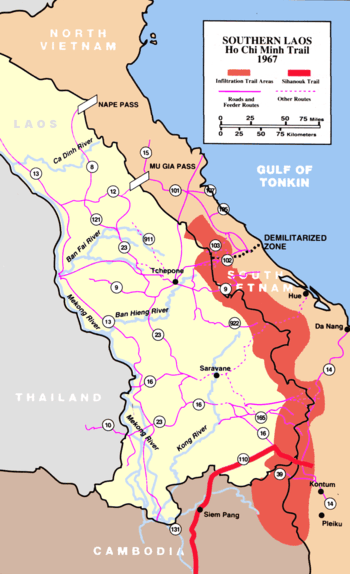
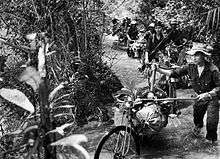
In March 1956, southern communist leader Lê Duẩn presented a plan to revive the insurgency entitled "The Road to the South" to the other members of the Politburo in Hanoi; however, as both China and the Soviets opposed confrontation at this time, Lê Duẩn's plan was rejected.[62]:58 Despite this, the North Vietnamese leadership approved tentative measures to revive the southern insurgency in December 1956.[3]
This decision was made at the 11th Plenary Session of the Lao Dong Central Committee. Communist forces were under a single command structure set up in 1958.[11]:68 The North Vietnamese Communist Party approved a "people's war" on the South at a session in January 1959,[32]:119–20 and, in May, Group 559 was established to maintain and upgrade the Ho Chi Minh trail, at this time a six-month mountain trek through Laos. About 500 of the "regroupees" of 1954 were sent south on the trail during its first year of operation.[11]:xi The first arms delivery via the trail was completed in August 1959.[97] About 40,000 communist soldiers infiltrated the south from 1961 to 1963.[62]:76
Kennedy's escalation, 1961–1963
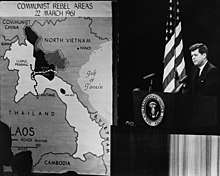
In the 1960 U.S. presidential election, Senator John F. Kennedy defeated incumbent Vice President Richard M. Nixon. Although Eisenhower warned Kennedy about Laos and Vietnam, Europe and Latin America "loomed larger than Asia on his sights."[83]:264 In June 1961, he bitterly disagreed with Soviet premier Nikita Khrushchev when they met in Vienna to discuss key U.S.–Soviet issues. Only 16 months later, the Cuban Missile Crisis (16–28 October 1962) played out on television worldwide. It was the closest the Cold War came to escalating into a full-scale nuclear war, and the U.S. raised the readiness level of Strategic Air Command (SAC) forces to DEFCON 2.
The Kennedy administration remained essentially committed to the Cold War foreign policy inherited from the Truman and Eisenhower administrations. In 1961, the U.S. had 50,000 troops based in South Korea, and Kennedy faced four crisis situations: the failure of the Bay of Pigs Invasion that he had approved on 4 April,[98] settlement negotiations between the pro-Western government of Laos and the Pathet Lao communist movement in May ("Kennedy sidestepped Laos, whose rugged terrain was no battleground for American soldiers."[83]:265), the construction of the Berlin Wall in August, and the Cuban Missile Crisis in October. Kennedy believed that yet another failure to gain control and stop communist expansion would irreparably damage U.S. credibility. He was determined to "draw a line in the sand" and prevent a communist victory in Vietnam. He told James Reston of The New York Times immediately after his Vienna summit meeting with Khrushchev, "Now we have a problem making our power credible and Vietnam looks like the place."[99][100]
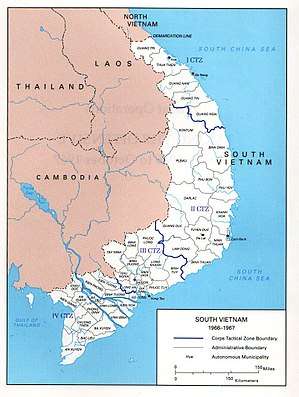
Kennedy's policy toward South Vietnam assumed that Diệm and his forces had to ultimately defeat the guerrillas on their own. He was against the deployment of American combat troops and observed that "to introduce U.S. forces in large numbers there today, while it might have an initially favorable military impact, would almost certainly lead to adverse political and, in the long run, adverse military consequences."[101] The quality of the South Vietnamese military, however, remained poor. Poor leadership, corruption, and political promotions all played a part in weakening the ARVN. The frequency of guerrilla attacks rose as the insurgency gathered steam. While Hanoi's support for the Viet Cong played a role, South Vietnamese governmental incompetence was at the core of the crisis.[73]:369
One major issue Kennedy raised was whether the Soviet space and missile programs had surpassed those of the United States. Although Kennedy stressed long-range missile parity with the Soviets, he was also interested in using special forces for counterinsurgency warfare in Third World countries threatened by communist insurgencies. Although they were originally intended for use behind front lines after a conventional Soviet invasion of Europe, Kennedy believed that the guerrilla tactics employed by special forces such as the Green Berets would be effective in a "brush fire" war in Vietnam.
Kennedy advisors Maxwell Taylor and Walt Rostow recommended that U.S. troops be sent to South Vietnam disguised as flood relief workers.[102] Kennedy rejected the idea but increased military assistance yet again. In April 1962, John Kenneth Galbraith warned Kennedy of the "danger we shall replace the French as a colonial force in the area and bleed as the French did."[103] By November 1963, 16,000 American military personnel were stationed in South Vietnam.[32]:131
The Strategic Hamlet Program was initiated in late 1961. This joint U.S.–South Vietnamese program attempted to resettle the rural population into fortified camps. It was implemented in early 1962 and involved some forced relocation, village internment, and segregation of rural South Vietnamese into new communities where the peasantry would be isolated from the Viet Cong. It was hoped these new communities would provide security for the peasants and strengthen the tie between them and the central government. However, by November 1963 the program had waned, and it officially ended in 1964.[17]:1070
On 23 July 1962, fourteen nations, including China, South Vietnam, the Soviet Union, North Vietnam and the United States, signed an agreement promising to respect the neutrality of Laos.
Ousting and assassination of Ngô Đình Diệm
The inept performance of the ARVN was exemplified by failed actions such as the Battle of Ap Bac on 2 January 1963, in which a small band of Viet Cong won a battle against a much larger and better-equipped South Vietnamese force, many of whose officers seemed reluctant even to engage in combat.[104]:201–6 During the battle the South Vietnamese had lost 83 soldiers, 5 US war helicopters that had been shot down by Vietcong forces, while the Vietcong forces had lost only 18 soldiers. The ARVN forces were led by Diệm's most trusted general, Huỳnh Văn Cao, commander of the IV Corps. Cao was a Catholic who had been promoted due to religion and fidelity rather than skill, and his main job was to preserve his forces to stave off coup attempts; he had earlier vomited during a communist attack. Some policymakers in Washington began to conclude that Diệm was incapable of defeating the communists and might even make a deal with Ho Chi Minh. He seemed concerned only with fending off coups and had become more paranoid after attempts in 1960 and 1962, which he partly attributed to U.S. encouragement. As Robert F. Kennedy noted, "Diệm wouldn't make even the slightest concessions. He was difficult to reason with ..."[105] Historian James Gibson summed up the situation:
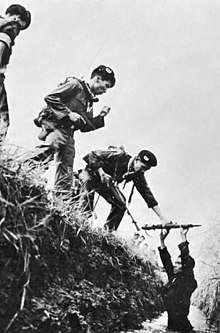
Strategic hamlets had failed ... The South Vietnamese regime was incapable of winning the peasantry because of its class base among landlords. Indeed, there was no longer a 'regime' in the sense of a relatively stable political alliance and functioning bureaucracy. Instead, civil government and military operations had virtually ceased. The National Liberation Front had made great progress and was close to declaring provisional revolutionary governments in large areas.[106]
Discontent with Diệm's policies exploded in May 1963 following the Huế Phật Đản shootings of nine unarmed Buddhists protesting against the ban on displaying the Buddhist flag on Vesak, the Buddha's birthday. This resulted in mass protests against discriminatory policies that gave privileges to the Catholic Church and its adherents over the Buddhist majority. Diệm's elder brother Ngô Đình Thục was the Archbishop of Huế and aggressively blurred the separation between church and state. Thuc's anniversary celebrations shortly before Vesak had been bankrolled by the government, and Vatican flags were displayed prominently. There had also been reports of Catholic paramilitaries demolishing Buddhist pagodas throughout Diệm's rule. Diệm refused to make concessions to the Buddhist majority or take responsibility for the deaths. On 21 August 1963, the ARVN Special Forces of Colonel Lê Quang Tung, loyal to Diệm's younger brother Ngô Đình Nhu, raided pagodas across Vietnam, causing widespread damage and destruction and leaving a death toll estimated to range into the hundreds.
U.S. officials began discussing the possibility of a regime change during the middle of 1963. The United States Department of State wanted to encourage a coup, while the Defense Department favored Diệm. Chief among the proposed changes was the removal of Diệm's younger brother Nhu, who controlled the secret police and special forces, and was seen as the man behind the Buddhist repression and more generally the architect of the Ngô family's rule. This proposal was conveyed to the U.S. embassy in Saigon in Cable 243.
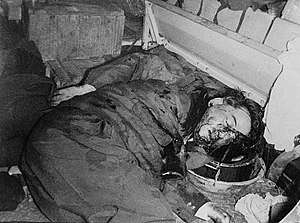
The CIA contacted generals planning to remove Diệm and told them that the United States would not oppose such a move nor punish the generals by cutting off aid. President Diệm was overthrown and executed, along with his brother, on 2 November 1963. When Kennedy was informed, Maxwell Taylor remembered that he "rushed from the room with a look of shock and dismay on his face."[83]:326 Kennedy had not anticipated Diệm's murder. The U.S. ambassador to South Vietnam, Henry Cabot Lodge, invited the coup leaders to the embassy and congratulated them. Ambassador Lodge informed Kennedy that "the prospects now are for a shorter war".[83]:327 Kennedy wrote Lodge a letter congratulating him for "a fine job".[107]
Following the coup, chaos ensued. Hanoi took advantage of the situation and increased its support for the guerrillas. South Vietnam entered a period of extreme political instability, as one military government toppled another in quick succession. Increasingly, each new regime was viewed by the communists as a puppet of the Americans; whatever the failings of Diệm, his credentials as a nationalist (as Robert McNamara later reflected) had been impeccable.[73]:328
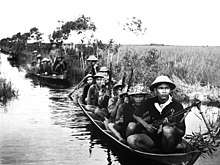
U.S. military advisors were embedded at every level of the South Vietnamese armed forces. They were however criticized for ignoring the political nature of the insurgency.[108] The Kennedy administration sought to refocus U.S. efforts on pacification- which in this case was defined as countering the growing threat of insurgency- [109][110] and "winning over the hearts and minds" of the population. The military leadership in Washington, however, was hostile to any role for U.S. advisors other than conventional troop training.[111] General Paul Harkins, the commander of U.S. forces in South Vietnam, confidently predicted victory by Christmas 1963.[75]:103 The CIA was less optimistic, however, warning that "the Viet Cong by and large retain de facto control of much of the countryside and have steadily increased the overall intensity of the effort".[112]
Paramilitary officers from the CIA's Special Activities Division trained and led Hmong tribesmen in Laos and into Vietnam. The indigenous forces numbered in the tens of thousands and they conducted direct action missions, led by paramilitary officers, against the Communist Pathet Lao forces and their North Vietnamese supporters.[113] The CIA also ran the Phoenix Program and participated in Military Assistance Command, Vietnam – Studies and Observations Group (MAC-V SOG), which was originally named the Special Operations Group, but was changed for cover purposes.[114]
Johnson's escalation, 1963–1969
President Kennedy was assassinated on 22 November 1963. Vice President Lyndon B. Johnson had not been heavily involved with policy toward Vietnam;[115][116] however, upon becoming president, Johnson immediately focused on the war. On 24 November 1963, he said, "the battle against communism ... must be joined ... with strength and determination."[117] Johnson knew he had inherited a rapidly deteriorating situation in South Vietnam,[118] but he adhered to the widely accepted domino theory argument for defending the South: Should they retreat or appease, either action would imperil other nations beyond the conflict.[119]
The military revolutionary council, meeting in lieu of a strong South Vietnamese leader, was made up of 12 members. This council was headed by General Dương Văn Minh, whom Stanley Karnow, a journalist on the ground, later recalled as "a model of lethargy".[83]:340 Lodge, frustrated by the end of the year, cabled home about Minh: "Will he be strong enough to get on top of things?" Minh's regime was overthrown in January 1964 by General Nguyễn Khánh.[83]:341 There was also persistent instability in the military, however, as several coups—not all successful—occurred in a short period of time.
In a statement similar to that made to the French almost two decades earlier, Ho Chi Minh warned that if the Americans "want to make war for twenty years then we shall make war for twenty years. If they want to make peace, we shall make peace and invite them to afternoon tea."[96]:172 Some have argued that the policy of North Vietnam was not to topple other non-communist governments in South East Asia.[73]:48
Gulf of Tonkin incident
On 2 August 1964, USS Maddox, on an intelligence mission along North Vietnam's coast, allegedly fired upon and damaged several torpedo boats that had been stalking it in the Gulf of Tonkin.[66]:124 A second attack was reported two days later on USS Turner Joy and Maddox in the same area. The circumstances of the attacks were murky.[32]:218–9 Lyndon Johnson commented to Undersecretary of State George Ball that "those sailors out there may have been shooting at flying fish."[120]
An undated NSA publication declassified in 2005 revealed that there was no attack on 4 August.[121]
The second "attack" led to retaliatory airstrikes, and prompted Congress to approve the Gulf of Tonkin Resolution on 7 August 1964.[122]:78 The resolution granted the president power "to take all necessary measures to repel any armed attack against the forces of the United States and to prevent further aggression" and Johnson would rely on this as giving him authority to expand the war.[32]:221 In the same month, Johnson pledged that he was not "committing American boys to fighting a war that I think ought to be fought by the boys of Asia to help protect their own land".[32]:227
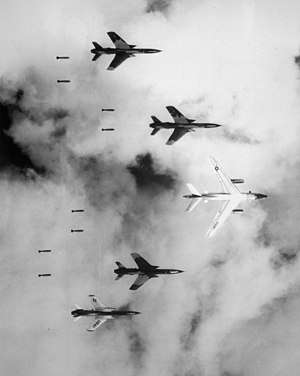
The National Security Council recommended a three-stage escalation of the bombing of North Vietnam. Following an attack on a U.S. Army base in Pleiku on 7 February 1965,[123] a series of airstrikes was initiated, Operation Flaming Dart, while Soviet Premier Alexei Kosygin was on a state visit to North Vietnam. Operation Rolling Thunder and Operation Arc Light expanded aerial bombardment and ground support operations.[124] The bombing campaign, which ultimately lasted three years, was intended to force North Vietnam to cease its support for the Viet Cong by threatening to destroy North Vietnamese air defenses and industrial infrastructure. It was additionally aimed at bolstering the morale of the South Vietnamese.[125] Between March 1965 and November 1968, Rolling Thunder deluged the north with a million tons of missiles, rockets and bombs.[83]:468
Bombing of Laos
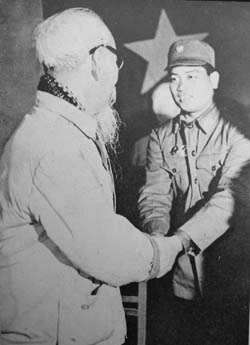
Bombing was not restricted to North Vietnam. Other aerial campaigns, such as Operation Barrel Roll, targeted different parts of the Viet Cong and PAVN infrastructure. These included the Ho Chi Minh trail supply route, which ran through Laos and Cambodia. The ostensibly neutral Laos had become the scene of a civil war, pitting the Laotian government backed by the US against the Pathet Lao and its North Vietnamese allies.
Massive aerial bombardment against the Pathet Lao and PAVN forces were carried out by the US to prevent the collapse of the Royal central government, and to deny the use of the Ho Chi Minh Trail. Between 1964 and 1973, the U.S. dropped two million tons of bombs on Laos, nearly equal to the 2.1 million tons of bombs the U.S. dropped on Europe and Asia during all of World War II, making Laos the most heavily bombed country in history relative to the size of its population.[126]
The objective of stopping North Vietnam and the Viet Cong was never reached. The Chief of Staff of the United States Air Force Curtis LeMay, however, had long advocated saturation bombing in Vietnam and wrote of the communists that "we're going to bomb them back into the Stone Age".[32]:328
The 1964 Offensive
Following the Gulf of Tonkin Resolution, Hanoi anticipated the arrival of US troops and began expanding the Viet Cong, as well as sending increasing numbers of North Vietnamese personnel southwards. At this phase they were outfitting the Viet Cong forces and standardising their equipment with AK-47 rifles and other supplies, as well as forming the 9th Division.[32]:223[127] "From a strength of approximately 5,000 at the start of 1959 the Viet Cong's ranks grew to about 100,000 at the end of 1964 ... Between 1961 and 1964 the Army's strength rose from about 850,000 to nearly a million men."[108] The numbers for U.S. troops deployed to Vietnam during the same period were much lower: 2,000 in 1961, rising rapidly to 16,500 in 1964.[128] During this phase, the use of captured equipment decreased, while greater numbers of ammunition and supplies were required to maintain regular units. Group 559 was tasked with expanding the Ho Chi Minh trail, in light of the near constant bombardment by US warplanes. The war had begun to shift into the final, conventional warfare phase of Hanoi's three-stage protracted warfare model. The Viet Cong was now tasked with destroying the ARVN and capturing and holding areas; however, the Viet Cong was not yet strong enough to assault major towns and cities.
In December 1964, ARVN forces had suffered heavy losses at the Battle of Bình Giã,[129] in a battle that both sides viewed as a watershed. Previously, the VC had utilised hit-and-run guerrilla tactics. At Binh Gia, however, they had defeated a strong ARVN force in a conventional battle and remained in the field for four days.[130]:58 Tellingly, South Vietnamese forces were again defeated in June 1965 at the Battle of Đồng Xoài.[130]:94
American ground war
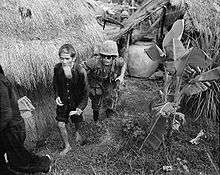
On 8 March 1965, 3,500 U.S. Marines were landed near Da Nang, South Vietnam.[32]:246–7 This marked the beginning of the American ground war. U.S. public opinion overwhelmingly supported the deployment.[131] The Marines' initial assignment was the defense of Da Nang Air Base. The first deployment of 3,500 in March 1965 was increased to nearly 200,000 by December.[73]:349–51 The U.S. military had long been schooled in offensive warfare. Regardless of political policies, U.S. commanders were institutionally and psychologically unsuited to a defensive mission.[73]:349–51
General William Westmoreland informed Admiral U. S. Grant Sharp Jr., commander of U.S. Pacific forces, that the situation was critical.[73]:349–51 He said, "I am convinced that U.S. troops with their energy, mobility, and firepower can successfully take the fight to the NLF (Viet Cong)".[132] With this recommendation, Westmoreland was advocating an aggressive departure from America's defensive posture and the sidelining of the South Vietnamese. By ignoring ARVN units, the U.S. commitment became open-ended.[73]:353 Westmoreland outlined a three-point plan to win the war:
- Phase 1. Commitment of U.S. (and other free world) forces necessary to halt the losing trend by the end of 1965.
- Phase 2. U.S. and allied forces mount major offensive actions to seize the initiative to destroy guerrilla and organized enemy forces. This phase would end when the enemy had been worn down, thrown on the defensive, and driven back from major populated areas.
- Phase 3. If the enemy persisted, a period of twelve to eighteen months following Phase 2 would be required for the final destruction of enemy forces remaining in remote base areas.[133]
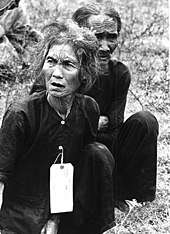
The plan was approved by Johnson and marked a profound departure from the previous administration's insistence that the government of South Vietnam was responsible for defeating the guerrillas. Westmoreland predicted victory by the end of 1967.[134] Johnson did not, however, communicate this change in strategy to the media. Instead he emphasized continuity.[135] The change in U.S. policy depended on matching the North Vietnamese and the Viet Cong in a contest of attrition and morale. The opponents were locked in a cycle of escalation.[73]:353–4 The idea that the government of South Vietnam could manage its own affairs was shelved.[73]:353–4 Westmoreland and McNamara furthermore touted the body count system for gauging victory, a metric that would later prove to be flawed.[136]
The American buildup transformed the South Vietnamese economy and had a profound effect on society. South Vietnam was inundated with manufactured goods. Stanley Karnow noted that "the main PX [Post Exchange], located in the Saigon suburb of Cholon, was only slightly smaller than the New York Bloomingdale's ..."[83]:453 A huge surge in corruption was witnessed. Meanwhile, the one-year tour of duty of American soldiers deprived units of experienced leadership. As one observer noted "we were not in Vietnam for 10 years, but for one year 10 times."[137] As a result, training programs were shortened.
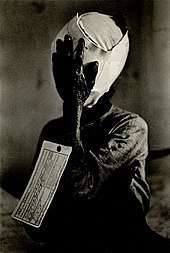
Washington encouraged its SEATO allies to contribute troops. Australia, New Zealand, Thailand and the Philippines[83]:556 all agreed to send troops. South Korea would later ask to join the Many Flags program in return for economic compensation. Major allies, however, notably NATO nations Canada and the United Kingdom, declined Washington's troop requests.[138]
The U.S. and its allies mounted complex search and destroy operations, designed to find enemy forces, destroy them, and then withdraw, typically using helicopters. In November 1965, the U.S. engaged in its first major battle with the PAVN, the Battle of Ia Drang.[139] The operation was the first large scale helicopter air assault by the U.S., and first to employ Boeing B-52 Stratofortress strategic bombers in a tactical support role.[32]:284–5 These tactics continued in 1966–1967 with operations such as Masher, Thayer, Attleboro, Cedar Falls and Junction City. However, the PAVN/VC insurgents remained elusive and demonstrated great tactical flexibility. By 1967, these operations had generated large-scale internal refugees, numbering nearly 2.1 million in South Vietnam, with 125,000 people evacuated and rendered homeless during Operation Masher alone, which was the largest search and destroy operation in the war up to that point.[140] Operation Masher would have negligible impact, however, as the PAVN/VC returned to the province just four months after the operation ended.[141]:153–6 Despite the continual conductance of major operations, which the Viet Cong and PAVN would typically evade, the war was characterised by smaller-unit contacts or engagements.[142] Up to the war's end, the Viet Cong and PAVN would initiate 90% of large firefights, of which 80% were clear and well-planned operations, and thus the PAVN/Viet Cong would retain strategic initiative despite overwhelming US force and fire-power deployment.[142] The PAVN/Viet Cong had furthermore developed strategies capable of countering U.S. military doctrines and tactics (see NLF and PAVN battle tactics).
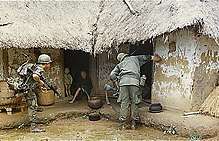
Meanwhile, the political situation in South Vietnam began to stabilise with the coming to power of prime minister Air Marshal Nguyễn Cao Kỳ and figurehead chief of state, General Nguyễn Văn Thiệu, in mid-1965 at the head of a military junta. This ended a series of coups that had happened more than once a year. In 1967, Thieu became president with Ky as his deputy, after rigged elections. Although they were nominally a civilian government, Ky was supposed to maintain real power through a behind-the-scenes military body. However, Thieu outmanoeuvred and sidelined Ky by filling the ranks with generals from his faction. Thieu was also accused of murdering Ky loyalists through contrived military accidents. Thieu, mistrustful and indecisive, remained president until 1975, having won a one-candidate election in 1971.[83]:706
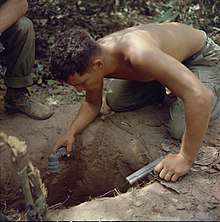
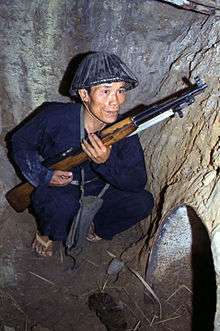
The Johnson administration employed a "policy of minimum candor"[83]:18 in its dealings with the media. Military information officers sought to manage media coverage by emphasizing stories that portrayed progress in the war. Over time, this policy damaged the public trust in official pronouncements. As the media's coverage of the war and that of the Pentagon diverged, a so-called credibility gap developed.[83]:18 Despite Johnson and Westmoreland publicly proclaiming victory and Westmoreland stating that the "end is coming into view",[143] internal reports in the Pentagon Papers indicate that Viet Cong forces retained strategic initiative and controlled their losses. Viet Cong attacks against static US positions accounted for 30% of all engagements, VC/PAVN ambushes and encirclements for 23%, American ambushes against Viet Cong/PAVN forces for 9%, and American forces attacking Viet Cong emplacements for only 5% of all engagements.[142]
| TYPE OF ENGAGEMENTS IN COMBAT NARRATIVES | Percentage of
Total Engagements |
Notes |
|---|---|---|
| Hot Landing Zone. VC/PAVN Attacks U.S. Troops As They Deploy | 12.5% | Planned VC/PAVN Attacks
Are 66.2% Of All Engagements |
| Planned VC/PAVN Attack Against US Defensive Perimeter | 30.4% | |
| VC/PAVN Ambushes or Encircles A Moving US Unit | 23.3% | |
| Unplanned US Attacks On A VC/PAVN Defensive Perimeter,
Engagement A Virtual Surprise To US Commanders |
12.5% | Defensive Posts Being Well Concealed
or VC/PAVN Alerted or Anticipated |
| Planned US Attack Against Known
VC/PAVN Defensive Perimeter |
5.4% | Planned US Attacks Against
VC/PAVN Represent 14.3% Of All Engagements |
| US Forces Ambushes Moving VC/PAVN Units | 8.9% | |
| Chance Engagement, Neither Side Planned | 7.1% |
Tet Offensive
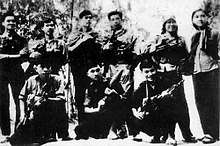
In late 1967, the PAVN lured American forces into the hinterlands at Đắk Tô and at the Marine Khe Sanh combat base in Quảng Trị Province, where the U.S. fought a series of battles known as The Hill Fights. These actions were part of a diversionary strategy meant to draw US forces towards the Central Highlands.[144] Preparations were underway for the General Offensive, General Uprising, known as Tet Mau Than, or the Tet Offensive, with the intention of Văn Tiến Dũng for forces to launch "direct attacks on the American and puppet nerve centers—Saigon, Huế, Danang, all the cities, towns and main bases..."[145] Le Duan sought to placate critics of the ongoing stalemate by planning a decisive victory.[146]:90–4 He reasoned that this could be achieved through sparking a general uprising within the towns and cities,[146]:148 along with mass defections among ARVN units, who were on holiday leave during the truce period.[147]
The Tet Offensive began on 30 January 1968, as over 100 cities were attacked by over 85,000 VC/PAVN troops, including assaults on key military installations, headquarters, and government buildings and offices, including the U.S. Embassy in Saigon.[73]:363–5 U.S. and South Vietnamese forces were initially shocked by the scale, intensity and deliberative planning of the urban offensive, as infiltration of personnel and weapons into the cities was accomplished covertly;[145] the offensive constituted an intelligence failure on the scale of Pearl Harbor.[83]:556 Most cities were recaptured within weeks, except the former imperial capital of Huế in which PAVN/Viet Cong troops captured most of the city and citadel except the headquarters of the 1st Division and held on in the fighting for 26 days.[148]:495 During that time, they had executed approximately 2,800 unarmed Huế civilians and foreigners they considered to be enemy's spies.[149][148]:495 In the following Battle of Huế American forces employed massive firepower that left 80 percent of the city in ruins.[66]:308–9 Further north, at Quảng Trị City, the ARVN Airborne Division, the 1st Division and a regiment of the US 1st Cavalry Division had managed to hold out and overcome an assault intended to capture the city.[150]:[151]:104 In Saigon, Viet Cong/PAVN fighters had captured areas in and around the city, attacking key installations and the neighbourhood of Cholon before US and ARVN forces dislodged them after three weeks.[32]:479 During one battle, Peter Arnett reported an infantry commander saying of the Battle of Bến Tre (laid to rubble by U.S. attacks) that "it became necessary to destroy the village in order to save it."[152][153]
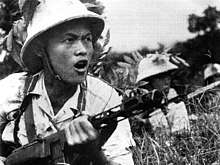
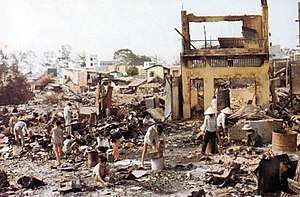
During the first month of the offensive, 1,100 Americans and other allied troops, 2,100 ARVN and 14,000 civilians were killed.[154] By the end of the first offensive, after two months, nearly 5,000 ARVN and over 4,000 U.S. forces had been killed and 45,820 wounded.[154] The U.S. claimed 17,000 of the PAVN and Viet Cong had been killed and 15,000 wounded.[151]:104[150]:82 A month later a second offensive known as the May Offensive was launched; although less widespread, it demonstrated the Viet Cong were still capable of carrying out orchestrated nationwide offensives.[32]:488–9 Two months later a third offensive was launched, the Phase III Offensive. The PAVN's own official records of their losses across all three offensives was 45,267 killed and 111,179 total casualties.[155][156] By then it had become the bloodiest year of the war up to that point. The failure to spark a general uprising and the lack of defections among the ARVN units meant both war goals of Hanoi had fallen flat at enormous costs.[146]:148–9
Prior to Tet, in November 1967, Westmoreland had spearheaded a public relations drive for the Johnson administration to bolster flagging public support.[157] In a speech before the National Press Club he said a point in the war had been reached "where the end comes into view."[158] Thus, the public was shocked and confused when Westmoreland's predictions were trumped by the Tet Offensive.[157] Public approval of his overall performance dropped from 48 percent to 36 percent, and endorsement for the war effort fell from 40 percent to 26 percent."[83]:546 The American public and media began to turn against Johnson as the three offensives contradicted claims of progress made by the Johnson administration and the military.[157]
At one point in 1968, Westmoreland considered the use of nuclear weapons in Vietnam in a contingency plan codenamed Fracture Jaw, which was abandoned when it became known to the White House.[159] Westmoreland requested 200,000 additional troops, which was leaked to the media, and the subsequent fallout combined with intelligence failures caused him to be removed from command in March 1968, succeeded by his deputy Creighton Abrams.[160]
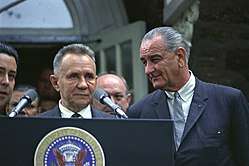
On 10 May 1968, peace talks began between the United States and North Vietnam in Paris. Negotiations stagnated for five months, until Johnson gave orders to halt the bombing of North Vietnam. At the same time, Hanoi realized it could not achieve a "total victory" and employed a strategy known as "talking while fighting, fighting while talking", in which military offensives would occur concurrently with negotiations.[161]
Johnson declined to run for re-election as his approval rating slumped from 48 to 36 percent.[32]:486 His escalation of the war in Vietnam divided Americans into warring camps, cost 30,000 American lives by that point and was regarded to have destroyed his presidency.[32]:486 Refusal to send more U.S. troops to Vietnam was also seen as Johnson's admission that the war was lost.[162] As Secretary of Defense Robert McNamara noted, "the dangerous illusion of victory by the United States was therefore dead."[73]:367
Vietnam was a major political issue during the United States presidential election in 1968. The election was won by Republican party candidate Richard Nixon who claimed to have a secret plan to end the war.[32]:515[163]
Vietnamization, 1969–1972
Nuclear threats and diplomacy
U.S. president Richard Nixon began troop withdrawals in 1969. His plan to build up the ARVN so that it could take over the defense of South Vietnam became known as "Vietnamization". As the PAVN/VC recovered from their 1968 losses and generally avoided contact, Creighton Abrams conducted operations aimed at disrupting logistics, with better use of firepower and more cooperation with the ARVN.[32]:517 On 27 October 1969, Nixon had ordered a squadron of 18 B-52s loaded with nuclear weapons to race to the border of Soviet airspace to convince the Soviet Union, in accord with the madman theory, that he was capable of anything to end the Vietnam War.[164][165] Nixon had also sought détente with the Soviet Union and rapprochement with China, which decreased global tensions and led to nuclear arms reduction by both superpowers; however, there was disappointment when both sides continued to supply the North Vietnamese with aid.
Hanoi's war strategy
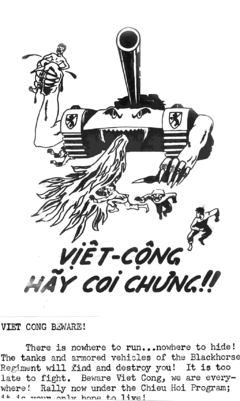
In September 1969, Ho Chi Minh died at age seventy-nine.[166] The failure of Tet in sparking a popular uprising caused a shift in Hanoi's war strategy, and the Giáp-Chinh "Northern-First" faction regained control over military affairs from the Lê Duẩn-Hoàng Văn Thái "Southern-First" faction.[167]:272–4 An unconventional victory was sidelined in favor of a strategy built on conventional victory through conquest.[146]:196–205 Large-scale offensives were rolled back in favour of small-unit and sapper attacks as well as targeting the pacification and Vietnamization strategy.[167] In the two-year period following Tet, the PAVN had begun its transformation from a fine light-infantry, limited mobility force into a high-mobile and mechanised combined arms force.[167]:189
U.S. domestic controversies
The anti-war movement was gaining strength in the United States. Nixon appealed to the "silent majority" of Americans who he said supported the war without showing it in public. But revelations of the 1968 My Lai Massacre,[32]:518–21 in which a U.S. Army unit raped and killed civilians, and the 1969 "Green Beret Affair", where eight Special Forces soldiers, including the 5th Special Forces Group Commander, were arrested for the murder[168] of a suspected double agent,[169] provoked national and international outrage.
In 1971, the Pentagon Papers were leaked to The New York Times. The top-secret history of U.S. involvement in Vietnam, commissioned by the Department of Defense, detailed a long series of public deceptions on the part of the U.S. government. The Supreme Court ruled that its publication was legal.[170]
Collapsing U.S. morale
Following the Tet Offensive and the decreasing support among the U.S. public for the war, U.S. forces began a period of morale collapse, disillusionment and disobedience.[171]:349–50[172]:166–75 At home, desertion rates quadrupled from 1966 levels.[173] Among the enlisted, only 2.5% chose infantry combat positions in 1969–1970.[173] ROTC enrollment decreased from 191,749 in 1966 to 72,459 by 1971,[174] and reached an all-time low of 33,220 in 1974,[175] depriving U.S. forces of much-needed military leadership.
Open refusal to engage in patrols or carry out orders and disobedience began to emerge during this period, with one notable case of an entire company refusing orders to engage or carry out operations.[176] Unit cohesion began to dissipate and focused on minimising contact with Viet Cong and PAVN.[172]: A practice known as "sand-bagging" started occurring, where units ordered to go on patrol would go into the country-side, find a site out of view from superiors and rest while radioing in false coordinates and unit reports.[141]:407–11 Drug usage increased rapidly among U.S. forces during this period, as 30% of U.S. troops regularly used marijuana,[141]:407 while a House subcommittee found 10-15% of U.S. troops in Vietnam regularly used high-grade heroin.[173][32]:526 From 1969 on, search-and-destroy operations became referred to as "search and evade" or "search and avoid" operations, falsifying battle reports while avoiding guerrilla fighters.[177] A total of 900 fragging and suspected fragging incidents were investigated, most occurring between 1969 and 1971.[178]:331[141]:407 In 1969 field-performance of the U.S. Forces was characterised by lowered morale, lack of motivation, and poor leadership.[178]:331 The significant decline in U.S. morale was demonstrated by the Battle of FSB Mary Ann in March 1971, in which a sapper attack inflicted serious losses on the U.S. defenders.[178]:357 William Westmoreland, no longer in command but tasked with investigation of the failure, cited a clear dereliction of duty, lax defensive postures and lack of officers in charge as its cause.[178]:357
On the collapse of U.S. morale, historian Shelby Stanton wrote:
In the last years of the Army's retreat, its remaining forces were relegated to static security. The American Army's decline was readily apparent in this final stage. Racial incidents, drug abuse, combat disobedience, and crime reflected growing idleness, resentment, and frustration... the fatal handicaps of faulty campaign strategy, incomplete wartime preparation, and the tardy, superficial attempts at Vietnamization. An entire American army was sacrificed on the battlefield of Vietnam.[178]:366–8
ARVN taking the lead and U.S. ground-force withdrawal
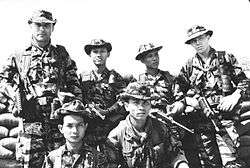
Beginning in 1970, American troops were withdrawn from border areas where most of the fighting took place and instead redeployed along the coast and interior. US casualties in 1970 were less than half of 1969 casualties after being relegated to less active combat.[179] While US forces were redeployed, the ARVN took over combat operations throughout the country, with casualties double US casualties in 1969, and more than triple US ones in 1970.[180] In the post-Tet environment, membership in the South Vietnamese Regional Force and Popular Force militias grew, and they were now more capable of providing village security, which the Americans had not accomplished under Westmoreland.[180]
In 1970 Nixon announced the withdrawal of an additional 150,000 American troops, reducing the number of Americans to 265,500.[179] By 1970 Viet Cong forces were no longer southern-majority, as nearly 70% of units were northerners.[181] Between 1969 and 1971 the Viet Cong and some PAVN units had reverted to small unit tactics typical of 1967 and prior instead of nationwide grand offensives.[146]: In 1971 Australia and New Zealand withdrew their soldiers and U.S. troop count was further reduced to 196,700, with a deadline to remove another 45,000 troops by February 1972. The United States also reduced support troops, and in March 1971 the 5th Special Forces Group, the first American unit deployed to South Vietnam, withdrew to Fort Bragg, North Carolina.[182]:240[A 5]
Cambodia
Prince Norodom Sihanouk had proclaimed Cambodia neutral since 1955,[185] but permitted the PAVN/Viet Cong to use the port of Sihanoukville and the Sihanouk Trail. In March 1969 Nixon launched a massive secret bombing campaign, called Operation Menu, against communist sanctuaries along the Cambodia/Vietnam border. Only five high-ranking congressional officials were informed of Operation Menu.[186]
In March 1970, Prince Sihanouk was deposed by his pro-American prime minister Lon Nol, who demanded that North Vietnamese troops leave Cambodia or face military action.[187] Lon Nol began rounding up Vietnamese civilians in Cambodia into internment camps and massacring them, provoking harsh reactions from both the North Vietnamese and South Vietnamese government.[188] North Vietnam invaded Cambodia at the request of the Khmer Rouge following negotiations with deputy leader Nuon Chea. In April–May 1970, many North Vietnamese forces entered Cambodia in response to the call for help addressed to Vietnam by Nuon Chea. Nguyen Co Thach recalls: "Nuon Chea has asked for help and we have liberated five provinces of Cambodia in ten days."[189] U.S. and ARVN forces launched the Cambodian Campaign to attack PAVN and Viet Cong bases. A counter-offensive later that year as part of Operation Chenla II by the PAVN would recapture most of the border areas and decimate most of Lon Nol's forces.
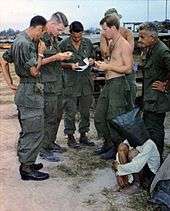
The invasion of Cambodia sparked nationwide U.S. protests as Nixon had promised to deescalate the American involvement. Four students were killed by National Guardsmen in May 1970 during a protest at Kent State University in Ohio, which provoked further public outrage in the United States. The reaction to the incident by the Nixon administration was seen as callous and indifferent, reinvigorating the declining anti-war movement.[172]:128–9 The U.S. Air Force continued to heavily bomb Cambodia in support of the Cambodian government as part of Operation Freedom Deal.
Laos
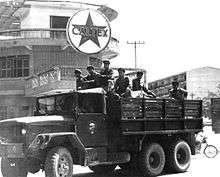
Building up on the success of ARVN units in Cambodia, and further testing the Vietnamization program, the ARVN were tasked to launch Operation Lam Son 719 in February 1971, the first major ground operation aimed directly at attacking the Ho Chi Minh trail by attacking the major crossroad of Tchepone. This offensive would also be the first time the PAVN would field-test its combined arms force.[146]: The first few days were considered a success but the momentum had slowed after fierce resistance. Thiệu had halted the general advance, leaving armoured divisions able to surround them.[190] Thieu had ordered air assault troops to capture Tchepone and withdraw, despite facing four-times larger numbers. During the withdrawal the PAVN counterattack had forced a panicked rout. Half of the ARVN troops involved were either captured or killed, half of the ARVN/US support helicopters were downed by anti-aircraft fire and the operation was considered a fiasco, demonstrating operational deficiencies still present within the ARVN.[83]:644–5 Nixon and Thieu had sought to use this event to show-case victory simply by capturing Tchepone, and it was spun off as an "operational success".[190][32]:576–82
Easter Offensive and Paris Peace Accords, 1972
Vietnamization was again tested by the Easter Offensive of 1972, a massive conventional PAVN invasion of South Vietnam. The PAVN quickly overran the northern provinces and in coordination with other forces attacked from Cambodia, threatening to cut the country in half. U.S. troop withdrawals continued, but American airpower responded, beginning Operation Linebacker, and the offensive was halted.[32]:606–37
.jpg)
The war was central to the 1972 U.S. presidential election as Nixon's opponent, George McGovern, campaigned on immediate withdrawal. Nixon's National Security Advisor, Henry Kissinger, had continued secret negotiations with North Vietnam's Lê Đức Thọ and in October 1972 reached an agreement. President Thieu demanded changes to the peace accord upon its discovery, and when North Vietnam went public with the agreement's details, the Nixon administration claimed they were attempting to embarrass the president. The negotiations became deadlocked when Hanoi demanded new changes. To show his support for South Vietnam and force Hanoi back to the negotiating table, Nixon ordered Operation Linebacker II, a massive bombing of Hanoi and Haiphong 18–29 December 1972.[32]:649–63 Nixon pressured Thieu to accept the terms of the agreement, threatening to conclude a bilateral peace deal and cut off American aid while promising an air-response in case of invasion.
On 15 January 1973, all U.S. combat activities were suspended. Lê Đức Thọ and Henry Kissinger, along with the PRG Foreign Minister Nguyễn Thị Bình and a reluctant President Thiệu, signed the Paris Peace Accords on 27 January 1973.[141]:508–13 This officially ended direct U.S. involvement in the Vietnam War, created a ceasefire between North Vietnam/PRG and South Vietnam, guaranteed the territorial integrity of Vietnam under the Geneva Conference of 1954, called for elections or a political settlement between the PRG and South Vietnam, allowed 200,000 communist troops to remain in the south, and agreed to a POW exchange. There was a sixty-day period for the total withdrawal of U.S. forces. "This article", noted Peter Church, "proved… to be the only one of the Paris Agreements which was fully carried out."[191] All US forces personnel were completely withdrawn by March 1973.[75]:260
U.S. exit and final campaigns, 1973–1975
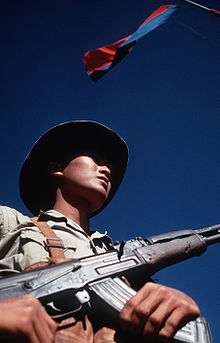
In the lead-up to the ceasefire on 28 January, both sides attempted to maximize the land and population under their control in a campaign known as the War of the flags. Fighting continued after the ceasefire, this time without US participation, and continued throughout the year.[141]:508–13 North Vietnam was allowed to continue supplying troops in the South but only to the extent of replacing expended material. Later that year the Nobel Peace Prize was awarded to Kissinger and Thọ, but the North Vietnamese negotiator declined it saying that a true peace did not yet exist.
On 15 March 1973, Nixon implied the US would intervene again militarily if the North launched a full offensive and Secretary of Defense James Schlesinger re-affirmed this position during his June 1973 confirmation hearings. Public and congressional reaction to Nixon's statement was unfavorable, prompting the U.S. Senate to pass the Case–Church Amendment to prohibit any intervention.[83]:670–2
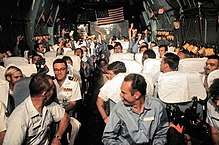
PAVN/VC leaders expected the ceasefire terms would favor their side, but Saigon, bolstered by a surge of U.S. aid received just before the ceasefire went into effect, began to roll back the Viet Cong. The PAVN/VC responded with a new strategy hammered out in a series of meetings in Hanoi in March 1973, according to the memoirs of Trần Văn Trà.[83]:672–4 With U.S. bombings suspended, work on the Ho Chi Minh trail and other logistical structures could proceed unimpeded. Logistics would be upgraded until the North was in a position to launch a massive invasion of the South, projected for the 1975–1976 dry season. Tra calculated that this date would be Hanoi's last opportunity to strike before Saigon's army could be fully trained.[83]:672–4 The PAVN/VC resumed offensive operations when the dry season began in 1973, and by January 1974 had recaptured territory it lost during the previous dry season.
Within South Vietnam, the departure of the US military and the global recession that followed the 1973 oil crisis hurt an economy that was partly dependent on U.S. financial support and troop presence. After two clashes that left 55 ARVN soldiers dead, President Thieu announced on 4 January 1974, that the war had restarted and that the Paris Peace Accords were no longer in effect. This was despite there being over 25,000 South Vietnamese casualties during the ceasefire period.[192][32]:683
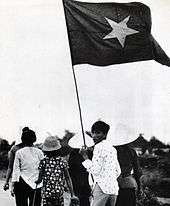
The success of the 1973–1974 dry season offensive inspired Trà to return to Hanoi in October 1974 and plead for a larger offensive the next dry season. This time, Trà could travel on a drivable highway with regular fueling stops, a vast change from the days when the Ho Chi Minh trail was a dangerous mountain trek.[83]:676 Giáp, the North Vietnamese defence minister, was reluctant to approve of Trà's plan since a larger offensive might provoke U.S. reaction and interfere with the big push planned for 1976. Trà appealed over Giáp's head to first secretary Lê Duẩn, who approved of the operation. Trà's plan called for a limited offensive from Cambodia into Phước Long Province. The strike was designed to solve local logistical problems, gauge the reaction of South Vietnamese forces, and determine whether the U.S. would return.[32]:685–90
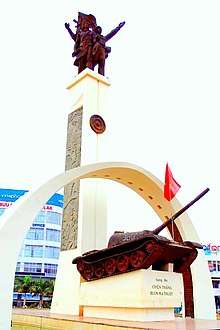
At the start of 1975, the South Vietnamese had three times as much artillery and twice the number of tanks and armoured cars as the PAVN. They also had 1,400 aircraft and a two-to-one numerical superiority in combat troops over the PAVN/VC.[193] However, the rising oil prices meant that much of this could not be used, and the rushed nature of Vietnamization, intended to cover the US retreat, saw a lack of spare parts, ground-crew and maintenance personnel, rendering most of the equipment given inoperable.[171]:362–6 Gerald Ford took over as U.S. president on 9 August 1974 after President Nixon resigned due to the Watergate scandal and Congress cut financial aid to South Vietnam from $1 billion a year to $700 million. Congress also voted in further restrictions on funding to be phased in through 1975 and to culminate in a total cutoff in 1976.[32]:686
On 13 December 1974, North Vietnamese forces attacked Phước Long. Phuoc Binh, the provincial capital, fell on 6 January 1975. Ford desperately asked Congress for funds to assist and re-supply the South before it was overrun.[194] Congress refused.[194] The fall of Phuoc Binh and the lack of an American response left the South Vietnamese elite demoralized.
The speed of this success led the Politburo to reassess its strategy. It was decided that operations in the Central Highlands would be turned over to General Văn Tiến Dũng and that Pleiku should be seized, if possible. Before he left for the South, Dũng was addressed by Lê Duẩn: "Never have we had military and political conditions so perfect or a strategic advantage as great as we have now."[195]
Campaign 275
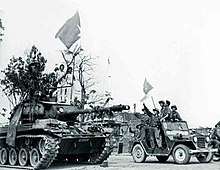
On 10 March 1975, General Dung launched Campaign 275, a limited offensive into the Central Highlands, supported by tanks and heavy artillery. The target was Buôn Ma Thuột, in Đắk Lắk Province. If the town could be taken, the provincial capital of Pleiku and the road to the coast would be exposed for a planned campaign in 1976. The ARVN proved incapable of resisting the onslaught, and its forces collapsed on 11 March. Once again, Hanoi was surprised by the speed of their success. Dung now urged the Politburo to allow him to seize Pleiku immediately and then turn his attention to Kon Tum. He argued that with two months of good weather remaining until the onset of the monsoon, it would be irresponsible to not take advantage of the situation.[17]:
President Thiệu, a former general, was fearful that his forces would be cut off in the north by the attacking communists; Thieu ordered a retreat, which soon turned into a bloody rout. While the bulk of ARVN forces attempted to flee, isolated units fought desperately. ARVN general Phu abandoned Pleiku and Kon Tum and retreated toward the coast, in what became known as the "column of tears".[32]:693–4
On 20 March, Thieu reversed himself and ordered Huế, Vietnam's third-largest city, be held at all costs, and then changed his policy several times. As the PAVN launched their attack, panic set in, and ARVN resistance withered. On 22 March, the PAVN opened the siege of Huế. Civilians flooded the airport and the docks hoping for any mode of escape. As resistance in Huế collapsed, PAVN rockets rained down on Da Nang and its airport. By 28 March 35,000 PAVN troops were poised to attack the suburbs. By 30 March 100,000 leaderless ARVN troops surrendered as the PAVN marched victoriously through Da Nang. With the fall of the city, the defense of the Central Highlands and Northern provinces came to an end.[32]:699–700
Final North Vietnamese offensive
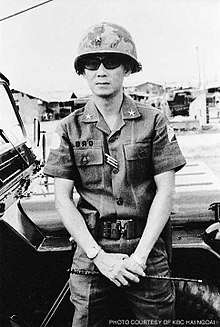
With the northern half of the country under their control, the Politburo ordered General Dung to launch the final offensive against Saigon. The operational plan for the Ho Chi Minh Campaign called for the capture of Saigon before 1 May. Hanoi wished to avoid the coming monsoon and prevent any redeployment of ARVN forces defending the capital. Northern forces, their morale boosted by their recent victories, rolled on, taking Nha Trang, Cam Ranh and Da Lat.[32]:702–4
On 7 April, three PAVN divisions attacked Xuân Lộc, 40 miles (64 km) east of Saigon. For two bloody weeks, severe fighting raged as the ARVN defenders made a last stand to try to block the PAVN advance. On 21 April, however, the exhausted garrison was ordered to withdraw towards Saigon.[32]:704–7 An embittered and tearful president Thieu resigned on the same day, declaring that the United States had betrayed South Vietnam. In a scathing attack, he suggested that Kissinger had tricked him into signing the Paris peace agreement two years earlier, promising military aid that failed to materialize. Having transferred power to Trần Văn Hương on 21 April, he left for Taiwan on 25 April.[32]:714 After having appealed unsuccessfully to Congress for $700 million in emergency aid for South Vietnam, President Ford had given a televised speech on 23 April, declaring an end to the Vietnam War and all U.S. aid.
By the end of April, the ARVN had collapsed on all fronts except in the Mekong Delta. Thousands of refugees streamed southward, ahead of the main communist onslaught. On 27 April 100,000 PAVN troops encircled Saigon. The city was defended by about 30,000 ARVN troops. To hasten a collapse and foment panic, the PAVN shelled Tan Son Nhut Airport and forced its closure. With the air exit closed, large numbers of civilians found that they had no way out.[32]:716
Fall of Saigon
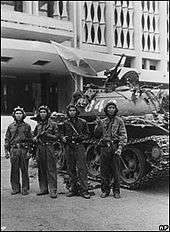
Chaos, unrest, and panic broke out as hysterical South Vietnamese officials and civilians scrambled to leave Saigon. Martial law was declared. American helicopters began evacuating South Vietnamese, U.S. and foreign nationals from various parts of the city and from the U.S. embassy compound. Operation Frequent Wind had been delayed until the last possible moment, because of U.S. Ambassador Graham Martin's belief that Saigon could be held and that a political settlement could be reached. Frequent Wind was the largest helicopter evacuation in history. It began on 29 April, in an atmosphere of desperation, as hysterical crowds of Vietnamese vied for limited space. Frequent Wind continued around the clock, as PAVN tanks breached defenses near Saigon. In the early morning hours of 30 April, the last U.S. Marines evacuated the embassy by helicopter, as civilians swamped the perimeter and poured into the grounds.[32]:718–20
On 30 April 1975, PAVN troops entered the city of Saigon and quickly overcame all resistance, capturing key buildings and installations. A tank from the 304th Division crashed through the gates of the Independence Palace at 11:30 am local time and the Viet Cong flag was raised above it. President Dương Văn Minh, who had succeeded Huong two days earlier, surrendered to Colonel Bùi Tín.[32]:720–1
Opposition to U.S. involvement, 1964–1973
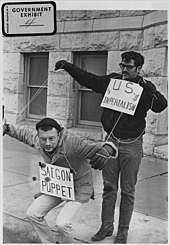
During the course of the Vietnam War a large segment of the American population came to be opposed to U.S. involvement in Southeast Asia. Public opinion steadily turned against the war following 1967 and by 1970 only a third of Americans believed that the U.S. had not made a mistake by sending troops to fight in Vietnam.[196][197]

Early opposition to U.S. involvement in Vietnam drew its inspiration from the Geneva Conference of 1954. American support of Diệm in refusing elections was seen as thwarting the democracy America claimed to support. John F. Kennedy, while senator, opposed involvement in Vietnam.[128] Nonetheless, it is possible to specify certain groups who led the anti-war movement at its peak in the late 1960s and the reasons why. Many young people protested because they were the ones being drafted, while others were against the war because the anti-war movement grew increasingly popular among the counterculture. Some advocates within the peace movement advocated a unilateral withdrawal of U.S. forces from Vietnam. Opposition to the Vietnam War tended to unite groups opposed to U.S. anti-communism and imperialism,[198] and for those involved with the New Left, such as the Catholic Worker Movement. Others, such as Stephen Spiro, opposed the war based on the theory of Just War. Some wanted to show solidarity with the people of Vietnam, such as Norman Morrison emulating the self-immolation of Thích Quảng Đức.
.jpg)
High-profile opposition to the Vietnam War increasingly turned to mass protests in an effort to shift U.S. public opinion. Riots broke out at the 1968 Democratic National Convention during protests against the war.[32]:514 After news reports of American military abuses, such as the 1968 My Lai Massacre, brought new attention and support to the anti-war movement, some veterans joined Vietnam Veterans Against the War. On 15 October 1969, the Vietnam Moratorium attracted millions of Americans.[199] The fatal shooting of four students at Kent State University in 1970 led to nationwide university protests.[200] Anti-war protests declined after the signing of the Paris Peace Accords and the end of the draft in January 1973, and the withdrawal of American troops from Vietnam in the months following.
Involvement of other countries
Pro-Hanoi
2,000 years of Chinese-Vietnamese enmity and hundreds of years of Chinese and Russian mutual suspicions were suspended when they united against us in Vietnam.
China
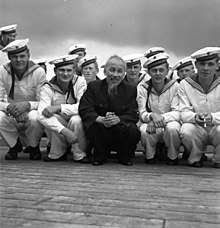
In 1950, China extended diplomatic recognition to the Democratic Republic of Vietnam and sent heavy weapons, as well as military advisers led by Luo Guibo to assist the Viet Minh in its war with the French. The first draft of the 1954 Geneva Accords was negotiated by French prime minister Pierre Mendès France and Chinese Premier Zhou Enlai who, seeing U.S. intervention coming, urged the Viet Minh to accept a partition at the 17th parallel.[202]:54–5
China's support for North Vietnam when the U.S. started to intervene included both financial aid and the deployment of hundreds of thousands of military personnel in support roles. In the summer of 1962, Mao Zedong agreed to supply Hanoi with 90,000 rifles and guns free of charge. Starting in 1965, China sent anti-aircraft units and engineering battalions to North Vietnam to repair the damage caused by American bombing, man anti-aircraft batteries, rebuild roads and railroads, transport supplies, and perform other engineering works. This freed North Vietnamese army units for combat in the South. China sent 320,000 troops and annual arms shipments worth $180 million.[202]:135 The Chinese military claims to have caused 38% of American air losses in the war.[16]: China claimed that its military and economic aid to North Vietnam and the Viet Cong totaled $20 billion (approx. $143 billion adjusted for inflation in 2015) during the Vietnam War.[16]: Included in that aid were donations of 5 million tons of food to North Vietnam (equivalent to North Vietnamee food production in a single year), accounting for 10–15% of the North Vietnamese food supply by the 1970s.[16]:
Sino-Soviet relations soured after the Soviets invaded Czechoslovakia in August 1968. In October, the Chinese demanded North Vietnam cut relations with Moscow, but Hanoi refused.[203] The Chinese began to withdraw in November 1968 in preparation for a clash with the Soviets, which occurred at Zhenbao Island in March 1969.
In 1967, the Chinese government launched a secret military program named "Project 523". which intended to find a treatment for malaria to provide the assistance to the PAVN who suffered malaria. As a result, Chinese scientist Youyou Tu and her collaborators discovered artemisinin. Tu was awarded the Nobel Prize in 2015 for her contribution on the anti-malaria treatment.
The Chinese also began financing the Khmer Rouge as a counterweight to North Vietnam at this time. China "armed and trained" the Khmer Rouge during the civil war and continued to aid them for years afterward.[204] The Khmer Rouge launched ferocious raids into Vietnam in 1975–1978. When Vietnam responded with an invasion that toppled the Khmer Rouge, China launched a brief, punitive invasion of Vietnam in 1979.
Soviet Union
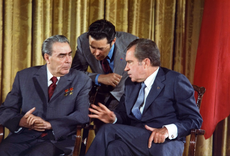
Soviet ships in the South China Sea gave vital early warnings to PAVN/VC forces in South Vietnam. The Soviet intelligence ships would pick up American B-52 bombers flying from Okinawa and Guam. Their airspeed and direction would be noted and then relayed to COSVN, North Vietnam's southern headquarters. Using airspeed and direction, COSVN analysts would calculate the bombing target and tell any assets to move "perpendicularly to the attack trajectory." These advance warnings gave them time to move out of the way of the bombers, and, while the bombing runs caused extensive damage, because of the early warnings from 1968 to 1970 they did not kill a single military or civilian leader in the headquarters complexes.[205]
The Soviet Union supplied North Vietnam with medical supplies, arms, tanks, planes, helicopters, artillery, anti-aircraft missiles and other military equipment. Soviet crews fired Soviet-made surface-to-air missiles at U.S. F-4 Phantoms, which were shot down over Thanh Hóa in 1965. Over a dozen Soviet soldiers lost their lives in this conflict. Following the dissolution of the Soviet Union in 1991, Russian officials acknowledged that the Soviet Union had stationed up to 3,000 troops in Vietnam during the war.[206]
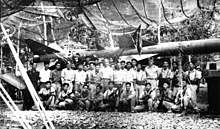
Some Russian sources give more specific numbers: Between 1953 and 1991, the hardware donated by the Soviet Union included 2,000 tanks, 1,700 APCs, 7,000 artillery guns, over 5,000 anti-aircraft guns, 158 surface-to-air missile launchers, 120 helicopters. During the war, the Soviets sent North Vietnam annual arms shipments worth $450 million.[207][32]:364–71 From July 1965 to the end of 1974, fighting in Vietnam was observed by some 6,500 officers and generals, as well as more than 4,500 soldiers and sergeants of the Soviet Armed Forces. In addition, Soviet military schools and academies began training Vietnamese soldiers—in all more than 10,000 military personnel.[208]
The KGB had also helped develop the signals intelligence (SIGINT) capabilities of the North Vietnamese, through an operation known as Vostok (also known as Phương Đông, meaning "Orient" and named after the Vostok 1).[209] The Vostok program was a counterintelligence and espionage program. These programs were pivotal in detecting and defeating CIA and South Vietnamese commando teams sent into North Vietnam, as they were detected and captured.[209] The Soviets helped the Ministry of Public Security recruit foreigners within high-level diplomatic circles among the Western-allies of the US, under a clandestine program known as "B12,MM" which produced thousands of high-level documents for nearly a decade, including targets of B-52 strikes.[209] In 1975, the SIGINT services had broken information from Western US-allies in Saigon, determining that the US would not intervene to save South Vietnam from collapse.[209]
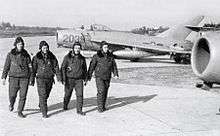
Czechoslovakia
The Czechoslovak Socialist Republic was a member of the Warsaw Pact and sent significant aid to North Vietnam, both prior to and after the Prague Spring.[211]:293 The Czechoslovakian government created committees which sought to not only promote and establish peace, but also to promote victory for Viet Cong and PAVN forces.[211]: Czech-made equipment and military aid would increase significantly following the Prague Spring.[212] Czechoslovakia continued to send tens of thousands of Czech-made rifles as well as mortar and artillery throughout the war.[212] In general, Czechoslovakia was aligned with European leftist movements,[211]: and there were simultaneous protests demonstrating against the Soviet intervention in Prague and the US intervention in Vietnam.[213]
Cooperation with Czechoslovakia on the development of North Vietnamese air capabilities began as early as 1956.[214] Czechoslovak instructors and trainers instructed the VPAF in China and helped them develop a modernised air force, with the Czech-built Aero Ae-45 and Aero L-29 Delfín alongside Zlín Z 26 aircraft utilised significantly for training, and regarded as preferential to Soviet-built Yakovlev Yak-3 as training aircraft.[214]
North Korea
As a result of a decision of the Korean Workers' Party in October 1966, in early 1967, North Korea (officially known as Democratic People's Republic of Korea) sent a fighter squadron to North Vietnam to back up the North Vietnamese 921st and 923rd Fighter Squadrons defending Hanoi. The North Koreans stayed through 1968, and 200 pilots were reported to have served. In addition, at least two anti-aircraft artillery regiments were sent as well.[215]
Cuba
.jpg)
The contributions to North Vietnam by the Republic of Cuba under Fidel Castro have been recognized several times by representatives of the Democratic Republic of Vietnam.[216] Castro mentioned in his discourses the Batallón Girón (Giron Battalion) as comprising the Cuban contingent that served as military advisors during the war.[217] In this battalion, the Cubans were aided by Nguyễn Thị Định, founding member of the Viet Cong, who later became the first female major general in the PAVN.[218]
There are numerous allegations by former U.S. prisoners of war that Cuban military personnel were present at North Vietnamese prison facilities during the war and that they participated in torture activities. Witnesses to this include Senator John McCain, the 2008 U.S. presidential candidate and a former Vietnam prisoner of war, according to his 1999 book Faith of My Fathers.[219]
Other Eastern Bloc countries
_1968%2C_MiNr_1371.jpg)
The Ministry of Public Security of Vietnam (Bộ Công An) states that there was special interest towards the Stasi of East Germany in establishing an intelligence and security apparatus, particularly since the Stasi was well-regarded and considered as "industrial, modern, and (with a) scientific working-style".[220] In official Vietnamese language histories on the Vietnamese Ministry of Public Security, the assistance provided by the Soviet and East German intelligence services to Vietnam is usually rated as the most important within the socialist bloc.[220] East Germany had also provided a substantial amount of aid to help North Vietnam duplicate "Green Dragon" identity cards, which were created by Saigon in order to identify North Vietnamese combatants and were difficult to duplicate.[220]
East German authorities had also begun providing material and technical aid to help develop and modernise the North Vietnamese economy and military.[220] In addition, East Germany had also vigorously denounced the US war effort, and had reaped significant international and diplomatic standing as a result of its anti-war campaigns.[221]
Romania was also among primary supporters of North Vietnam during the war in political, economic and military terms. Contemporarily, the Eastern Bloc country was also known for its role in the mediation activities in the mid-1960s, resulting in what became known as the "Trinh Signal" in January 1967, in which Hanoi accepted the possibility of negotiation with Washington.[222]
Bulgaria committed their charge-free military and economic supplies to North Vietnam in a bilateral agreement signed in 1972. Bulgarian military aid had already been provided to the latter since 1967. Similar conducts was undertaken by Hungary, which was reaffirmed in mutual visits of Hungary and North Vietnam in 1972 and 1973. Hungary also expressed their support through their representatives at the International Commission of Control and Supervision, a body established to supervise the implementation of the Paris Peace Accords.[223]
Pro-Saigon
As South Vietnam was formally part of a military alliance with the US, Australia, New Zealand, France, the UK, Pakistan, Thailand and the Philippines, the alliance was invoked during the war. The UK, France and Pakistan declined to participate, and South Korea and Taiwan were non-treaty participants.
South Korea
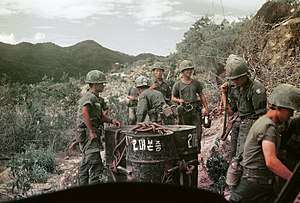
On the anti-communist side, South Korea (a.k.a. the Republic of Korea, ROK) had the second-largest contingent of foreign troops in South Vietnam after the United States. In November 1961, President Park Chung-hee proposed South Korean participation in the war to John F. Kennedy, but Kennedy disagreed as they were not SEATO treaty members.[224] On 1 May 1964, Lyndon Johnson agreed to permit South Korean participation under the Many Flags Program in return for monetary compensation.[224] The first South Korean troops began arriving in 1964 and large combat formations began arriving a year later. The ROK Marine Corps dispatched their 2nd Marine Brigade, while the ROK Army sent the Capital Division and later the 9th Infantry Division. In August 1966, after the arrival of the 9th Division, the Koreans established a corps command, the Republic of Korea Forces Vietnam Field Command, near I Field Force at Nha Trang.[182]:
State Department reports publicly questioned the usefulness of ROK forces in the conflict, as they have "appeared to have been reluctant to undertake offensive operations, and are only useful in guarding a small sector of the populated area".[225] State department reports furthermore state that ROK forces engaged in systemic, well-organised corruption in diverting US-equipment, and that actual security was often provided by South Vietnamese Regional Forces, which lacked organic firepower and heavy artillery but served as a buffer between Korean units and the PAVN/VC.[226] In addition, a RAND author conducting studies in South Vietnam in 1970 alleged that ROK forces had a "deliberate, systematic policy of committing atrocities", prompting civilians to leave ROK-controlled sectors.[227] The conduct of ROK forces often emboldened and strengthened the Viet Cong, adding ranks from an otherwise neutral population and undermining efforts to defeat the insurgency overall.[228]
Approximately 320,000 South Korean soldiers were sent to Vietnam,[229] each serving a one-year tour of duty. Maximum troop levels peaked at 50,000 in 1968, however all were withdrawn by 1973.[230] About 5,099 South Koreans were killed and 10,962 wounded during the war. South Korea claimed to have killed 41,000 Viet Cong.[229] The United States paid South Korean soldiers 236 million dollars for their efforts in Vietnam,[229] and South Korean GNP increased five-fold during the war.[229]
Thailand
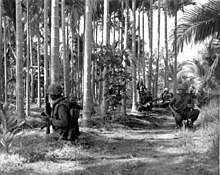
Thai Army formations, including the Royal Thai Volunteer Regiment (Queen's Cobras) and later the Royal Thai Army Expeditionary Division (Black Panthers), saw action in South Vietnam between 1965 and 1971. Thai forces saw much more action in the covert war in Laos between 1964 and 1972, though Thai regular formations there were heavily outnumbered by the irregular "volunteers" of the CIA-sponsored Police Aerial Reconnaissance Units or PARU, who carried out reconnaissance activities on the western side of the Ho Chi Minh trail.[17]:
Australia and New Zealand
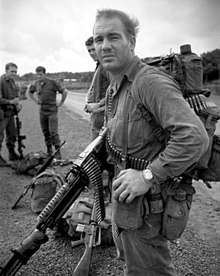
Australia and New Zealand, close allies of the United States and members of the SEATO and the ANZUS military cooperation treaty, sent ground troops to Vietnam. Both nations had gained experience in counterinsurgency and jungle warfare during the Malayan Emergency and World War II, and their governments subscribed to the domino theory. New Zealand was, however, a reluctant participant. Officials expected a foreign intervention to fail, were concerned that they would be supporting a corrupt regime, and didn't want to further stretch their country's small military (which was already deployed to Malaysia).[231] In the end, though, a desire to prove their commitment to the ANZUS alliance and discourage an American withdrawal from Southeast Asia necessitated a military commitment. Australia began by sending advisors to Vietnam in 1962, and combat troops were committed in 1965.[232]:555–8 New Zealand began by sending a detachment of engineers and an artillery battery, later sending special forces and regular infantry, which were attached to Australian formations.[233]:561–6 Australia's peak commitment was 7,672 combat troops and New Zealand's 552. Around 50,190 Australian personnel were involved during the war, of which 521 were killed and more than 3,000 wounded.[234] Approximately 3,500 New Zealanders served in Vietnam, with 37 killed and 187 wounded.[233]:539 Most Australians and New Zealanders served in the 1st Australian Task Force in Phước Tuy Province.[232]
Australia, with decades of experience from both the Malayan Emergency and its AATTV role in 1962, recognised the necessity of a true counter-insurgency, which relied on providing village-level security, establishing civilian trust and economic incentives and improving ARVN capabilities.[235] This brought Australian commanders into conflict with Westmoreland's conventional attrition warfare approach, since Australian ground forces were required to follow US doctrine.[235] Nevertheless, Australian forces were generally the most capable at counter-insurgency, and they helped to train Regional Forces despite being under significant doctrinal constraints.[235]
Philippines
Some 10,450 Filipino troops were dispatched to South Vietnam and primarily supported medical and other civilian pacification projects. These forces operated under the designation a or Philippine Civic Action Group-Vietnam. The naval base at Subic Bay was used for the U.S. Seventh Fleet from 1964 until the end of the war in 1975.[236][237] Subic Bay and Clark Air Base achieved maximum functionality during the war, as well as supporting an estimated 80,000 locals in allied tertiary businesses that ranged from shoe making to prostitution.[238]
Taiwan
Beginning in November 1967, Taiwan secretly operated a cargo transport detachment to assist the United States and South Vietnam. Taiwan also provided military training units for the South Vietnamese diving units, later known as the Lien Doi Nguoi Nhai (LDMN) or "Frogman unit" in English.[122]:3–4 Military commandos from Taiwan were captured by North Vietnamese forces three times trying to infiltrate North Vietnam.[122]:3–4
Neutral and non-belligerent nations
Canada
Contributor to the three-nation monitoring-force, the International Control Commission (ICC/ICSC) [1954-1973] and, briefly, its successor: the International Commission for Control and Supervision (ICCS) [1973-1973].[239] Officially, Canada did not have state-sanctioned combat involvement in the Vietnam War, and diplomatically, it was "non-belligerent", though the sympathies of the state and many of its citizens were well-understood by both sides.[240] The Vietnam War entry in The Canadian Encyclopedia asserts that Canada's record on the truce commissions was a pro-Saigon partisan one.[241]
Poland
Contributor to the three-nation monitoring-force, the International Control Commission (ICC/ICSC) [1954-1973] and its successor: the International Commission for Control and Supervision (ICCS) [1973-1975]. The Polish People's Republic had played a substantive role in brokering and serving as an intermediary for peace-talks between Hanoi and Saigon, as part of a delegation under the International Control Commission established under the Geneva Accords. Recent evidence has emerged that Poland played an early role in attempting to broker talks between Ngô Đình Nhu and the Diem regime and Hanoi in 1963 in an effort to prevent the expansion of the war, given that Polish representatives were the only communist nation present in Saigon and had acted as a broker and representative for Hanoi.[242]
Spain
President Johnson had asked General Francisco Franco to contribute a military contingent to the war effort. After lengthy debate between his ministers, Franco took the advice of veteran General Agustín Muñoz Grandes. Franco was even more cautious in committing himself to the US cause and finally decided to send a medical team of around thirty people, and under strict secrecy. The first group of medical soldiers, including four doctors, seven nurses and one officer in charge of military supplies, arrived in Vietnam in 1966 and worked at Truong Cong Dinh hospital in the Gò Công district. From 1966 to 1971 three other groups, totalling nearly 100 Spaniards, worked at the hospital.[243]
Brazil
Brazil, under a U.S.-backed military regime, officially supported the United States' position in South Vietnam and contributed a medical team and supplies to the country. It was the only Latin American country with a presence in the region.[244][245]
United Front for the Liberation of Oppressed Races (FULRO)
The ethnic minority peoples of South Vietnam, like the Montagnards (Degar) in the Central Highlands, the Hindu and Muslim Cham, and the Buddhist Khmer Krom, were actively recruited in the war. There was an active strategy of recruitment and favorable treatment of Montagnard tribes for the Viet Cong, as they were pivotal for control of infiltration routes.[246] Some groups had split off and formed the United Front for the Liberation of Oppressed Races (French: Front Uni de Lutte des Races Opprimées, acronym: FULRO) to fight for autonomy or independence. FULRO fought against both the South Vietnamese and the Viet Cong, later proceeding to fight against the unified Socialist Republic of Vietnam after the fall of South Vietnam.
During the war, the South Vietnamese president Ngo Dinh Diem began a program to settle ethnic Vietnamese Kinh on Montagnard lands in the Central Highlands region. This provoked a backlash from the Montagnards, some joining the Viet Cong as a result. The Cambodians under both the pro-China King Sihanouk and the pro-American Lon Nol supported their fellow co-ethnic Khmer Krom in South Vietnam, following an anti-ethnic Vietnamese policy. Following Vietnamization many Montagnard groups and fighters were incorporated into the Vietnamese Rangers as border sentries.
War crimes
A large number of war crimes took place during the Vietnam War. War crimes were committed by both sides during the conflict and included rape, massacres of civilians, bombings of civilian targets, terrorism, the widespread use of torture, and the murder of prisoners of war. Additional common crimes included theft, arson, and the destruction of property not warranted by military necessity.[247]
South Vietnamese, Korean and American
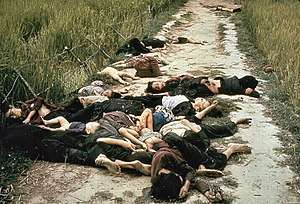
In 1968, the Vietnam War Crimes Working Group (VWCWG) was established by the Pentagon task force set up in the wake of the My Lai Massacre, to attempt to ascertain the veracity of emerging claims of war crimes by U.S. armed forces in Vietnam, during the Vietnam War period.
Of the war crimes reported to military authorities, sworn statements by witnesses and status reports indicated that 320 incidents had a factual basis.[248] The substantiated cases included 7 massacres between 1967 and 1971 in which at least 137 civilians were killed; seventy eight further attacks targeting non-combatants resulting in at least 57 deaths, 56 wounded and 15 sexually assaulted; and 141 cases of U.S. soldiers torturing civilian detainees or prisoners of war with fists, sticks, bats, water or electric shock.[248] Rummel estimated that American forces committed around 5,500 democidal killings between 1960 and 1972, from a range of between 4,000 and 10,000 killed.[37]: Journalism in the ensuing years has documented other overlooked and uninvestigated war crimes involving every army division that was active in Vietnam,[248] including the atrocities committed by Tiger Force.[249]
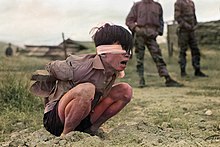
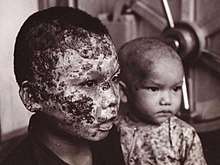
U.S. forces established numerous free-fire zones as a tactic to prevent Viet Cong fighters from sheltering in South Vietnamese villages.[250] Such practice, which involved the assumption that any individual appearing in the designated zones was an enemy combatant that could be freely targeted by weapons, is regarded by journalist Lewis M. Simons as "a severe violation of the laws of war".[251] Nick Turse, in his 2013 book, Kill Anything that Moves, argues that a relentless drive toward higher body counts, a widespread use of free-fire zones, rules of engagement where civilians who ran from soldiers or helicopters could be viewed as Viet Cong and a widespread disdain for Vietnamese civilians led to massive civilian casualties and endemic war crimes inflicted by U.S. troops.[252]:251 One example cited by Turse is Operation Speedy Express, an operation by the 9th Infantry Division, which was described by John Paul Vann as, in effect, "many My Lais".[252]:251 A report by Newsweek magazine suggested that at least 5,000 civilians may have been killed during six months of the operation, as there were approximately 748 recovered weapons.[253]
R.J. Rummel estimated that 39,000 were killed by South Vietnam during the Diem-era in democide from a range of between 16,000 and 167,000 South Vietnamese civilians; for 1964 to 1975, Rummel estimated 50,000 people were killed in democide, from a range of between 42,000 and 128,000. Thus, the total for 1954 to 1975 is 81,000, from a range of between 57,000 and 284,000 deaths caused by South Vietnam.[37]: Benjamin Valentino attributes possibly 110,000–310,000 "counter-guerrilla mass killings" of non-combatants to U.S. and South Vietnamese forces during the war.[254] An estimated 26,000 to 41,000 civilian members of the PRG/Viet Cong termed "VC Infrastructure" were killed during the Phoenix Program, by US and South Vietnamese intelligence and security, with an unknown number being innocent civilians.[255][256][257]
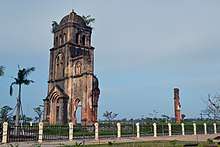
Torture and ill-treatment were frequently applied by the South Vietnamese to POWs as well as civilian prisoners.[258]:77 During their visit to the Con Son Prison in 1970, U.S. congressmen Augustus F. Hawkins and William R. Anderson witnessed detainees either confined in minute "tiger cages" or chained to their cells, and provided with poor-quality food. A group of American doctors inspecting the prison in the same year found many inmates suffering symptoms resulting from forced immobility and torture.[258]:77 During their visits to transit detention facilities under American administration in 1968 and 1969, the International Red Cross recorded many cases of torture and inhumane treatment before the captives were handed over to South Vietnamese authorities.[258]:78 Torture was conducted by the South Vietnamese government in collusion with the CIA.[259][260]
South Korean forces were also accused of war crimes. One documented event was the Phong Nhị and Phong Nhất massacre where the 2nd Marine Brigade reportedly killed 69–79 civilians on 12 February 1968 in Phong Nhị and Phong Nhất village, Điện Bàn District, Quảng Nam Province.[261] South Korean forces are also accused of perpetrating other massacres, namely: Bình Hòa massacre, Binh Tai Massacre and Hà My massacre.
North Vietnamese and Viet Cong
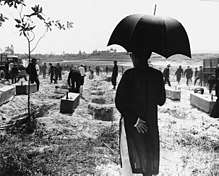
Ami Pedahzur has written that "the overall volume and lethality of Viet Cong terrorism rivals or exceeds all but a handful of terrorist campaigns waged over the last third of the twentieth century", based on the definition of terrorists as a non-state actor, and examining targeted killings and civilian deaths which are estimated at over 18,000 from 1966 to 1969.[262] The US Department of Defense estimates the VC/PAVN had conducted 36,000 murders and almost 58,000 kidnappings from 1967 to 1972, c. 1973.[263] Statistics for 1968–1972 suggest that "about 80 percent of the terrorist victims were ordinary civilians and only about 20 percent were government officials, policemen, members of the self-defence forces or pacification cadres."[28]:273 Benjamin Valentino attributes 45,000–80,000 "terrorist mass killings" of non-combatants to the Viet Cong during the war.[254] Viet Cong tactics included the frequent mortaring of civilians in refugee camps, and the placing of mines on highways frequented by villagers taking their goods to urban markets. Some mines were set only to go off after heavy vehicle passage, causing extensive slaughter aboard packed civilian buses.[28]:270–9
Notable Viet Cong atrocities include the massacre of over 3,000 unarmed civilians at Huế[264] during the Tet Offensive and the killing of 252 civilians during the Đắk Sơn massacre.[265] 155,000 refugees fleeing the final North Vietnamese Spring Offensive were reported to have been killed or abducted on the road to Tuy Hòa in 1975.[266] According to Rummel, PAVN and Viet Cong troops killed 164,000 civilians in democide between 1954 and 1975 in South Vietnam, from a range of between 106,000 and 227,000 (50,000 of which were reportedly killed by shelling and mortar on ARVN forces during the retreat to Tuy Hoa).[37]: North Vietnam was also known for its abusive treatment of American POWs, most notably in Hỏa Lò Prison (aka the Hanoi Hilton), where torture was employed to extract confessions.[83]:655
Women
American nurses
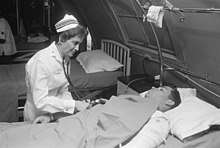
American women served on active duty performing a variety of jobs. Early in 1963, the Army Nurse Corps (ANC) launched Operation Nightingale, an intensive effort to recruit nurses to serve in Vietnam.[267]:7 First Lieutenant Sharon Lane was the only female military nurse to be killed by enemy gunfire during the war, on 8 June 1969.[267]:57 One civilian doctor, Eleanor Ardel Vietti, who was captured by Viet Cong on 30 May 1962, in Buôn Ma Thuột, remains the only American woman unaccounted for from the Vietnam War.[268][269][270]
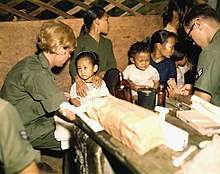
Although a small number of women were assigned to combat zones, they were never allowed directly in the field of battle. Unlike the men, the women who served in the military were solely volunteers. They faced a plethora of challenges, one of which was the relatively small number of female soldiers. Living in a male-dominated environment created tensions between the sexes. By 1973, approximately 7,500 women had served in Vietnam in the Southeast Asian theater.[271] American women serving in Vietnam were subject to societal stereotypes. To address this problem, the ANC released advertisements portraying women in the ANC as "proper, professional and well protected." This effort to highlight the positive aspects of a nursing career reflected the feminism of the 1960s–1970s in the United States. Although female military nurses lived in a heavily male environment, very few cases of sexual harassment were ever reported.[267]:71
Vietnamese soldiers
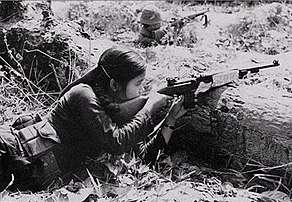
Unlike the American women who went to Vietnam, both South and North Vietnamese women were enlisted and served in combat zones. Women were enlisted in both the PAVN and the Viet Cong, many joining due to the promises of female equality and a greater social role within society.[272][273] Some women also served for the PAVN and Viet Cong intelligence services. The deputy military commander of the Viet Cong, was a female general, Nguyễn Thị Định. All-female units were present throughout the entirety of the war, ranging from front-line combat troops to anti-aircraft, scout and reconnaissance units.[274] Female combat squads were present in the Cu Chi theatre.[275] They also fought in the Battle of Hue.[148]:388–91 In addition, large numbers of women served in North Vietnam, manning anti-aircraft batteries, providing village security and serving in logistics on the Ho Chi Minh trail.[274][273] Other women were embedded with troops on the front-lines, serving as doctors and medical personnel. Đặng Thùy Trâm became renowned after her diary was published following her death. The Foreign Minister for the Viet Cong and later the PRG was also a woman, Nguyễn Thị Bình.
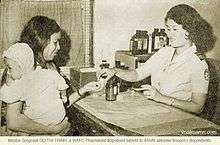
In South Vietnam, many women voluntarily served in the ARVN's Women's Armed Force Corps (WAFC) and various other Women's corps in the military. Some, like in the WAFC, served in combat with other soldiers. Others served as nurses and doctors in the battlefield and in military hospitals, or served in South Vietnam or America's intelligence agencies. During Diệm's presidency, his sister-in-law Madame Nhu was the commander of the WAFC.[276] Many women joined provincial and voluntary village-level militia in the People's Self-Defense Force especially during the ARVN expansions later in the war.
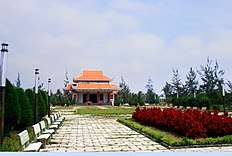
During the war more than one million rural people migrated or fled the fighting in the South Vietnamese countryside to the cities, especially Saigon. Among the internal refugees were many young women who became the ubiquitous "bar girls" of wartime South Vietnam, "hawking her wares—be that cigarettes, liquor, or herself" to American and allied soldiers.[277][278] American bases were ringed by bars and brothels.[279]
8,040 Vietnamese women came to the United States as war brides between 1964 and 1975.[280] Many mixed-blood Amerasian children were left behind when their American fathers returned to the United States after their tour of duty in South Vietnam; 26,000 of them were permitted to immigrate to the United States in the 1980s and 1990s.[281]
Journalists
Women also played a prominent role as front-line reporters in the conflict, directly reporting on the conflict as it occurred.[282] A number of women volunteered on the North Vietnamese side as embedded journalists, including author Lê Minh Khuê embedded with PAVN forces,[283] on the Ho Chi Minh trail as well as on combat fronts.[284] A number of prominent Western journalists were also involved in covering the war, with Dickey Chapelle being among the first as well as the first American female reporter killed in a war. The French-speaking Australian journalist Kate Webb was captured along with a photographer and others by the Viet Cong in Cambodia and travelled into Laos with them; they were released back into Cambodia after 23 days of captivity.[285] Webb would be the first Western journalist to be captured and released, as well as cover the perspective of the Viet Cong in her memoir On The Other Side. Another French-speaking journalist, Catherine Leroy, was briefly captured and released by North Vietnamese forces during the Battle of Huế, capturing some famous photos from the battles that would appear on the cover of Life Magazine.[148]:245
Black servicemen
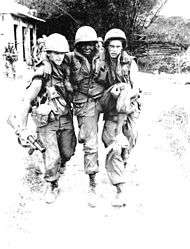
The experience of American military personnel of African ancestry during the Vietnam War had received significant attention. For example, the website "African-American Involvement in the Vietnam War" compiles examples of such coverage,[286] as does the print and broadcast work of journalist Wallace Terry whose book Bloods: An Oral History of the Vietnam War by Black Veterans (1984), includes observations about the impact of the war on the black community in general and on black servicemen specifically. Points he makes on the latter topic include: the higher proportion of combat casualties in Vietnam among African American servicemen than among American soldiers of other races, the shift toward and different attitudes of black military careerists versus black draftees, the discrimination encountered by black servicemen "on the battlefield in decorations, promotion and duty assignments" as well as their having to endure "the racial insults, cross-burnings and Confederate flags of their white comrades"—and the experiences faced by black soldiers stateside, during the war and after America's withdrawal.[287]
Civil rights leaders protested the disproportionate casualties and the overrepresentation in hazardous duty and combat roles experienced by African American servicemen, prompting reforms that were implemented beginning in 1967–68. As a result, by the war's completion in 1975, black casualties had declined to 12.5% of US combat deaths, approximately equal to percentage of draft-eligible black men, though still slightly higher than the 10% who served in the military.[288]
Weapons
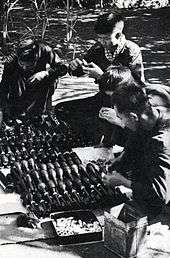
During the early stages of the war, the Viet Cong mainly sustained itself with captured arms; these were often of American manufacture or were crude, makeshift weapons used alongside shotguns made of galvanized pipes. Most arms were captured from poorly defended ARVN militia outposts. In 1967, all Viet Cong battalions were reequipped with arms of Soviet design such as the AK-47 assault rifle, carbines and the RPG-2 anti-tank weapon.[104]: Their weapons were principally of Chinese[289] or Soviet manufacture.[290] In the period up to the conventional phase in 1970, the Viet Cong and PAVN were primarily limited to 81 mm mortars, recoilless rifles, and small arms and had significantly lighter equipment and firepower in comparison with the US arsenal. They relied on ambushes, superior stealth, planning, marksmanship, and small-unit tactics to face the disproportionate US technological advantage.[291]
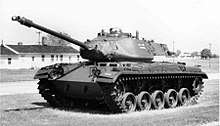
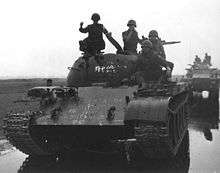
After the Tet Offensive, many PAVN units incorporated light tanks such as the Type 62 Type 59 tank., BTR-60, Type 60 artillery, amphibious tanks (such as the PT-76) and integrated into new war doctrines as a mobile combined-arms force.[292] The PAVN started receiving experimental Soviet weapons against ARVN forces, including MANPADS 9K32 Strela-2 and anti-tank missiles, 9M14 Malyutka. By 1975, they had fully transformed from the strategy of mobile light-infantry and using the people's war concept used against the United States.[292]
The US service rifle was initially the M14. The M14 was a powerful, accurate rifle, but it was heavy, hard-recoiling, and especially unwieldy in jungle fighting, and it was gradually replaced by the M16 rifle between 1964 and 1970. For a period, the M16 suffered from a propensity to jam in combat, leaving the soldier defenseless and potentially killing him.[293] According to a congressional report, the jamming was not related to operator error or to an inherent flaw in the rifle, but instead due to a change in the gunpowder to be used in the rifle's cartridges, which led to rapid powder fouling of the action and failures to extract or feed cartridges. This decision, made after "inadequate testing", proved that "the safety of soldiers was a secondary consideration."[294] The issue was solved in early 1968 with the issuance of the M16A1, featuring a chrome-plated bore, which reduced fouling, and the introduction of a cleaner-burning powder.[32]:408–11 The M60 machine gun was the main machine gun of the US army at the time, and many M60s were put on helicopters to provide suppressive fire.
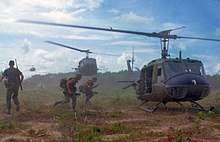
The AC-130 "Spectre" Gunship and the UH-1 "Huey" gunship were used frequently during the war. The AC-130 was a heavily armed ground-attack aircraft variant of the C-130 Hercules transport plane, while the Huey is a military helicopter powered by a single, turboshaft engine; approximately 7,000 UH-1 aircraft saw service in Vietnam. The U.S. heavily armored, 90 mm M48A3 Patton tank saw extensive action during the Vietnam War, and over 600 were deployed with US Forces. Ground forces also had access to B-52 and F-4 Phantom II and other aircraft to launch napalm, white phosphorus, tear gas, chemical weapons, precision-guided munition and cluster bombs.[295]
Radio communications
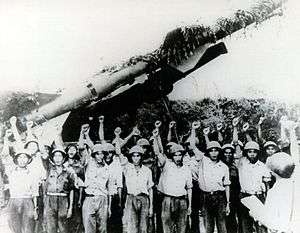
The Vietnam War was the first conflict where U.S. forces had secure voice communication equipment available at the tactical level. The National Security Agency ran a crash program to provide U.S. forces with a family of security equipment, codenamed NESTOR, fielding 17,000 units initially; eventually 30,000 units were produced. However, limitations of the units, including poor voice quality, reduced range, annoying time delays and logistical support issues, led to only one unit in ten being used.[296] While many in the U.S. military believed that the Viet Cong and PAVN would not be able to exploit insecure communications, interrogation of captured communication intelligence units showed they could not understand the jargon and codes used in real time and were often able to warn their side of impending U.S. actions.[296]:4,10
Extent of U.S. bombings
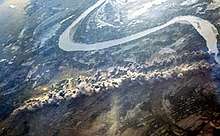
The U.S. dropped over 7 million tons of bombs on Indochina during the war, more than triple the 2.1 million tons of bombs the U.S. dropped on Europe and Asia during all of World War II and more than ten times the amount dropped by the U.S. during the Korean War. 500 thousand tons were dropped on Cambodia, 1 million tons were dropped on North Vietnam, and 4 million tons were dropped on South Vietnam. On a per capita basis, the 2 million tons dropped on Laos make it the most heavily bombed country in history; The New York Times noted this was "nearly a ton for every person in Laos."[126] Due to the particularly heavy impact of cluster bombs during this war, Laos was a strong advocate of the Convention on Cluster Munitions to ban the weapons, and was host to the First Meeting of States Parties to the convention in November 2010.[297]
Former U.S. Air Force official Earl Tilford has recounted "repeated bombing runs of a lake in central Cambodia. The B-52s literally dropped their payloads in the lake." The Air Force ran many missions of this kind to secure additional funding during budget negotiations, so the tonnage expended does not directly correlate with the resulting damage.[298]
Aftermath
Events in Southeast Asia
On 2 July 1976, North and South Vietnam were merged to form the Socialist Republic of Vietnam.[299] Despite speculation that the victorious North Vietnamese would, in President Nixon's words, "massacre the civilians there [South Vietnam] by the millions," there is a widespread consensus that no mass executions took place.[300] However, in the years following the war, a vast number of South Vietnamese were sent to re-education camps where many endured torture, starvation, and disease while being forced to perform hard labor.[301][302] According to Amnesty International Report 1979, this figure varied considerably depend on different observers: "[...] included such figures as "50,000 to 80,000" (Le Monde, 19 April 1978), "150,000" (Reuters from Bien Hoa, 2 November 1977), "150,000 to 200,000" (Washington Post, 20 December 1978), and "300,000" (Agence France Presse from Hanoi, 12 February 1978)."[303] Such variations may be because "Some estimates may include not only detainees but also people sent from the cities to the countryside." According to a native observer, 443,360 people had to register for a period in re-education camps in Saigon alone, and while some of them were released after a few days, others stayed there for more than a decade.[304]
.jpg)
Gabriel García Márquez, a Nobel Prize winning writer, described South Vietnam as a "False paradise" after the war, when he visited in 1980: "The cost of this delirium was stupefying: 360,000 people mutilated, a million widows, 500,000 prostitutes, 500,000 drug addicts, a million tuberculous and more than a million soldiers of the old regime, impossible to rehabilitate into a new society. Ten percent of the population of Ho Chi Minh City was suffering from serious venereal diseases when the war ended, and there were 4 million illiterates throughout the South."[305] The US used its security council veto to block Vietnam's recognition by the United Nations three times, an obstacle to the country receiving international aid.[306]
By 1975, the North Vietnamese had lost influence over the Khmer Rouge.[32]:708 Phnom Penh, the capital of Cambodia, fell to the Khmer Rouge on 17 April 1975. Under the leadership of Pol Pot, the Khmer Rouge would eventually kill 1–3 million Cambodians out of a population of around 8 million, in one of the bloodiest genocides in history.[53]:[307][308][309]
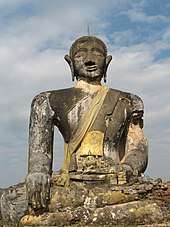
The relationship between Vietnam and Democratic Kampuchea (Cambodia) escalated right after the end of the war. In response to the Khmer Rouge taking over Phu Quoc on 17 April and Tho Chu on 4 May 1975 and the belief that they were responsible for the disappearance of 500 Vietnamese natives on Tho Chu, Vietnam launched a counterattack to take back these islands.[310] After several failed attempts to negotiate by both sides, Vietnam invaded Democratic Kampuchea in 1978 and ousted the Khmer Rouge, who were being supported by China, in the Cambodian–Vietnamese War. In response, China invaded Vietnam in 1979. The two countries fought a brief border war, known as the Sino-Vietnamese War. From 1978 to 1979, some 450,000 ethnic Chinese left Vietnam by boat as refugees or were expelled.
The Pathet Lao overthrew the monarchy of Laos in December 1975, establishing the Lao People's Democratic Republic under the leadership of a member of the royal family, Souphanouvong. The change in regime was "quite peaceful, a sort of Asiatic 'velvet revolution'"—although 30,000 former officials were sent to reeducation camps, often enduring harsh conditions for several years. The conflict between Hmong rebels and the Pathet Lao continued in isolated pockets.[86]:575–6
The millions of cluster bombs the US dropped on Southeast Asia rendered the landscape hazardous. In Laos alone, some 80 million bombs failed to explode and remain scattered throughout the country, rendering vast swathes of land impossible to cultivate and killing or maiming 50 Laotians every year.[311] It is estimated that the explosives still remaining buried in the ground will not be removed entirely for the next few centuries.[146]:317 Over 3 million people left Vietnam, Laos, and Cambodia in the Indochina refugee crisis. Most Asian countries were unwilling to accept these refugees, many of whom fled by boat and were known as boat people.[312]
Between 1975 and 1998, an estimated 1.2 million refugees from Vietnam and other Southeast Asian countries resettled in the United States, while Canada, Australia, and France resettled over 500,000. China accepted 250,000 people.[313] Of all the countries of Indochina, Laos experienced the largest refugee flight in proportional terms, as 300,000 people out of a total population of 3 million crossed the border into Thailand. Included among their ranks were "about 90 percent" of Laos's "intellectuals, technicians, and officials."[86]:575 An estimated 200,000 to 400,000 Vietnamese boat people died at sea, according to the United Nations High Commissioner for Refugees.[314]
.jpg)
Effect on the United States
Views on the war
| U.S. military costs | U.S. military aid to SVN | U.S. economic aid to SVN | Total | Total (2015 dollars) |
|---|---|---|---|---|
| $111 billion | $16.138 billion | $7.315 billion | $134.53 billion | $1.020 trillion |
In the post-war era, Americans struggled to absorb the lessons of the military intervention. As General Maxwell Taylor, one of the principal architects of the war, noted, "First, we didn't know ourselves. We thought that we were going into another Korean War, but this was a different country. Secondly, we didn't know our South Vietnamese allies… And we knew less about North Vietnam. Who was Ho Chi Minh? Nobody really knew. So, until we know the enemy and know our allies and know ourselves, we'd better keep out of this kind of dirty business. It's very dangerous."[83]:23 President Ronald Reagan coined the term "Vietnam Syndrome" to describe the reluctance of the American public and politicians to support further military interventions abroad after Vietnam. According to a 2004 Gallup poll, 62 percent of Americans believed it was an unjust war.[316] US public polling in 1978 revealed that nearly 72% of Americans believed the war was "fundamentally wrong and immoral." Nearly a decade later, the number fell to 66%. In the past three decades, surveys have consistently shown that only around 35% of Americans believe that the war was fundamentally wrong and immoral.[197]:10 When surveyed in 2000, one third of Americans believed that the war was a noble cause.[197]:10
Failure of the war is often placed at different institutions and levels. Some have suggested that the failure of the war was due to political failures of U.S. leadership.[317] The official history of the United States Army noted that "tactics have often seemed to exist apart from larger issues, strategies, and objectives. Yet in Vietnam the Army experienced tactical success and strategic failure... success rests not only on military progress but on correctly analysing the nature of the particular conflict, understanding the enemy's strategy, and assessing the strengths and weaknesses of allies. A new humility and a new sophistication may form the best parts of a complex heritage left to the Army by the long, bitter war in Vietnam."[108]
Others point to a failure of U.S. military doctrine. Secretary of Defense Robert McNamara stated that "the achievement of a military victory by U.S. forces in Vietnam was indeed a dangerous illusion."[73]:368 The inability to bring Hanoi to the bargaining table by bombing also illustrated another U.S. miscalculation, and demonstrated the limitations of U.S. military abilities in achieving political goals.[83]:17 As Army Chief of Staff Harold Keith Johnson noted, "if anything came out of Vietnam, it was that air power couldn't do the job."[318] Even General William Westmoreland admitted that the bombing had been ineffective. As he remarked, "I still doubt that the North Vietnamese would have relented."[318] U.S. Secretary of State Henry Kissinger wrote in a secret memo to President Gerald Ford that "in terms of military tactics, we cannot help draw the conclusion that our armed forces are not suited to this kind of war. Even the Special Forces who had been designed for it could not prevail."[319]
Hanoi had persistently sought unification of the country since the Geneva Accords, and the effects of U.S. bombings had negligible impact on the goals of the North Vietnamese government.[146]:1–10 The effects of U.S. bombing campaigns had mobilised the people throughout North Vietnam and mobilised international support for North Vietnam due to the perception of a super-power attempting to bomb a significantly smaller, agrarian society into submission.[146]:48–52
The Vietnam War POW/MIA issue, concerning the fate of U.S. service personnel listed as missing in action, persisted for many years after the war's conclusion. The costs of the war loom large in American popular consciousness; a 1990 poll showed that the public incorrectly believed that more Americans lost their lives in Vietnam than in World War II.[320]
Cost of the war
Between 1953 and 1975, the United States was estimated to have spent $168 billion on the war (equivalent to $1.38 trillion in 2019).[321] This resulted in a large federal budget deficit. Other figures point to $138.9 billion from 1965 to 1974 (not inflation-adjusted), 10 times all education spending in the US and 50 times more than housing and community development spending within that time period.[322] General record-keeping was reported to have been sloppy for government spending during the war.[322] It was stated that war-spending could have paid off every mortgage in the US at that time, with money leftover.[322]
More than 3 million Americans served in the Vietnam War, some 1.5 million of whom actually saw combat in Vietnam.[323] James E. Westheider wrote that "At the height of American involvement in 1968, for example, 543,000 American military personnel were stationed in Vietnam, but only 80,000 were considered combat troops."[324] Conscription in the United States had been controlled by the president since World War II, but ended in 1973.
As of 2013, the U.S. government is paying Vietnam veterans and their families or survivors more than $22 billion a year in war-related claims.[325][326]
Impact on the U.S. military
By the war's end, 58,220 American soldiers had been killed,[A 3] more than 150,000 had been wounded, and at least 21,000 had been permanently disabled.[327] The average age of the U.S. troops killed in Vietnam was 23.11 years.[328] According to Dale Kueter, "Of those killed in combat, 86.3 percent were white, 12.5 percent were black and the remainder from other races."[44] Approximately 830,000 Vietnam veterans suffered some degree of posttraumatic stress disorder (PTSD).[327] Vietnam veterans suffered from PTSD in unprecedented numbers, as many as 15.2% of Vietnam veterans, because the U.S. military had routinely provided heavy psychoactive drugs, including amphetamines, to American servicemen, which left them unable to process adequately their traumas at the time.[329] An estimated 125,000 Americans left for Canada to avoid the Vietnam draft,[330] and approximately 50,000 American servicemen deserted.[331] In 1977, United States president Jimmy Carter granted a full and unconditional pardon to all Vietnam-era draft dodgers with Proclamation 4483.[332]
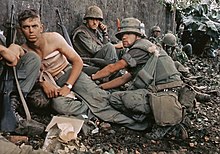
As the Vietnam War continued inconclusively and became more unpopular with the American public, morale declined and disciplinary problems grew among American enlisted men and junior, non-career officers. Drug use, racial tensions, and the growing incidence of fragging—attempting to kill unpopular officers and non-commissioned officers with grenades or other weapons—created severe problems for the U.S. military and impacted its capability of undertaking combat operations. By 1971, a U.S. Army colonel writing in the Armed Forces Journal declared: "By every conceivable indicator, our army that now remains in Vietnam is in a state approaching collapse, with individual units avoiding or having refused combat, murdering their officers and non commissioned officers, drug-ridden, and dispirited where not near mutinous....The morale, discipline, and battle-worthiness of the U.S. Armed Forces are, with a few salient exceptions, lower and worse than at any time in this century and possibly in the history of the United States."[173] Between 1969 and 1971 the U.S. Army recorded more than 900 attacks by troops on their own officers and NCOs with 99 killed.[333]:44–7
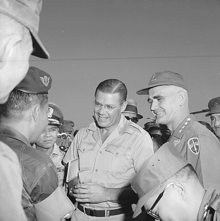
The Vietnam War called into question the U.S. Army doctrine. Marine Corps general Victor H. Krulak heavily criticised Westmoreland's attrition strategy, calling it "wasteful of American lives… with small likelihood of a successful outcome."[318] In addition, doubts surfaced about the ability of the military to train foreign forces. Furthermore, throughout the war there was found to be considerable flaws and dishonesty by officers and commanders due to promotions being tied to the body count system touted by Westmoreland and McNamara.[334] And behind the scenes Secretary of Defense McNamara wrote in a memo to President Johnson his doubts about the war: "The picture of the world's greatest superpower killing or seriously injuring 1,000 noncombatants a week, while trying to pound a tiny backward nation into submission on an issue whose merits are hotly disputed, is not a pretty one."[335]
Ron Milam has questioned the severity of the "breakdown" of the U.S. armed forces, especially among combat troops, as reflecting the opinions of "angry colonels" who deplored the erosion of traditional military values during the Vietnam War.[336]:172 Although acknowledging serious problems, he questions the alleged "near mutinous" conduct of junior officers and enlisted men in combat. Investigating one combat refusal incident, a journalist declared, "A certain sense of independence, a reluctance to behave according to the military's insistence on obedience, like pawns or puppets...The grunts [infantrymen] were determined to survive...they insisted of having something to say about the making of decisions that determined whether they might live or die."[337] The morale and discipline problems and resistance to conscription were important factors leading to the creation of an all-volunteer military force by the United States and the termination of conscription. The last conscript was inducted into the army in 1973.[338] The all-volunteer military moderated some of the coercive methods of discipline previously used to maintain order in military ranks.[333]:183
Effects of U.S. chemical defoliation
One of the most controversial aspects of the U.S. military effort in Southeast Asia was the widespread use of chemical defoliants between 1961 and 1971. They were used to defoliate large parts of the countryside to prevent the Viet Cong from being able to hide their weapons and encampments under the foliage. These chemicals continue to change the landscape, cause diseases and birth defects, and poison the food chain.[339][340]
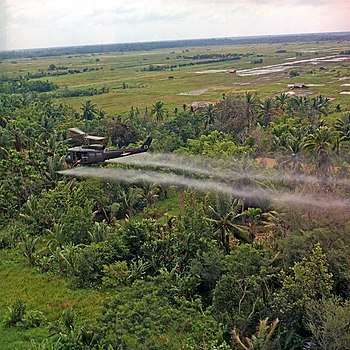
Agent Orange and similar chemical substances used by the U.S. have also caused a considerable number of deaths and injuries in the intervening years, including among the US Air Force crews that handled them. Scientific reports have concluded that refugees exposed to chemical sprays while in South Vietnam continued to experience pain in the eyes and skin as well as gastrointestinal upsets. In one study, ninety-two percent of participants suffered incessant fatigue; others reported monstrous births.[341] Meta-analyses of the most current studies on the association between Agent Orange and birth defects have found a statistically significant correlation such that having a parent who was exposed to Agent Orange at any point in their life will increase one's likelihood of either possessing or acting as a genetic carrier of birth defects.[342] The most common deformation appears to be spina bifida. There is substantial evidence that the birth defects carry on for three generations or more.[343] In 2012, the United States and Vietnam began a cooperative cleaning up of the toxic chemical on part of Danang International Airport, marking the first time Washington has been involved in cleaning up Agent Orange in Vietnam.[344]
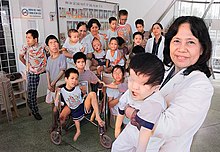
Vietnamese victims affected by Agent Orange attempted a class action lawsuit against Dow Chemical and other U.S. chemical manufacturers, but the District Court dismissed their case.[345] They appealed, but the dismissal was cemented in February 2008 by the Court of Appeals for the Second Circuit.[346] As of 2006, the Vietnamese government estimates that there are over 4,000,000 victims of dioxin poisoning in Vietnam, although the United States government denies any conclusive scientific links between Agent Orange and the Vietnamese victims of dioxin poisoning. In some areas of southern Vietnam, dioxin levels remain at over 100 times the accepted international standard.[347]
The U.S. Veterans Administration has listed prostate cancer, respiratory cancers, multiple myeloma, Diabetes mellitus type 2, B-cell lymphomas, soft-tissue sarcoma, chloracne, porphyria cutanea tarda, peripheral neuropathy and spina bifida in children of veterans exposed to Agent Orange.[348]
Casualties
| Year | U.S.[349] | South Vietnam |
|---|---|---|
| 1956–1959 | 4 | n.a. |
| 1960 | 5 | 2,223 |
| 1961 | 16 | 4,004 |
| 1962 | 53 | 4,457 |
| 1963 | 122 | 5,665 |
| 1964 | 216 | 7,457 |
| 1965 | 1,928 | 11,242 |
| 1966 | 6,350 | 11,953 |
| 1967 | 11,363 | 12,716 |
| 1968 | 16,899 | 27,915 |
| 1969 | 11,780 | 21,833 |
| 1970 | 6,173 | 23,346 |
| 1971 | 2,414 | 22,738 |
| 1972 | 759 | 39,587 |
| 1973 | 68 | 27,901 |
| 1974 | 1 | 31,219 |
| 1975 | 62 | n.a. |
| After 1975 | 7 | n.a. |
| Total | 58,220 | >254,256[36]:275 |
Estimates of the number of casualties vary, with one source suggesting up to 3.8 million violent war deaths in Vietnam for the period 1955 to 2002.[350] A detailed demographic study calculated 791,000–1,141,000 war-related deaths during the war for all of Vietnam, for both military and civilians.[27] Between 195,000 and 430,000 South Vietnamese civilians died in the war.[28]:450–3[35]: Extrapolating from a 1969 US intelligence report, Guenter Lewy estimated 65,000 North Vietnamese civilians died in the war.[28]:450–3 Estimates of civilian deaths caused by American bombing of North Vietnam in Operation Rolling Thunder range from 30,000[17]:176,617 to 182,000.[351] A 1974 US Senate subcommittee estimates nearly 1.4 million civilians killed and wounded between 1965 and 1974, and attributed over half as resulting from US and South Vietnamese military action.[27]
The military forces of South Vietnam suffered an estimated 254,256 killed between 1960 and 1974 and additional deaths from 1954 to 1959 and in 1975.[36]:275 Other estimates point to higher figures of 313,000 casualties.[77] The official US Department of Defense figure was 950,765 PAVN/VC forces killed in Vietnam from 1965 to 1974. Defense Department officials believed that these body count figures need to be deflated by 30 percent. Guenter Lewy asserts that one-third of the reported "enemy" killed may have been civilians, concluding that the actual number of deaths of PAVN/VC military forces was probably closer to 444,000.[28]:450–3
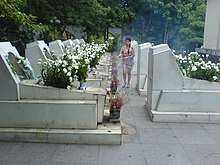
According to figures released by the Vietnamese government there were 849,018 military deaths on the PAVN/VC side during the war.[30][31] The Vietnamese government released its estimate of war deaths for the more lengthy period of 1955 to 1975. This figure includes battle deaths of Vietnamese soldiers in the Laotian and Cambodian Civil Wars, in which the PAVN was a major participant. Non-combat deaths account for 30 to 40% of these figures.[30] However, the figures do not include deaths of South Vietnamese and allied soldiers.[51] It is unclear whether the Vietnamese government figures includes the 300–330,000 PAVN/VC missing in action.[352]
US reports of "enemy KIA", referred to as body count were thought to have been subject to "falsification and glorification", and a true estimate of PAVN/VC combat deaths may be difficult to assess, as US victories were assessed by having a "greater kill ratio".[353][354] It was difficult to distinguish between civilians and military personnel on the Viet Cong side as many persons were part-time guerrillas or impressed labourers who did not wear uniforms[355][356] and civilians killed were sometimes written off as enemy killed.[167]:649–50[357] MACV rarely made a distinction between unarmed civilians and combatants, leading to counting of civilians killed as enemy casualties since it was directly tied to promotions and commendation.[358]
Between 275,000[54] and 310,000[55] Cambodians were estimated to have died during the war including between 50,000 and 150,000 combatants and civilians from US bombings.[359] 20,000–62,000 Laotians also died,[52] and 58,318 U.S. military personnel were killed,[38] of which 1,587 are still listed as missing as of July 2019.[360]
Unexploded ordnance, mostly from U.S. bombing, continues to detonate and kill people today. According to the Vietnamese government, ordnance has killed some 42,000 people since the war officially ended.[361][362] According to the government of Laos, unexploded ordnance has killed or injured over 20,000 Laotians since the end of the war.[311]
In popular culture
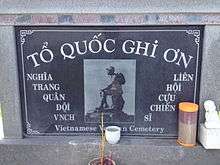
The Vietnam War has been featured extensively in television, film, video games, music and literature in the participant countries. In Vietnam, one notable film set during Operation Linebacker II was the film Girl from Hanoi (1975) depicting war-time life in Hanoi. Another notable work was the diary of Đặng Thùy Trâm, a Vietnamese doctor who enlisted in the Southern battlefield, and was killed at the age of 27 by US forces near Quảng Ngãi. Her diaries were later published in Vietnam as Đặng Thùy Trâm's Diary (Last Night I Dreamed Of Peace), where it became a best-seller and was later made into a film Don't Burn (Đừng Đốt). In Vietnam the diary has often been compared to The Diary of Anne Frank and both are used in literary education.[363] Another Vietnamese film produced was The Abandoned Field: Free Fire Zone (Cánh đồng hoang) in 1979 which weaves the narrative of living on the ground in a US "free-fire zone" as well as perspectives from US helicopters.
In American popular culture, the "Crazy Vietnam Veteran", who was suffering from posttraumatic stress disorder, became a common stock character after the war.
One of the first major films based on the Vietnam War was John Wayne's pro-war The Green Berets (1968). Further cinematic representations were released during the 1970s and 1980s, some of the most noteworthy examples being Michael Cimino's The Deer Hunter (1978), Francis Ford Coppola's Apocalypse Now (1979), Oliver Stone's Platoon (1986) – based on his service in the U.S. Army during the Vietnam War, Stanley Kubrick's Full Metal Jacket (1987). Other Vietnam War films include Hamburger Hill (1987), Casualties of War (1989), Born on the Fourth of July (1989) The Siege of Firebase Gloria (1989), Forrest Gump (1994), We Were Soldiers (2002) and Rescue Dawn (2007).[17]:
The war also influenced a generation of musicians and songwriters in Vietnam and the United States, both anti-war and pro/anti-communist. The band Country Joe and the Fish recorded The "Fish" Cheer/I-Feel-Like-I'm-Fixin'-to-Die Rag in 1965, and it became one of the most influential anti-Vietnam protest anthems.[17]: Many songwriters and musicians supported the anti-war movement, including Pete Seeger, Joan Baez, Bob Dylan, Peggy Seeger, Ewan MacColl, Barbara Dane, The Critics Group, Phil Ochs, John Lennon, John Fogerty, Nina Simone, Neil Young, Tom Paxton, Jimmy Cliff and Arlo Guthrie. The modern classical composer George Crumb composed a string quartet, a threnody, regarding the war in 1970 titled Black Angels.
The war is also depicted in popular video games, especially in the first-person shooter war genre, such as Line of Sight: Vietnam (2003), Vietcong (2003), Battlefield Vietnam (2004), Vietcong: Fist Alpha (2004), Vietcong 2 (2005), Elite Warriors: Vietnam (2005), The Hell in Vietnam (2008), Battlefield: Bad Company 2: Vietnam (2010), Call of Duty: Black Ops (2010), Call of Duty: Black Ops: Declassified (2012), Rising Storm 2: Vietnam (2017), and in Far Cry 5 (2018) as an additional content. The war also saw depiction in another genre, in the form of third-person shooters, MMORPG, real-time strategy and role-playing, such as Rambo: First Blood Part II (1985), Caliber .50 (1989), Made Man (2006), Gunboat (1990) and Strike Fighters 2: Vietnam (2009).
Myths
Myths play a central role in the historiography of the Vietnam War, and have become a part of the culture of the United States. Much like the general historiography of the war, discussion of myth has focused on U.S. experiences, but changing myths of war have also played a role in Vietnamese and Australian historiography.
Recent scholarship has focused on "myth-busting",[336]:373 attacking the previous orthodox and revisionist schools of American historiography of the Vietnam War. This scholarship challenges myths about American society and soldiery in the Vietnam War.[336]:373
Kuzmarov in The Myth of the Addicted Army: Vietnam and the Modern War on Drugs challenges the popular and Hollywood narrative that US soldiers were heavy drug users,[364] in particular the notion that the My Lai massacre was caused by drug use.[336]:373 According to Kuzmarov, Richard Nixon is primarily responsible for creating the drug myth.[336]:374
Michael Allen in Until The Last Man Comes Home also accuses Nixon of myth making, by exploiting the plight of the League of Wives of American Prisoners in Vietnam and the National League of Families of American Prisoners and Missing in Southeast Asia to allow the government to appear caring as the war was increasingly considered lost.[336]:376 Allen's analysis ties the position of potential missing or prisoner Americans into post-war politics and recent presidential elections, including the Swift boat controversy in US electoral politics.[336]:376–7
Commemoration
On 25 May 2012, President Barack Obama issued a proclamation of the commemoration of the 50th Anniversary of the Vietnam War.[365][366] On 10 November 2017, President Donald Trump issued an additional proclamation commemorating the 50th Anniversary of the Vietnam War.[367][368]
See also
- History of Cambodia
- History of Laos
- History of Vietnam
- List of conflicts in Asia
- Opposition to United States involvement in the Vietnam War
- U.S. news media and the Vietnam War
- The Vietnam War (TV series)
Annotations
- Due to the early presence of U.S. troops in Vietnam the start date of the Vietnam War is a matter of debate. In 1998, after a high level review by the Department of Defense (DoD) and through the efforts of Richard B. Fitzgibbon's family the start date of the Vietnam War according to the US government was officially changed to 1 November 1955.[1] U.S. government reports currently cite 1 November 1955 as the commencement date of the "Vietnam Conflict", because this date marked when the U.S. Military Assistance Advisory Group (MAAG) in Indochina (deployed to Southeast Asia under President Truman) was reorganized into country-specific units and MAAG Vietnam was established.[2]:20 Other start dates include when Hanoi authorized Viet Cong forces in South Vietnam to begin a low-level insurgency in December 1956,[3] whereas some view 26 September 1959, when the first battle occurred between the Viet Cong and the South Vietnamese army, as the start date.[4]
- Upper figure initial estimate, later thought to be inflated by at least 30% (lower figure)[27][28]:450–3
- The figures of 58,220 and 303,644 for U.S. deaths and wounded come from the Department of Defense Statistical Information Analysis Division (SIAD), Defense Manpower Data Center, as well as from a Department of Veterans fact sheet dated May 2010; the total is 153,303 WIA excluding 150,341 persons not requiring hospital care[41] the CRS (Congressional Research Service) Report for Congress, American War and Military Operations Casualties: Lists and Statistics, dated 26 February 2010,[42] and the book Crucible Vietnam: Memoir of an Infantry Lieutenant.[2]:65,107,154,217 Some other sources give different figures (e.g. the 2005/2006 documentary Heart of Darkness: The Vietnam War Chronicles 1945–1975 cited elsewhere in this article gives a figure of 58,159 U.S. deaths,[43] and the 2007 book Vietnam Sons gives a figure of 58,226)[44]
- The Military Assistance Advisory Group, Indochina (with an authorized strength of 128 men) was set up in September 1950 with a mission to oversee the use and distribution of US military equipment by the French and their allies.
- On 8 March 1965 the first American combat troops, the Third Marine Regiment, Third Marine Division, began landing in Vietnam to protect the Da Nang Air Base.[183][184]
References
The references for this article are grouped in three sections.
- Citations: references for the in-line, numbered superscript references contained within the article.
- Primary sources: the main works used to build the content of the article, but not referenced as in-line citations.
- Secondary sources: additional works used to build the article
Citations
- "Name of Technical Sergeant Richard B. Fitzgibbon to be added to the Vietnam Veterans Memorial". Department of Defense (DoD). Archived from the original on 20 October 2013.
- Lawrence, A.T. (2009). Crucible Vietnam: Memoir of an Infantry Lieutenant. McFarland. ISBN 978-0786445172.
- Olson & Roberts 2008, p. 67.
- Origins of the Insurgency in South Vietnam, 1954–1960, The Pentagon Papers (Gravel Edition), Volume 1, Chapter 5, (Boston: Beacon Press, 1971), Section 3, pp. 314–46; International Relations Department, Mount Holyoke College.
- The Paris Agreement on Vietnam: Twenty-five Years Later Conference Transcript, The Nixon Center, Washington, DC, April 1998. Reproduced on mtholyoke.edu. Accessed 5 September 2012.
- "Why did Sweden support the Viet Cong?". HistoryNet. 25 July 2013. Retrieved 20 July 2016.
- "Sweden announces support to Viet Cong". HISTORY.com. Retrieved 20 July 2016.
In Sweden, Foreign Minister Torsten Nilsson reveals that Sweden has been providing assistance to the Viet Cong, including some $550,000 worth of medical supplies. Similar Swedish aid was to go to Cambodian and Laotian civilians affected by the Indochinese fighting. This support was primarily humanitarian in nature and included no military aid.
- Moise, Edwin E. (1996). Tonkin Gulf and the Escalation of the Vietnam War. Univ of North Carolina Press. pp. 3–4. ISBN 978-0-8078-2300-2.
- "Chapter Three: 1957–1969 Early Relations between Malaysia and Vietnam" (PDF). University of Malaya Student Repository. p. 72. Retrieved 17 October 2015.
- Tunku Abdul Rahman Putra Al-Haj (Profiles of Malaysia's Foreign Ministers) (PDF). Institute of Diplomacy and Foreign Relations (IDFR), Ministry of Foreign Affairs (Malaysia). 2008. p. 31. ISBN 978-9832220268. Archived from the original (PDF) on 16 October 2015. Retrieved 17 October 2015.
The Tunku had been personally responsible for Malaya's partisan support of the South Vietnamese regime in its fight against the Vietcong and, in reply to a Parliamentary question on 6 February 1962, he had listed all the used weapons and equipment of the Royal Malaya Police given to Saigon. These included a total of 45,707 single-barrel shotguns, 611 armoured cars and smaller numbers of carbines and pistols. Writing in 1975, he revealed that "we had clandestinely been giving 'aid' to Vietnam since early 1958. Published American archival sources now reveal that the actual Malaysian contributions to the war effort in Vietnam included the following: "over 5,000 Vietnamese officers trained in Malaysia; training of 150 U.S. soldiers in handling Tracker Dogs; a rather impressive list of military equipment and weapons given to Viet-Nam after the end of the Malaysian insurgency (for example, 641 armored personnel carriers, 56,000 shotguns); and a creditable amount of civil assistance (transportation equipment, cholera vaccine, and flood relief)". It is undeniable that the Government's policy of supporting the South Vietnamese regime with arms, equipment and training was regarded by some quarters, especially the Opposition parties, as a form of interfering in the internal affairs of that country and the Tunku's valiant efforts to defend it were not convincing enough, from a purely foreign policy standpoint.
- According to Hanoi's official history, the Viet Cong was a branch of the People's Army of Vietnam
Military History Institute of Vietnam Victory in Vietnam: The Official History of the People's Army of Vietnam, 1954–1975. Translated by Merle Pribbenow. University of Kansas Press. 2002. ISBN 0700611754.By the end of 1966 the total strength of our armed forces was 690,000 soldiers.
- Doyle, Edward; Lipsman, Samuel; Maitland, Terence (1986). The Vietnam Experience The North. Time Life Education. pp. 45–9. ISBN 978-0939526215.
- Moïse, Edwin (2005). The A to Z of the Vietnam War. The Scarecrow Press. ISBN 978-1461719038.
- "China admits 320,000 troops fought in Vietnam". Toledo Blade. Reuters. 16 May 1989. Retrieved 24 December 2013.
- Roy, Denny (1998). China's Foreign Relations. Rowman & Littlefield. p. 27. ISBN 978-0847690138.
- Womack, Brantly (2006). China and Vietnam. p. 179. ISBN 978-0521618342.
- Tucker, Spencer C (2011). The Encyclopedia of the Vietnam War: A Political, Social, and Military History. ABC-CLIO. ISBN 978-1851099603.
- "Area Handbook Series Laos". Retrieved 1 November 2019.
- O'Ballance, Edgar (1982). Tracks of the bear: Soviet imprints in the seventies. Presidio. p. 171. ISBN 9780891411338.
- Pham Thi Thu Thuy (1 August 2013). "The colorful history of North Korea-Vietnam relations". NK News. Retrieved 3 October 2016.
- Le Gro, William (1985). Vietnam from ceasefire to capitulation (PDF). US Army Center of Military History. p. 28. ISBN 9781410225429.
- Pike, John. "Cambodia Civil War, 1970s". www.globalsecurity.org.
- "The rise of Communism". www.footprinttravelguides.com. Archived from the original on 17 November 2010. Retrieved 31 May 2018.
- "Hmong rebellion in Laos".
- "Vietnam War Allied Troop Levels 1960–73". Archived from the original on 2 August 2016. Retrieved 2 August 2016., accessed 7 November 2017
- Pike, John. "Pathet Lao Uprising".
- Hirschman, Charles; Preston, Samuel; Vu, Manh Loi (December 1995). "Vietnamese Casualties During the American War: A New Estimate" (PDF). Population and Development Review. 21 (4): 783. doi:10.2307/2137774. JSTOR 2137774.
- Lewy, Guenter (1978). America in Vietnam. Oxford University Press. ISBN 9780199874231.
- "Battlefield:Vietnam – Timeline". PBS.
- "Chuyên đề 4 CÔNG TÁC TÌM KIẾM, QUY TẬP HÀI CỐT LIỆT SĨ TỪ NAY ĐẾN NĂM 2020 VÀ NHỮNG NĂM TIẾP THEO".
- "Công tác tìm kiếm, quy tập hài cốt liệt sĩ từ nay đến năm 2020 và những năn tiếp theo" [The work of searching and collecting the remains of martyrs from now to 2020 and the next] (in Vietnamese). Ministry of Defence, Government of Vietnam.
- Hastings, Max (2018). Vietnam an epic tragedy, 1945-1975. Harper Collins. ISBN 978-0062405678.
- James F. Dunnigan; Albert A. Nofi (2000). Dirty Little Secrets of the Vietnam War: Military Information You're Not Supposed to Know. Macmillan. ISBN 978-0-312-25282-3.
- "North Korea fought in Vietnam War". BBC News Online. 31 March 2000. Retrieved 18 October 2015.
- Thayer, Thomas C. (1985). War Without Fronts: The American Experience in Vietnam. Westview Press. ISBN 978-0813371320.
- Clarke, Jeffrey J. (1988). United States Army in Vietnam: Advice and Support: The Final Years, 1965–1973. Center of Military History, United States Army.
The Army of the Republic of Vietnam suffered 254,256 recorded combat deaths between 1960 and 1974, with the highest number of recorded deaths being in 1972, with 39,587 combat deaths
- Rummel, R.J (1997), "Table 6.1A. Vietnam Democide : Estimates, Sources, and Calculations" (GIF), Freedom, Democracy, Peace; Power, Democide, and War, University of Hawaii System
- Vietnam Veterans Memorial Fund (29 May 2017). "3 new names added to Vietnam Veterans Memorial wall" (Press release). Associated Press.
- National Archives–Vietnam War U.S. Military Fatal Casualties, retrieved 29 July 2020
- "Vietnam War U.S. Military Fatal Casualty Statistics: HOSTILE OR NON-HOSTILE DEATH INDICATOR." U.S. National Archives. 29 April 2008. Accessed 13 July 2019.
- America's Wars (PDF) (Report). Department of Veterans Affairs. May 2010. Archived from the original (PDF) on 24 January 2014.
- Anne Leland; Mari–Jana "M-J" Oboroceanu (26 February 2010). American War and Military Operations: Casualties: Lists and Statistics (PDF) (Report). Congressional Research Service.
- Aaron Ulrich (editor); Edward FeuerHerd (producer and director) (2005, 2006). Heart of Darkness: The Vietnam War Chronicles 1945–1975 (Box set, Color, Dolby, DVD-Video, Full Screen, NTSC, Dolby, Vision Software) (Documentary). Koch Vision. Event occurs at 321 minutes. ISBN 1417229209.
- Kueter, Dale (2007). Vietnam Sons: For Some, the War Never Ended. AuthorHouse. ISBN 978-1425969318.
- T. Lomperis, From People's War to People's Rule (1996)
- "Australian casualties in the Vietnam War, 1962–72". Australian War Memorial. Retrieved 29 June 2013.
- "Overview of the war in Vietnam". New Zealand and the Vietnam War. 16 July 1965. Archived from the original on 26 July 2013. Retrieved 29 June 2013.
- "America Wasn't the Only Foreign Power in the Vietnam War". 2 October 2013. Retrieved 10 June 2017.
- Larsen, Stanley (1975). Vietnam Studies Allied Participation in Vietnam (PDF). Department of the Army. ISBN 978-1517627249.
- "Asian Allies in Vietnam" (PDF). Embassy of South Vietnam. March 1970. Retrieved 18 October 2015.
- Shenon, Philip (23 April 1995). "20 Years After Victory, Vietnamese Communists Ponder How to Celebrate". The New York Times. Retrieved 24 February 2011.
The Vietnamese government officially claimed a rough estimate of 2 million civilian deaths, but it did not divide these deaths between those of North and South Vietnam.
- Obermeyer, Ziad; Murray, Christopher J L; Gakidou, Emmanuela (23 April 2008). "Fifty years of violent war deaths from Vietnam to Bosnia: analysis of data from the world health survey programme". British Medical Journal. 336 (7659): 1482–1486. doi:10.1136/bmj.a137. PMC 2440905. PMID 18566045. Retrieved 5 January 2013.
From 1955 to 2002, data from the surveys indicated an estimated 5.4 million violent war deaths ... 3.8 million in Vietnam
- Heuveline, Patrick (2001). "The Demographic Analysis of Mortality Crises: The Case of Cambodia, 1970–1979". Forced Migration and Mortality. National Academies Press. pp. 102–04, 120, 124. ISBN 978-0309073349.
As best as can now be estimated, over two million Cambodians died during the 1970s because of the political events of the decade, the vast majority of them during the mere four years of the 'Khmer Rouge' regime. ... Subsequent reevaluations of the demographic data situated the death toll for the [civil war] in the order of 300,000 or less.
- Banister, Judith; Johnson, E. Paige (1993). Genocide and Democracy in Cambodia: The Khmer Rouge, the United Nations and the International Community. Yale University Southeast Asia Studies. p. 97. ISBN 978-0938692492.
An estimated 275,000 excess deaths. We have modeled the highest mortality that we can justify for the early 1970s.
- Sliwinski, Marek (1995). Le Génocide Khmer Rouge: Une Analyse Démographique [The Khmer Rouge genocide: A demographic analysis]. L'Harmattan. pp. 42–43, 48. ISBN 978-2738435255.
- Factasy. "The Vietnam War or Second Indochina War". PRLog. Retrieved 29 June 2013.
- "Vietnam War". Encyclopædia Britannica. Retrieved 5 March 2008.
Meanwhile, the United States, its military demoralized and its civilian electorate deeply divided, began a process of coming to terms with defeat in its longest and most controversial war
- Friedman, Herbert. "Allies of the Republic of Vietnam". Retrieved 1 May 2019.
- Lind, Michael (1999). "Vietnam, The Necessary War: A Reinterpretation of America's Most Disastrous Military Conflict". The New York Times. Retrieved 17 January 2014.
- Eckhardt, George (1991). Vietnam Studies Command and Control 1950–1969. Department of the Army. p. 6.
- "Could Vietnam have been nuked in 1954?". BBC News. 5 May 2014 – via www.bbc.com.
- Ang, Cheng Guan (2002). The Vietnam War from the Other Side. RoutledgeCurzon. ISBN 978-0700716159.
- "Vietnam War Allied Troop Levels 1960–73". Archived from the original on 2 August 2016. Retrieved 1 June 2018.
- Li, Xiaobing (2010). Voices from the Vietnam War: Stories from American, Asian, and Russian Veterans. University Press of Kentucky. p. 85. ISBN 978-0-8131-7386-3.
- Kiernan, Ben. "Viet Nam: A History from Earliest Times to the Present". Oxford University Press, Feb. 2017, page 447.
- Kolko, Gabriel (1985). Anatomy of a War: Vietnam, the United States, and the Modern Historical Experience. Pantheon Books. ISBN 978-0394747613.
- Pilger, John (2001). Heroes. South End Press. p. 238. ISBN 9780896086661.
- Kalb, Marvin (22 January 2013). "It's Called the Vietnam Syndrome, and It's Back". Brookings Institution. Retrieved 12 June 2015.
- Horne, Alistair (2010). Kissinger's Year: 1973. Phoenix Press. pp. 370–1. ISBN 978-0753827000.
- Meaker, Scott S.F. (2015). Unforgettable Vietnam War: The American War in Vietnam – War in the Jungle. ISBN 978-1312931589.
- "Asian-Nation: Asian American History, Demographics, & Issues:: The American / Viet Nam War". Retrieved 18 August 2008.
The Viet Nam War is also called 'The American War' by the Vietnamese
- Ellsberg, Daniel (2 February 2018). "The doomsday machine – Talks at Google (February 2018)". Talks at google. Google / Daniel Ellsberg. Retrieved 1 June 2018.
- McNamara, Robert S.; Blight, James G.; Brigham, Robert K.; Biersteker, Thomas J.; Schandler, Herbert (1999). Argument Without End: In Search of Answers to the Vietnam Tragedy. PublicAffairs. ISBN 978-1891620874.
- "The History Place – Vietnam War 1945–1960". Retrieved 11 June 2008.
- Herring, George C. (2001). America's Longest War: The United States and Vietnam, 1950–1975 (4th ed.). McGraw-Hill. ISBN 978-0072536188.
- Maclear, Michael (1981). The Ten Thousand Day War: Vietnam 1945-1975. Thames. p. 57. ISBN 978-0312790943.
- The Pentagon Papers. Gravel, ed. vol. 1, pp. 391–404.
- "China Contributed Substantially to Vietnam War Victory, Claims Scholar". Wilson Center. 1 January 2001. Retrieved 20 May 2018.
- John Prados. "The Numbers Game: How Many Vietnamese Fled South In 1954?". The VVA Veteran (January/February 2005). Archived from the original on 27 May 2006. Retrieved 11 May 2017.
- Kinzer, Stephen (2013). The Brothers: John Foster Dulles, Allen Dulles, and Their Secret World War. Macmillan. pp. 195–6. ISBN 978-1429953528.
- Patrick, Johnson, David (2009). Selling "Operation Passage to Freedom": Dr. Thomas Dooley and the Religious Overtones of Early American Involvement in Vietnam (Thesis). University of New Orleans.
- Murti, B.S.N. (1964). Vietnam Divided. Asian Publishing House.
- Karnow, Stanley (1997). Vietnam: A History (2nd ed.). Penguin Books. ISBN 978-0140265477.
- Turner, Robert F. (1975). Vietnamese Communism: Its Origins and Development. Hoover Institution Press. ISBN 978-0817964313.
- Gittinger, J. Price (1959). "Communist Land Policy in North Viet Nam". Far Eastern Survey. 28 (8): 113–126. doi:10.2307/3024603. JSTOR 3024603.
- Courtois, Stephane; et al. (1997). The Black Book of Communism. Harvard University Press. ISBN 978-0674076082.
- Dommen, Arthur J. (2001). The Indochinese Experience of the French and the Americans. Indiana University Press. p. 340. ISBN 978-0253338549.
- "Newly released documents on the land reform". Vietnam Studies Group. Archived from the original on 20 April 2011. Retrieved 15 July 2016.
Vu Tuong: There is no reason to expect, and no evidence that I have seen to demonstrate, that the actual executions were less than planned; in fact the executions perhaps exceeded the plan if we consider two following factors. First, this decree was issued in 1953 for the rent and interest reduction campaign that preceded the far more radical land redistribution and party rectification campaigns (or waves) that followed during 1954–1956. Second, the decree was meant to apply to free areas (under the control of the Viet Minh government), not to the areas under French control that would be liberated in 1954–1955 and that would experience a far more violent struggle. Thus the number of 13,500 executed people seems to be a low-end estimate of the real number. This is corroborated by Edwin Moise in his recent paper "Land Reform in North Vietnam, 1953–1956" presented at the 18th Annual Conference on SE Asian Studies, Center for SE Asian Studies, University of California, Berkeley (February 2001). In this paper Moise (7–9) modified his earlier estimate in his 1983 book (which was 5,000) and accepted an estimate close to 15,000 executions. Moise made the case based on Hungarian reports provided by Balazs, but the document I cited above offers more direct evidence for his revised estimate. This document also suggests that the total number should be adjusted up some more, taking into consideration the later radical phase of the campaign, the unauthorized killings at the local level, and the suicides following arrest and torture (the central government bore less direct responsibility for these cases, however).
cf. Szalontai, Balazs (November 2005). "Political and Economic Crisis in North Vietnam, 1955–56". Cold War History. 5 (4): 395–426. doi:10.1080/14682740500284630. cf. Vu, Tuong (2010). Paths to Development in Asia: South Korea, Vietnam, China, and Indonesia. Cambridge University Press. p. 103. ISBN 978-1139489010.Clearly Vietnamese socialism followed a moderate path relative to China. ... Yet the Vietnamese 'land reform' campaign ... testified that Vietnamese communists could be as radical and murderous as their comrades elsewhere.
- The Pentagon Papers. 3. Beacon Press. 1971.
- Eisenhower, Dwight D. (1963). Mandate for Change. Doubleday & Company. p. 372.
- Turner, Robert F. (1990). "Myths and Realities in the Vietnam Debate". The Vietnam Debate: A Fresh Look at the Arguments. University Press of America. ISBN 978-0819174161.
- Woodruff 2005, p. 6 states: "The elections were not held. South Vietnam, which had not signed the Geneva Accords, did not believe the Communists in North Vietnam would allow a fair election. In January 1957, the International Control Commission (ICC), comprising observers from India, Poland, and Canada, agreed with this perception, reporting that neither South nor North Vietnam had honored the armistice agreement. With the French gone, a return to the traditional power struggle between north and south had begun again."
- "America's Stakes in Vietnam Speech to the American Friends of Vietnam, June 1956". JFK Library. Archived from the original on 26 June 2012. Retrieved 26 June 2012.
- "The Pentagon Papers Gravel Edition Volume 1, Chapter 5, "Origins of the Insurgency in South Vietnam, 1954–1960"". Mtholyoke.edu. Retrieved 31 October 2011.
- "Excerpts from Law 10/59, 6 May 1959". Archived from the original on 23 July 2008.
- Young, Marilyn (1991). The Vietnam Wars: 1945–1990. Harper Perennial. ISBN 978-0060921071.
- Prados 2006.
- "It's Time to Stop Saying that JFK Inherited the Bay of Pigs Operation from Ike". History News Network. 12 May 2015.
- The case of John F. Kennedy and Vietnam Presidential Studies Quarterly.
- Mann, Robert. A Grand Delusion, Basic Books, 2002.
- VTF 1969, IV. B. 4., pp. 1–2
- Stavins, Ralph L. (22 July 1971). "A Special Supplement: Kennedy's Private War". The New York Review of Books. ISSN 0028-7504. Retrieved 2 December 2017.
- John Kenneth Galbraith. "Memorandum to President Kennedy from John Kenneth Galbraith on Vietnam, 4 April 1962." The Pentagon Papers. Gravel. ed. Boston, Massachusetts Beacon Press, 1971, vol. 2. pp. 669–71.
- Sheehan, Neil (1989). A Bright Shining Lie – John Paul Vann and the American War in Vietnam. Vintage. ISBN 978-0679724148.
- Live interview by John Bartlow Martin. Was Kennedy Planning to Pull out of Vietnam? New York City. John F. Kennedy Library, 1964, Tape V, Reel 1.
- James Gibson (1986). "The Perfect War: Technowar in Vietnam". The Atlantic Monthly Press. p. 88.
- "Foreign Relations of the United States, 1961–1963, Volume IV, Vietnam, August–December 1963 - Office of the Historian". history.state.gov.
- Demma 1989.
- "Counterinsurgency in Vietnam: Lessons for Today | the Foreign Service Journal - April 2015".
- "Pacification | Vietnam War Dictionary".
- Blaufarb, Douglas S. (1977). The Counterinsurgency Era: U.S. Doctrine and Performance, 1950 to the Present. Free Press. p. 119. ISBN 978-0029037003.
- Schandler, Herbert Y. (2009). (2009). America in Vietnam: The War That Couldn't Be Won. Rowman & Littlefield. p. 36. ISBN 978-0742566972.
- Southworth, Samuel; Tanner, Stephen (2002). U.S. Special Forces: A Guide to America's Special Operations Units: the World's Most Elite Fighting Force. Da Capo Press. ISBN 978-0306811654.
- Warner, Roger (1996). Shooting at the Moon The story of America's clandestine war in Laos. Steerforth Press. ISBN 978-1883642365.
- Karnow 1997, pp. 336–39.
Johnson viewed many members that he inherited from Kennedy's cabinet with distrust because he had never penetrated their circle during Kennedy's presidency; to Johnson's mind, those like W. Averell Harriman and Dean Acheson spoke a different language. - Shortly after the assassination of Kennedy, when McGeorge Bundy called LBJ on the phone, LBJ responded: "Goddammit, Bundy. I've told you that when I want you I'll call you." Brian VanDeMark, Into the Quagmire (New York: Oxford University Press, 1995), 13.
- Karnow 1997, p. 339.
Before a small group, including Henry Cabot Lodge, the new president also said, "We should stop playing cops and robbers [a reference to Diệm's failed leadership] and get back to… winning the war ... tell the generals in Saigon that Lyndon Johnson intends to stand by our word…[to] win the contest against the externally directed and supported Communist conspiracy." - Karnow 1997, p. 339: "At a place called Hoa Phu, for example, the strategic hamlet built during the previous summer now looked like it had been hit by a hurricane. ... Speaking through an interpreter, a local guard explained to me that a handful of Viet Cong agents had entered the hamlet one night and told the peasants to tear it down and return to their native villages. The peasants complied without question."
- Hunt, Michael (2016). The World Transformed – 1945 to the Present. New York: Oxford. pp. 169–71. ISBN 978-0199371020.
- Kutler, Stanley I. (1996). Encyclopedia of the Vietnam War. Charles Scribner's Sons. p. 249. ISBN 978-0132769327.
- Scott Shane (31 October 2005). "Vietnam Study, Casting Doubts, Remains Secret". The New York Times. Retrieved 13 September 2013.
- Moïse, Edwin E. (1996). Tonkin Gulf and the Escalation of the Vietnam War. University of North Carolina Press. ISBN 978-0807823002.
- Simon, Dennis M. (August 2002). "The War in Vietnam, 1965–1968". Archived from the original on 26 April 2009. Retrieved 7 May 2009.
- Nalty 1998, pp. 97, 261.
- Tilford, Earl L. (1991). Setup: What the Air Force did in Vietnam and Why (PDF). Air University Press. p. 89.
- Kiernan, Ben; Owen, Taylor (26 April 2015). "Making More Enemies than We Kill? Calculating U.S. Bomb Tonnages Dropped on Laos and Cambodia, and Weighing Their Implications". The Asia-Pacific Journal. Retrieved 18 September 2016.
- Vietnam War After Action Reports. BACM Research.
- Kahin, George; Lewis, John W. (1967). The United States in Vietnam: An analysis in depth of the history of America's involvement in Vietnam. Delta Books.
- Moyar, Mark (2006). Triumph Forsaken: The Vietnam War, 1954–1965. Cambridge University Press. p. 339. ISBN 978-0521869119.
- McNeill, Ian (1993). To Long Tan: The Australian Army and the Vietnam War 1950–1966. Allen & Unwin. ISBN 978-1863732826.
- "Generations Divide Over Military Action in Iraq". Pew Research Center. October 2002. Cite journal requires
|journal=(help)CS1 maint: ref=harv (link) - U.S. Department of Defense, U.S.–Vietnam Relations vol. 4, p. 7.
- U.S. Department of Defense, U.S.–Vietnam Relations vol. 5, pp. 8–9.
- U.S. Department of Defense, U.S.-Vietnam Relations vol. 4, pp. 117–19. and vol. 5, pp. 8–12.
- Public Papers of the Presidents, 1965. Washington, DC Government Printing Office, 1966, vol. 2, pp. 794–99.
- Mohr, Charles. "McNamara on Record, Reluctantly, on Vietnam".
- Courtwright (2005)
- Church, Peter (2006). A Short History of South-East Asia. John Wiley & Sons. p. 193. ISBN 978-0470824818.
- Joseph Galloway (18 October 2010). "Ia Drang – The Battle That Convinced Ho Chi Minh He Could Win". Historynet. Retrieved 2 May 2016.
- Elliott, Mai (2018). "The Terrible Violence of 'Pacification'". The New York Times. ISSN 0362-4331. Retrieved 8 June 2018.
- Ward, Geoffrey C.; Burns, Ken (2017). The Vietnam War: An Intimate History. Alfred A. Knopf. ISBN 9780307700254.
- "The Pentagon Papers, Gravel Edition, Volume 4, Chapter 2, "US Ground Strategy and Force Deployments, 1965–1968, pp. 277–604, 4th section". www.mtholyoke.edu. Retrieved 12 June 2018.
- "TWE Remembers: General Westmoreland Says the "End Begins to Come Into View" in Vietnam". Council on Foreign Relations. Retrieved 12 June 2018.
- "Interview with NVA General Tran Van Tra | HistoryNet". www.historynet.com. 12 June 2006. Retrieved 1 June 2018.
- "The Urban Movement and the Planning and Execution of the Tet Offensive". Wilson Center. 20 October 2014. Retrieved 1 June 2018.
- Nguyen, Lien-Hang T. (2012). Hanoi's War: An International History of the War for Peace in Vietnam. Univ of North Carolina Press. ISBN 978-0807882696.
- Wiest, Andrew (1 March 2018). "Opinion | The Tet Offensive Was Not About Americans". The New York Times. ISSN 0362-4331. Retrieved 1 June 2018.
- Bowden, Mark (2017). Hue 1968 A turning point of the American war in Vietnam. Atlantic Monthly Press.
- Hosmer, Stephen T. (1970). Viet Cong Repression and its Implications for the Future. Rand Corporation. pp. 72–8.
- Villard, Erik B. (2008). The 1968 Tet Offensive Battles of Quang Tri City and Hue (PDF). U.S. Army Center of Military History. ISBN 978-1514285220.
- Ankony, Robert C. (2009). Lurps: A Ranger's Diary of Tet, Khe Sanh, A Shau, and Quang Tri. Rowman & Littlefield Publishing Group. ISBN 978-0761832812.
- Keyes, Ralph (2006). The Quote Verifier: Who Said What, Where, and When. St. Martin's Griffin. ISBN 978-0312340049.
- "Survivors Hunt Dead of Bentre, Turned to Rubble in Allied Raids". The New York Times.
- Triều, Họ Trung (5 June 2017). "Lực lượng chính trị và đấu tranh chính trị ở thị xã Nha Trang trong cuộc Tổng tiến công và nổi dậy Tết Mậu Thân 1968". Hue University Journal of Science: Social Sciences and Humanities. 126 (6). doi:10.26459/hujos-ssh.v126i6.3770. ISSN 2588-1213.
- "Tết Mậu Thân 1968 qua những số liệu" (in Vietnamese). Retrieved 1 June 2018.
- Eyraud, Henri (March 1987). "Anatomy of a War: Vietnam, the United States, and the Modern Historical Experience. By Kolko Gabriel. [New York: Pantheon Books, 1985. 628 pp.]". The China Quarterly. 109: 135. doi:10.1017/s0305741000017653. ISSN 0305-7410.
- Witz (1994). The Tet Offensive: Intelligence Failure in War. Cornell University Press. pp. 1–2. ISBN 978-0801482090.
- Berman, Larry (1991). Lyndon Johnson's War. W.W. Norton. p. 116.
- Sanger, David E. (6 October 2018). "U.S. General Considered Nuclear Response in Vietnam War, Cables Show". The New York Times. Retrieved 8 October 2018.
- Sorley, Lewis (1999). A Better War: The Unexamined Victories and Final Tragedy of America's Last Years in Vietnam. Harvest. pp. 11–6. ISBN 0156013096.
- "North Vietnam's "Talk-Fight" Strategy and the 1968 Peace Negotiations with the United States". Wilson Center. 16 April 2012. Retrieved 1 June 2018.
- Command Magazine Issue 18, p. 15.
- Johns, Andrew (2010). Vietnam's Second Front: Domestic Politics, the Republican Party, and the War. University Press of Kentucky. p. 198. ISBN 978-0-8131-7369-6.
- Sagan, Scott Douglas; Suri, Jeremi (16 June 2003). "The Madman Nuclear Alert: Secrecy, Signaling, and Safety in October 1969". International Security. 27 (4): 150–83. doi:10.1162/016228803321951126. ISSN 1531-4804.
- Evans, Michael. "Nixon's Nuclear Ploy". nsarchive2.gwu.edu. Retrieved 8 February 2018.
- "Ho Chi Minh Dies of Heart Attack in Hanoi". The Times. 4 September 1969. p. 1.
- Currey, Cecil B. (2005). Victory at Any Cost: The Genius of Viet Nam's Gen. Vo Nguyen Giap. Potomac Books, Inc. ISBN 978-1574887426.
- Stein, Jeff (1992). A Murder in Wartime: The Untold Spy Story that Changed the Course of the Vietnam War. St. Martin's Press. pp. 60–2. ISBN 978-0312070373.
- Bob Seals (2007). "The "Green Beret Affair": A Brief Introduction".
- USA.gov (February 1997). "The Pentagon Papers Case". eJournal USA. 2 (1). Archived from the original on 12 January 2008. Retrieved 27 April 2010.CS1 maint: ref=harv (link)
- Stewart, Richard. American Military History, Volume II, The United States Army in a Global Era, 1917–2003. United States Army Center of Military History. ISBN 978-0160725418.
- Daddis, Gregory A. (2017). Withdrawal: Reassessing America's Final Years in Vietnam. Oxford University Press. ISBN 978-0190691103.
- Heinl, Jr., Robert D. (7 June 1971). "The Collapse of the Armed Forces" (PDF). Armed Forces Journal.
- Sevy, Grace (1991). The American Experience in Vietnam: A Reader. University of Oklahoma Press. p. 172. ISBN 978-0806123905.
- Richard Halloran. "R.O.T.C. Booming as Memories of Vietnam Fade". Retrieved 14 June 2018.
- "General Won't Punish G.I.'s for Refusing Orders". Associated Press. Retrieved 13 June 2018.
- Robert, Graham (1984). "Vietnam: An Infantryman's View of Our Failure" (PDF). Military Affairs. 48 (3 (Jul. 1984)): 133–9. doi:10.2307/1987487. JSTOR 1987487.
- Stanton, Shelby L. (2007). The Rise and Fall of an American Army: U.S. Ground Forces in Vietnam, 1963–1973. Random House Publishing Group. ISBN 9780307417343.
- "Vietnamization: 1970 Year in Review". UPI.com. Archived from the original on 31 August 2011.
- Wiest, Andrew (2007). Vietnam's Forgotten Army: Heroism and Betrayal in the ARVN. NYU Press. pp. 124–40. ISBN 978-0814794517.
- Porter, Gareth (1993). Vietnam: The Politics of Bureaucratic Socialism. p. 26. ISBN 978-0801421686.
- Stanton, Shelby L. (2003). Vietnam order of battle. Stackpole Books. ISBN 978-0811700719.
- Willbanks 2009, p. 110
- "Facts about the Vietnam Veterans memorial collection". NPS.gov. 2010. Retrieved 26 April 2010.CS1 maint: ref=harv (link)
- Sihanouk, Prince Norodom. "Cambodia Neutral: The Dictates of Necessity". Foreign Affairs. 1958: 582–83.
- They were: Senators John C. Stennis (MS) and Richard B. Russell Jr. (GA) and Representatives Lucius Mendel Rivers (SC), Gerald R. Ford (MI) and Leslie C. Arends (IL). Arends and Ford were leaders of the Republican minority and the other three were Democrats on either the Armed Services or Appropriations committees.
- Sutsakhan, Lt. Gen. S. (1987). The Khmer Republic at War and the Final Collapse (PDF). United States Army Center of Military History. p. 42. Archived from the original (PDF) on 12 April 2019.
- Lipsman, Samuel; Doyle, Edward (1983). The Vietnam Experience Fighting for time. Boston Publishing Company. p. 145. ISBN 978-0939526079.
- Susan E. Cook. "Genocide in Cambodia and Rwanda". Yale Genocide Studies Program Monograph Series. Yale University: 54.
- Willbanks, James H. (2014). A Raid Too Far: Operation Lam Son 719 and Vietnamization in Laos. Texas A&M University Press. ISBN 978-1623491178.
- Church, Peter (2006). A Short History of South-East Asia. John Wiley & Sons. pp. 193–4. ISBN 978-0470821817.
- "This Day in History 1974: Thieu announces war has resumed". History.com. Archived from the original on 20 January 2013. Retrieved 17 October 2009.
- The End of the Vietnam War, 30 Years Ago Archived 12 October 2007 at the Wayback Machine by Gabriel Kolko, CounterPunch 30 April / 1 May 2005.
- "Ford asks for additional aid". history.com. Archived from the original on 11 August 2018. Retrieved 11 August 2018.
- Dougan, Clark; Fulgham, David (1985). The Vietnam Experience The Fall of the South. Boston Publishing Company. p. 22. ISBN 978-0939526161.
- Lunch, W. & Sperlich, P. (1979). The Western Political Quarterly. 32(1). pp. 21–44
- Hagopain, Patrick (2009). The Vietnam War in American Memory. University of Massachusetts Press. pp. 13–4. ISBN 978-1558496934.
- Zimmer, Louis B. (2011). The Vietnam War Debate. Lexington Books. pp. 54–5. ISBN 978-0739137697.
- 1969: Millions march in US Vietnam Moratorium. BBC On This Day.
- Bob Fink. "Vietnam – A View from the Walls: a History of the Vietnam Anti-War Movement". Greenwich Publishing. Archived from the original on 11 January 2013. Retrieved 18 August 2008. Cite journal requires
|journal=(help)CS1 maint: ref=harv (link) - Leslie H. Gelb (18 April 1985). "U.S. Power in Asia has Grown Since Vietnam". The New York Times.
- Qiang, Zhai (2000). China and the Vietnam Wars, 1950–1975. University of North Carolina Press. ISBN 978-0807848425.
- Ang, Cheng Guan (2005). Ending the Vietnam War: The Vietnamese Communists' Perspective. Routledge Curzon. p. 27. ISBN 978-0415406192.
- Bezlova, Antoaneta (21 February 2009). "China haunted by Khmer Rouge links". Asia Times.
- Truong 1985, p. 168
- "Soviet Involvement in the Vietnam War". historicaltextarchive.com. Associated Press.
- Sarin, Oleg; Dvoretsky, Lev (1996). Alien Wars: The Soviet Union's Aggressions Against the World, 1919 to 1989. Presidio Press. pp. 93–4. ISBN 978-0891414216.
- "Soviet rocketeer: After our arrival in Vietnam, American pilots refused to fly" (in Russian). rus.ruvr. Retrieved 26 May 2010.
- Pribbenow, Merle (December 2014). "The Soviet-Vietnamese Intelligence Relationship during the Vietnam War: Cooperation and Conflict" (PDF).
- Toperczer, István (2017). MiG-21 Aces of the Vietnam War. Bloomsbury Publishing. ISBN 978-1472823571.
- Bischof, Günter; Karner, Stefan; Ruggenthaler, Peter (2010). The Prague Spring and the Warsaw Pact Invasion of Czechoslovakia in 1968. Rowman & Littlefield. ISBN 978-0739143049.
- Francev, Vladimir (2015). Československé zbraně ve světě: V míru i za války (in Czech). Grada Publishing. p. 166. ISBN 978-8024753140.
- Kavan, Jan (July 2008). "Czechoslovakia 1968: Revolt or Reform? 1968 – A Year of Hope and Non-Understanding". Journal of Socialist Theory. 36 (2): 289. doi:10.1080/03017600802185415.
- Toperczer, István (2012). MiG-17 and MiG-19 Units of the Vietnam War. Bloomsbury Publishing. pp. 10–18. ISBN 978-1782007487.
- Pribbenow, Merle (2003). "The 'Ology War: technology and ideology in the defense of Hanoi, 1967". Journal of Military History. 67 (1): 183. doi:10.1353/jmh.2003.0066.
- "Vietnam agradece apoyo cubano durante guerra (Vietnam says thanks for Cuban support during the war, in Spanish)". Revista Vietnam. Retrieved 2 August 2015.
- Castro, Fidel. "Cuba y Vietnam: discurso de Fidel Castro en apoyo del F.N.L. (Cuba and Vietnam, speech of Fidel Castro in support of Viet Cong, in Spanish)". Ruinas Digitales. Retrieved 2 August 2015.
- "Cubanos y vietnamitas conmemoran aniversarios de victorias". Cuba Diplomática (Diplomatic Cuba). Embajada de Cuba en Vietnam (Cuban Embassy in Vietnam). Retrieved 2 August 2015.
- "Castro denies McCain's torture claim". MSNBC. 2 November 2008. Retrieved 2 November 2019.
- Grossheim, Martin (September 2014). "The East German 'Stasi' and the Democratic Republic of Vietnam during the Vietnam War" (PDF). Wilson Center.
- Horten, Gerd (15 November 2013). "Sailing in the Shadow of the Vietnam War: The GDR Government and the "Vietnam Bonus" of the Early 1970s". German Studies Review. 36 (3): 557–78. doi:10.1353/gsr.2013.0114. ISSN 2164-8646.
- Deletant, Dennis (2018). Romania under Communism: Paradox and Degeneration. Routeledge. ISBN 978-1138707429.
- Cooper 2019.
- Chang, Jae Baik (2011). The Park Chung Hee Era: The Transformation of South Korea. Harvard University Press. p. 409. ISBN 978-0674058200.
- Foreign Relations of the United States, 1969–1976, Volume XIX, Pt. 1, Korea, 1969–1972. Government Printing Office. p. 242. ISBN 9780160876424.
- Hunt, Richard A. (2015). Melvin Laird and the Foundation of the Post-Vietnam Military, 1969–1973. Government Printing Office. pp. 352–5. ISBN 978-0160927577.
- Smith, Robert M. (1970). "Vietnam Killings Laid to Koreans". The New York Times. ISSN 0362-4331. Retrieved 31 May 2018.
- Elliott, Mai (2010). RAND in Southeast Asia: A History of the Vietnam War Era. Rand Corporation. pp. 187–93. ISBN 978-0833049155.
- "1965년 전투병 베트남 파병 의결". Donga Ilbo. 2 July 2008. Retrieved 17 July 2011.
- Leepson 1999, p. 209.
- McKinnon, Malcolm (1993). Independence and Foreign Policy: New Zealand in the World Since 1935. Auckland, NZ: Auckland University Press. pp. 152–77.
- Dennis, Peter (2008). The Oxford Companion to Australian Military History (Second ed.). Oxford University Press Australia & New Zealand. ISBN 978-0195517842.
- McGibbon, Ian (2000). The Oxford Companion to New Zealand Military History. Oxford University Press. ISBN 978-0195583762.
- "Vietnam War 1962–1972". Australian War Memorial. Retrieved 1 July 2006.
- Ross, Brian (1995). "Australia's Military Involvement in the Vietnam War" (PDF). Vietnam Veterans of Australia Association.
- Anderson, Gerald (2009). Subic bay: from Magellan to Pinatubo. CreateSpace Independent Publishing Platform. ISBN 978-1441444523.
- Karnow, Stanley (1990). In Our Image: America's Empire in the Philippines. Ballantine books. ISBN 978-0345328168.
- Utts, Thomas (2006). GI Joe Doesn't Live Here Anymore: A History of Clark Air Base, America's Mighty Air Force Bastion in the Philippines. University of Michigan. ISBN 978-1413778359.
- Edelgard, Elsbeth; Mount, Graeme S. (1999). Invisible and inaudible in Washington: American policies toward Canada. UBC Press. p. 50. ISBN 978-0774807036.
- "Quiet Complicity: Canadian Involvement in the Vietnam War". Review by The Manitoba Historical Society. Retrieved 15 July 2010.
- "Vietnam War". The Canadian Encyclopedia. Archived from the original on 26 April 2012.
- Gnoinska, Margaret K. (March 2005). Ostermann, Christian F. (ed.). Poland and Vietnam, 1963: New Evidence on Secret Communist Diplomacy and the "Maneli Affair (Report). Cold War International History Project. CiteSeerX 10.1.1.401.5833. Working Paper #45.
- Marín, Paloma (9 April 2012). "Spain's secret support for US in Vietnam". El Pais. Retrieved 30 April 2020.
- Weil, Thomas E. (1975). Area Handbook for Brazil. p. 293.
- Munhoz, Sidnei José; Silva, Francisco Carlos Teixeira da (2013). Brazil - United States relations: XX and XXI centuries. Editora da Universidade Estadual de Maringá - EDUEM. pp. 316–7. ISBN 978-85-7628-659-2.
- Kaminsky, Arnold P.; Long, Roger D. (2016). Nationalism and Imperialism in South and Southeast Asia: Essays Presented to Damodar R.SarDesai. Routledge. ISBN 978-1351997423.
- Solis, Gary D. (2010). The Law of Armed Conflict: International Humanitarian Law in War. Cambridge University Press. pp. 301–3. ISBN 978-1139487115.
- Nick Turse; Deborah Nelson (6 August 2006). "Civilian Killings Went Unpunished". latimes.com. Retrieved 14 September 2013.
- Sallah, Michael (2006). Tiger Force: a true story of men and war. Little, Brown. p. 306. ISBN 978-0316159975.
- "Free Fire Zone – The Vietnam War". The Vietnam War. Retrieved 20 June 2018.
- Lewis M. Simons. "Free Fire Zones". Crimes of War. Archived from the original on 19 October 2016. Retrieved 5 October 2016.
- Turse, Nick (2013). Kill Anything That Moves: The Real American War in Vietnam. Metropolitan Books. ISBN 978-0805086911.
- Kevin Buckley (19 June 1972). "Pacification's Deadly Price". Newsweek. pp. 42–3.
- Valentino, Benjamin (2005). Final Solutions: Mass Killing and Genocide in the 20th Century. Cornell University Press. p. 84. ISBN 978-0801472732.
- Otterman, Michael (2007). American Torture: From the Cold War to Abu Ghraib and Beyond. Melbourne University Publishing. p. 62. ISBN 978-0522853339.
- Hersh, Seymour (15 December 2003). "Moving Targets". The New Yorker. Retrieved 20 November 2013.
- McCoy, Alfred (2006). A question of torture: CIA interrogation, from the Cold War to the War on Terror. Macmillan. p. 68. ISBN 978-0805080414.
- Greiner, Bernd (2010). War Without Fronts: The USA in Vietnam. Vintage Books. ISBN 978-0099532590.
- "Torture: What the Vietcong Learned and the CIA Didn't". Newsweek. 15 December 2014. Retrieved 20 June 2018.
- "The Man in the Snow White Cell". Central Intelligence Agency. Retrieved 20 June 2018.
- Go Gyeong-tae (15 November 2000). 잠자던 진실, 30년만에 깨어나다 "한국군은 베트남에서 무엇을 했는가"… 미국 국립문서보관소 비밀해제 보고서·사진 최초공개. Hankyoreh (in Korean). Retrieved 8 September 2016.
- Pedahzur, Ami (2006). Root Causes of Suicide Terrorism: The Globalization of Martyrdom. Taylor & Francis. p. 116. ISBN 978-0415770293.
- Lanning, Michael; Cragg, Dan (2008). Inside the VC and the NVA: The Real Story of North Vietnam's Armed Forces. Texas A&M University Press. pp. 186–8. ISBN 978-1603440592.
- Kiernan, Ben (2017). Viet Nam: A History from Earliest Times to the Present. Oxford University Press. p. 444. ISBN 9780190627300.
- Pike, Douglas (1996). PAVN: People's Army of Vietnam. Presidio Press. ISBN 978-0891412434.
- Wiesner, Louis (1988). Victims and Survivors: Displaced Persons and Other War Victims in Viet-Nam, 1954–1975. Greenwood Press. pp. 318–9. ISBN 978-0313263064.
- Norman, Elizabeth M. (1990). Women at War: the Story of Fifty Military Nurses Who Served in Vietnam. New Jersey Nurse. 22. University of Pennsylvania. p. 15. ISBN 978-0812213171. PMID 1570214.
- "Bio, Vietti, Eleanor A." POW Network. Retrieved 4 January 2018.
- Fisher, Binnie (28 October 2001). "The last missing woman from the Vietnam War". Houston Chronicle. Retrieved 4 January 2018.
- Lloyd, Alice B. (29 May 2017). "Fact Check: Why Are So Few Women's Names on the Vietnam Memorial Wall?". Weekly Standard. Retrieved 4 January 2018.
- Holm 1992, p. 206.
- Wood, Jordan (October 2015). "Taking on a Superpower: A Salute to the Women of Vietnam". Kaleidoscope. 3 (1).
- "The women who fought for their country". BBC News. 6 December 2016. Retrieved 19 June 2018.
- Herman, Elizabeth D. (6 June 2017). "Opinion | The Women Who Fought for Hanoi". The New York Times. ISSN 0362-4331. Retrieved 1 June 2018.
- "Opinion | As the Earth Shook, They Stood Firm". The New York Times. 17 January 2017. ISSN 0362-4331. Retrieved 1 June 2018.
- Shapiro, T. Rees (27 April 2011). "Mme. Ngo Dinh Nhu, who exerted political power in Vietnam, dies at 87". The Washington Post. Retrieved 4 February 2014.
- Gustafsson, Mai Lan (2011). "Freedom. Money. Fun. Love': The Warlore of Vietnamese Bargirls". Oral History Review. 38 (2): 308–30. doi:10.1093/ohr/ohr097. PMID 22175096.
- Hunt, Richard A. (1995). Pacification: The American Struggle for Vietnam's Hearts and Minds. Westview Press. p. 40. ISBN 978-0813334592.
- Barry, Kathleen (1995). The Prostitution of Sexuality. NYU Press. p. 133. ISBN 978-0814712771.
- Trinh Võ, Linda; Sciachitano, Marian (2004). Asian American women: the Frontiers reader. University of Nebraska Press. p. 144. ISBN 978-0803296275.
- Lamb, David (June 2009). "Children of the Vietnam War". Smithsonian Magazine.
- Becker, Elizabeth (17 November 2017). "Opinion | The Women Who Covered Vietnam". The New York Times. ISSN 0362-4331. Retrieved 1 June 2018.
- "The Stars, The Earth, The River | Northwestern University Press". www.nupress.northwestern.edu. Retrieved 1 June 2018.
- Lamb, David (10 January 2003). "Vietnam's Women of War". Los Angeles Times. ISSN 0458-3035. Retrieved 1 June 2018.
- "Kate Webb – Captured in Cambodia". UPI. Retrieved 1 June 2018.
- "Fully Integrated". African-American Involvement in the Vietnam War (aavw.org). Retrieved 11 May 2017.
- Terry, Wallace (1984). Bloods: An Oral History of the Vietnam War by Black Veterans. Random House. pp. Epigraph, xv–xvii. ISBN 978-0-394-53028-4.
- Appy, Christian (1993). Working-class War: American Combat Soldiers and Vietnam. The University of North Carolina Press. ISBN 9780807860113.
- Chinese Support for North Vietnam during the Vietnam War: The Decisive Edge, Bob Seals, Military History Online, 23 September 2008
- Albert Parray, Military Review, "Soviet aid to Vietnam" Archived 28 April 2011 at the Wayback Machine, June 1967
- Miller, Robert; Wainstock, Dennis D. (2013). Indochina and Vietnam: The Thirty-five Year War, 1940–1975. Enigma Books. pp. 101–02. ISBN 978-1936274666.
- "North Vietnam's Master Plan | HistoryNet". www.historynet.com. 12 June 2006. Retrieved 1 June 2018.
- C.H. Chivers (2 November 2009). "How Reliable is the M16 Rifle?". The New York Times.
- Maraniss, David (2003). They Marched into Sunlight: War and Peace Vietnam and America October 1967. Simon and Schuster. p. 410. ISBN 978-0743262552.
- Biggs, David. "Opinion | Vietnam: The Chemical War". Retrieved 20 June 2018.
- "A History of U.S. Communications Security; the David G. Boak Lectures" (PDF). National Security Agency. 1981. p. 43.
- "Disarmament". The United Nations Office at Geneva. United Nations. November 2011. Retrieved 20 September 2013.
- Greenberg, Jon (11 September 2014). "Kissinger: Drones have killed more civilians than the bombing of Cambodia in the Vietnam War". Politifact.com. Retrieved 18 September 2016.
- Robbers, Gerhard (2007). Encyclopedia of world constitutions. Infobase Publishing. p. 1021. ISBN 978-0816060788. Retrieved 1 July 2011.
- Elliot, Duong Van Mai (2010). "The End of the War". RAND in Southeast Asia: A History of the Vietnam War Era. RAND Corporation. pp. 499, 512–13. ISBN 978-0833047540. A study by Jacqueline Desbarats and Karl D. Jackson estimated that 65,000 South Vietnamese were executed for political reasons between 1975 and 1983, based on a survey of 615 Vietnamese refugees who claimed to have personally witnessed 47 executions. However, "their methodology was reviewed and criticized as invalid by authors Gareth Porter and James Roberts." 16 of the 47 names used to extrapolate this "bloodbath" were duplicates; this extremely high duplication rate (34%) strongly suggests Desbarats and Jackson were drawing from a small number of total executions. Rather than arguing that this duplication rate proves there were very few executions in post-war Vietnam, Porter and Roberts suggest it is an artifact of the self-selected nature of the participants in the Desbarats-Jackson study, as the authors followed subjects's recommendations on other refugees to interview. See Elliot, Duong Van Mai (2010). "The End of the War". RAND in Southeast Asia: A History of the Vietnam War Era. RAND Corporation. pp. 512–13. ISBN 978-0833047540. cf. Porter, Gareth; Roberts, James (Summer 1988). "Creating a Bloodbath by Statistical Manipulation: A Review of A Methodology for Estimating Political Executions in Vietnam, 1975–1983, Jacqueline Desbarats; Karl D. Jackson". Pacific Affairs. 61 (2): 303–310. doi:10.2307/2759306. JSTOR 2759306. Nevertheless, there exist unverified reports of mass executions (see Nguyen Cong Hoan' testimony in Human Rights in Vietnam: Hearings Before the Subcommittee on International Organizations of the Committee on International Relations: House of Representatives, Ninety-Fifth Congress, First Session (Report). U.S. Government Printing Office. 26 July 1977. pp. 149, 153.; see also Desbarats and Jackson. "Vietnam 1975–1982: The Cruel Peace" The Washington Quarterly 8, no. 4 (September 1985): p. 117)
- Sagan, Ginetta; Denney, Stephen (October–November 1982). "Re-education in Unliberated Vietnam: Loneliness, Suffering and Death". The Indochina Newsletter. Retrieved 1 September 2016.
- Nghia, M. Vo (2004). The Bamboo Gulag: Political Imprisonment in Communist Vietnam. McFarland. ISBN 978-0786417148.
- "Amnesty International Report, 1979" (PDF). Amnesty International. 1979. p. 116. Retrieved 26 March 2018.
- Huy, Đức. Bên Thắng Cuộc. OsinBook.
- "Read Gabriel García Márquez's Moving Vietnam Piece". Rolling Stone. Retrieved 25 April 2018.
- "Vietnam Is Admitted to the U.N. As 32d General Assembly Opens". The New York Times. 21 September 1977. ISSN 0362-4331. Retrieved 27 April 2018.
- Sharp, Bruce (1 April 2005). "Counting Hell: The Death Toll of the Khmer Rouge Regime in Cambodia". Retrieved 15 July 2016.
The range based on the figures above extends from a minimum of 1.747 million, to a maximum of 2.495 million.
- The Documentation Center of Cambodia has mapped some 23,745 mass graves containing approximately 1.3 million suspected victims of execution; execution is believed to account for roughly 60% of the full death toll. See: Seybolt, Taylor B.; Aronson, Jay D.; Fischoff, Baruch (2013). Counting Civilian Casualties: An Introduction to Recording and Estimating Nonmilitary Deaths in Conflict. Oxford University Press. p. 238. ISBN 978-0199977314.
- Ben Kiernan cites a range of 1.671 to 1.871 million excess deaths under the Khmer Rouge. See Kiernan, Ben (December 2003). "The Demography of Genocide in Southeast Asia: The Death Tolls in Cambodia, 1975–79, and East Timor, 1975–80". Critical Asian Studies. 35 (4): 585–597. doi:10.1080/1467271032000147041.
- Farrell, Epsey Cooke (1998). The Socialist Republic of Vietnam and the law of the sea: an analysis of Vietnamese behavior within the emerging international oceans regime. Martinus Nijhoff Publishers. ISBN 9041104739.
- Wright, Rebecca (6 September 2016). "'My friends were afraid of me': What 80 million unexploded US bombs did to Laos". CNN. Retrieved 18 September 2016.
- Stephen Castles; Mark J. Miller (July 2009). "Migration in the Asia-Pacific Regionpublisher=Migration Polict Institute". Cite journal requires
|journal=(help) - Robinson, William (1998). Terms of refuge: the Indochinese exodus & the international response. Zed Books. p. 127. ISBN 978-1856496100.
- Nghia, M. Vo (2006). The Vietnamese Boat People, 1954 and 1975-1992. McFarland & Company. ISBN 978-0786423453.
- Dacy, Douglas (1986). Foreign aid, war, and economic development: South Vietnam 1955–1975 (PDF). Cambridge University Press. p. 242. ISBN 978-0521303279.
- Wyatt-Brown, Bertram (2014). "Chapter 8". A Warring Nation: Honor, Race, and Humiliation in America and Abroad. University of Virginia Press. ISBN 978-0813934754.
- Lippman, Thomas W. (9 April 1995). "McNamara Writes Vietnam Mea Culpa". The Washington Post. Archived from the original on 28 March 2020. Retrieved 28 March 2020.
As recounted by McNamara ... the war could and should have been avoided and should have been halted at several key junctures, one as early as 1963. According to McNamara, he and other senior advisers to President Lyndon B. Johnson failed to head it off through ignorance, inattention, flawed thinking, political expediency and lack of courage.
- "25 Years After End of Vietnam War, Myths Keep Us from Coming to Terms with Vietnam". The Baltimore Sun Times. 17 April 2000. Archived from the original on 5 June 2008. Retrieved 11 June 2008.
- "Lessons of Vietnam – Secret Memoranda to The President of the United States by Secretary of State Henry Kissinger (ca. 12 May 1975)". Archived from the original on 9 May 2008. Retrieved 11 June 2008.
- "Victory in Europe 56 Years Ago". Gallup News Service. 8 May 2001.
- "How Much Did The Vietnam War Cost?". The Vietnam War. 22 January 2014. Retrieved 17 May 2018.
- "CQ Almanac Online Edition". library.cqpress.com. Retrieved 14 June 2018.
- "Echoes of Combat: The Vietnam War in American Memory". Stanford University.
- Westheider 2007, p. 78.
- "US still making payments to relatives of Civil War veterans, analysis finds". Fox News. Associated Press. 20 March 2013.
- Jim Lobe (30 March 2013). "Iraq, Afghanistan Wars Will Cost U.S. 4–6 Trillion Dollars: Report". Inter Press Service.
- "The War's Costs". Digital History. Archived from the original on 5 May 2008. Retrieved 3 November 2019.
- Combat Area Casualty File, November 1993. (The CACF is the basis for the Vietnam Veterans Memorial, i.e. The Wall), Center for Electronic Records, National Archives, Washington, DC
- "The Drugs That Built a Super Soldier: During the Vietnam War, the U.S. Military Plied Its Servicemen with Speed, Steroids, and Painkillers to Help Them Handle Extended Combat". The Atlantic. 8 April 2016.
- "War Resisters Remain in Canada with No Regrets". ABC News. 19 November 2005. Retrieved 26 February 2010.
- "Vietnam War Resisters in Canada Open Arms to U.S. Military Deserters". Pacific News Service. 28 June 2005. Archived from the original on 12 August 2014. Retrieved 12 August 2014.
- "Proclamation 4483: Granting Pardon for Violations of the Selective Service Act". Retrieved 11 June 2008. By The President of the United States of America, A Proclamation Granting Pardon For Violations of the Selective Services Act, 4 August 1964 To 28 March 1973. 21 January 1977.
- Lepre, George (2011). Fragging: Why U.S. Soldiers Assaulted their Officers in Vietnam. Texas Tech University Press. ISBN 978-0896727151.
- Mohr, Charles. "McNamara on Record, Reluctantly, on Vietnam". Retrieved 3 June 2018.
- Scheer, Robert (8 July 2009). "McNamara's Evil Lives On". ISSN 0027-8378. Retrieved 28 February 2020.
- Milam, Ron (2009). Not A Gentleman's War: An Inside View of Junior Officers in the Vietnam War. University of North Carolina Press. ISBN 978-0807837122.
- Shkurti, William J. (2011). Soldiering on in a Dying War: The True Story of the Firebase Pace Incidents and the Vietnam Drawdown. University of Kansas Press. p. 95. ISBN 978-0700617814.
- "Military draft ended by Laird". The Times-News. Hendersonville, NC. Associated Press. 27 January 1973. p. 1.
- Palmer 2007; Stone 2007.
- Lynne Peeples (10 July 2013). "Veterans Sick From Agent Orange-Poisoned Planes Still Seek Justice". The Huffington Post. Retrieved 4 September 2013.
- Rose, Hilary A.; Rose, Stephen P. (1972). "Chemical Spraying as Reported by Refugees from South Vietnam". Science.
- Ngo Anh D; Richard Taylor; Christine L. Roberts; Tuan V. Nguyen (13 February 2006). "Association between Agent Orange and Birth Defects: Systematic Review and Meta-analysis". International Journal of Epidemiology. Oxford University Press. 35 (5): 1220–30. doi:10.1093/ije/dyl038. PMID 16543362.
- "The Children of Agent Orange". Charles Ornstein, Hannah Fresques. ProPublica. 16 December 2016. Retrieved 23 February 2018.CS1 maint: others (link)
- "U.S. starts its first Agent Orange cleanup in Vietnam". Reuters. 9 August 2012.
- Roberts 2005, p. 380.
In his 234-page judgment, the judge observed: "Despite the fact that Congress and the President were fully advised of a substantial belief that the herbicide spraying in Vietnam was a violation of international law, they acted on their view that it was not a violation at the time." - Crook 2008.
- Anthony Faiola (13 November 2006). "In Vietnam, Old Foes Take Aim at War's Toxic Legacy". The Washington Post. Retrieved 8 September 2013.
- "Veterans' Diseases Associated with Agent Orange". va.gov. Archived from the original on 9 May 2010. Retrieved 4 September 2013.
- "Statistical Information about Fatal Casualties of the Vietnam War, Electronic Records Reference Report". U.S. National Archives. 15 August 2016. DCAS Vietnam Conflict Extract File record counts by HOME OF RECORD STATE CODE (as of 29 April 2008). (generated from the Vietnam Conflict Extract Data File of the Defense Casualty Analysis System (DCAS) Extract Files (as of 29 April 2008)
- "fifty years of violent war deaths: data analysis from the world health survey program: BMJ". 23 April 2008. Retrieved 5 January 2013. From 1955 to 2002, data from the surveys indicated an estimated 5.4 million violent war deaths … 3.8 million in Vietnam.
- "Battlefield:Vietnam Timeline". Pbs.org. Retrieved 31 October 2011.
- Joseph Babcock (26 April 2019). "Lost Souls: The Search for Vietnam's 300,000 or More MIAs". The Daily Beast. Retrieved 7 May 2019.
- Kempster, Norman (31 January 1991). "In This War, Body Count Is Ruled Out: Casualties: Gen. Schwarzkopf makes it clear he's not repeating a blunder made in Vietnam". Los Angeles Times. ISSN 0458-3035. Retrieved 3 June 2018.
- Aman, Mohammed M. (April 1993). "General H. Norman Schwarzkopf: The Autobiography: It Doesn't Take a Hero; H. Norman Schwarzkopf with Peter Petre". Digest of Middle East Studies. 2 (2): 90–94. doi:10.1111/j.1949-3606.1993.tb00951.x. ISSN 1060-4367.
- Willbanks, James H. (2008). The Tet Offensive: A Concise History. Columbia University Press. p. 32. ISBN 978-0231128414.
- Rand Corporation "Some Impressions of Viet Cong Vulnerabilities, an Interim Report" 1965
- Kelman, H.C; Hamilton, V. (1989). The My Lai Massacre: A Military Crime of Obedience. Crimes of Obedience: Towards a Social Psychology of Authority and Responsibility. Yale University Press. pp. 1–12. ISBN 978-0300048131.
- "Declassification of the BDM Study, "The Strategic Lessons Learned in Vietnam"" (PDF). Defense Technical Center. pp. 225–34. Archived from the original (PDF) on 12 April 2019.
- Kiernan, Ben (2004). How Pol Pot Came to Power: Colonialism, Nationalism, and Communism in Cambodia, 1930–1975. Yale University Press. p. xxiii. ISBN 9780300102628.
- "Vietnam-era unaccounted for statistical report" (PDF). July 2019. Retrieved 3 November 2019.
- "Vietnam War Bomb Explodes Killing Four Children". The Huffington Post. 3 December 2012.
- Vietnam war shell explodes, kills two fishermen The Australian (28 April 2011)
- http://vov.vn/ (10 December 2014). "Amsterdam Mayor visits Hanoi-Amsterdam High School". VOV Online Newspaper. Retrieved 17 June 2018.
- Kuzmarov, Jeremy (2009). The Myth of the Addicted Army: Vietnam and the Modern War on Drugs. Univ of Massachusetts Press. pp. 3–4. ISBN 978-1-55849-705-4.
- Office of the Press Secretary (25 May 2017). "Presidential Proclamation Commemoration of the 50th Anniversary of the Vietnam War". whitehouse.gov. Washington, DC: White House. Retrieved 13 November 2017.
- "Commemoration of the 50th Anniversary of the Vietnam War" (PDF). Federal Register. Washington, DC: National Archives and Records Administration. 25 May 2012. Archived from the original on 13 November 2017. Retrieved 11 November 2017.
- Dwyer, Devin (10 November 2017). "Trump marks Veterans Day with commemoration in Vietnam". ABC News. New York City: ABC. Retrieved 13 November 2017.
- "Commemorating the 50th Anniversary of the Vietnam War" (PDF). Federal Register. Washington, DC: National Archives and Records Administration. 10 November 2017. Archived from the original on 17 November 2017. Retrieved 20 November 2017.
Primary sources
- Carter, Jimmy. By The President Of The United States Of America, A Proclamation Granting Pardon For Violations Of The Selective Service Act, 4 August 1964 To 28 March 1973 (21 January 1977)
- Central Intelligence Agency. "Laos", CIA World Factbook
- Cora Weiss Collection (materials related to war resistance and peace activism movements during the Vietnam War), Lloyd Sealy Library Special Collections, John Jay College of Criminal Justice
- Eisenhower, Dwight D. Mandate for Change. (1963) a presidential political memoir
- Ho, Chi Minh. "Vietnam Declaration of Independence", Selected Works. (1960–1962) selected writings
- LeMay, General Curtis E. and Kantor, MacKinlay. Mission with LeMay (1965) autobiography of controversial former Chief of Staff of the United States Air Force
- Kissinger, United States Secretary of State Henry A. "Lessons on Vietnam", (1975) secret memoranda to U.S. President Ford
- O'Connell, Kim A. (2006). Primary Source Accounts of the Vietnam War. Berkeley Heights, NJ: MyReportLinks.com. ISBN 978-1598450019.CS1 maint: ref=harv (link)
- McCain, John. Faith of My Fathers: A Family Memoir (1999) ISBN 0060957867
- Marshall, Kathryn. In the Combat Zone: An Oral History of American Women in Vietnam, 1966–1975 (1987) ISBN 0316547077
- Martin, John Bartlow. Was Kennedy Planning to Pull out of Vietnam? (1964) oral history for the John F. Kennedy Library, tape V, reel 1.
- Myers, Thomas. Walking Point: American Narratives of Vietnam (1988) ISBN 0195053516
- Public Papers of the Presidents, 1965 (1966) official documents of U.S. presidents.
- Schlesinger, Arthur M. Jr. Robert Kennedy and His Times. (1978) a first-hand account of the Kennedy administration by one of his principal advisors
- Sinhanouk, Prince Norodom. "Cambodia Neutral: The Dictates of Necessity." Foreign Affairs. (1958) describes the geopolitical situation of Cambodia
- Tang, Truong Nhu. A Viet Cong Memoir (1985), revealing account by senior NLF official
- Terry, Wallace, ed. Bloods: An Oral History of the Vietnam War by Black Veterans (1984)
- Truong, Như Tảng; David Chanoff, Van Toai Doan (1985). A Vietcong memoir (1985 ed.). Harcourt Brace Jovanovich. ISBN 978-0151936366.CS1 maint: ref=harv (link) Total pages: 350
- The landmark series Vietnam: A Television History, first broadcast in 1983, is a special presentation of the award-winning PBS history series, American Experience.
- The Pentagon Papers (Gravel ed. 5 vol 1971); combination of narrative and secret documents compiled by Pentagon. excerpts
- U.S. Department of State. Foreign Relations of the United States (multivolume collection of official secret documents) vol 1: 1964; vol 2: 1965; vol 4: 1966;
- U.S. Department of Defense and the House Committee on Armed Services. U.S.–Vietnam Relations, 1945–1967. Washington, DC Department of Defense and the House Committee on Armed Services, 1971, 12 volumes.
Secondary sources
- Anderson, David L. (2004). Columbia Guide to the Vietnam War. New York: Columbia University Press. ISBN 978-0231114929.CS1 maint: ref=harv (link)
- Angio, Joe. Nixon a Presidency Revealed (2007) The History Channel television documentary
- Appy, Christian G. (2006). Vietnam: The Definitive Oral History, Told from All Sides. London: Ebury Press. ISBN 978-0091910112.CS1 maint: ref=harv (link)
- Baker, Kevin. "Stabbed in the Back! The past and future of a right-wing myth", Harper's Magazine (June 2006) "Stabbed in the back! The past and future of a right-wing myth (Harper's Magazine)". Retrieved 11 June 2008.
- Berman, Larry (1989). Lyndon Johnson's War: The Road to Stalemate in Vietnam. New York: W. W. Norton & Company. ISBN 978-0393026368.CS1 maint: ref=harv (link)
- Blaufarb, Douglas S. (1977). The Counterinsurgency Era: U.S. Doctrine and Performance, 1950 to the Present. New York: Free Press. ISBN 978-0029037003.CS1 maint: ref=harv (link)
- Blaufarb Douglas S. The Counterinsurgency Era (1977). A history of the Kennedy Administration's involvement in South Vietnam.
- Brigham, Robert K. Battlefield Vietnam: A Brief History. A PBS interactive website.
- Brocheux, Pierre (2007). Ho Chi Minh: a biography. Cambridge University Press. p. 198. ISBN 978-0521850629.CS1 maint: ref=harv (link)
- Buckley, Kevin. "Pacification's Deadly Price", Newsweek, 19 June 1972.
- Buzzanco, Bob. "25 Years After End of Vietnam War: Myths Keep Us from Coming to Terms with Vietnam", The Baltimore Sun (17 April 2000) "25 Years After End of Vietnam War Myths Keep Us From Coming To Terms With Vietnam". Archived from the original on 5 June 2008. Retrieved 11 June 2008.
- Carney, Timothy (1989). "The Unexpected Victory". In Karl D. Jackson, ed., Cambodia, 1975–1978: Rendezvous with Death (pp. 13–35). Princeton, NJ: Princeton University Press. ISBN 978-0691078076.CS1 maint: ref=harv (link)
- Church, Peter, ed. (2006). A Short History of South-East Asia. ISBN 978-0470821817.
- Cooper, Chester L. (1970). The Lost Crusade: America in Vietnam. ISBN 978-0396062417. a Washington insider's memoir of events.
- Cooper, John F. (2019). Communist Nations' Military Assistance. Routledge. ISBN 9780429724732.CS1 maint: ref=harv (link)
- Courtwright, David T. (2005). Sky as Frontier: Adventure, Aviation, and Empire. College Station, TX: Texas A&M University Press. ISBN 978-1585443840.CS1 maint: ref=harv (link)
- Crook, John R. (2008). "Court of Appeals Affirms Dismissal of Agent Orange Litigation". American Journal of International Law. 102 (3): 662–64. doi:10.2307/20456664. JSTOR 20456664.CS1 maint: ref=harv (link)
- Crump, Laurien (2015). The Warsaw Pact Reconsidered: International Relations in Eastern Europe, 1955–1969. Oxon: Routledge. ISBN 978-1315732541.CS1 maint: ref=harv (link)
- Demma, Vincent H. (1989). "The U.S. Army in Vietnam". American Military History. Washington, DC: US Army Center of Military History. pp. 619–94.CS1 maint: ref=harv (link)
- Dennis, Peter; et al. (2008). The Oxford Companion to Australian Military History (Second ed.). Melbourne: Oxford University Press Australia & New Zealand. ISBN 978-0195517842.
- DoD (6 November 1998). "Name of Technical Sergeant Richard B. Fitzgibbon to be added to the Vietnam Veterans Memorial". Department of Defense (DoD). Archived from the original on 20 October 2013.CS1 maint: ref=harv (link)
- Duiker, William J. (1981). The Communist Road to Power in Vietnam. Westview Press. ISBN 978-0891587941.
- Duncanson, Dennis J. (1968). Government and Revolution in Vietnam. Oxford University Press. OCLC 411221.
- Etcheson, Craig (2005). After the Killing Fields: Lessons from the Cambodian Genocide. New York: Praeger. ISBN 978-0275985134.CS1 maint: ref=harv (link)
- Fall, Bernard B. (1967). The Two Viet-Nams: A Political and Military Analysis (2nd ed.). New York: Praeger. ISBN 978-0999141793.CS1 maint: ref=harv (link)
- Fincher, Ernest Barksdale, The Vietnam War (1980).
- Ford, Harold P. (1998). CIA and the Vietnam Policymakers: Three Episodes, 1962–1968. OCLC 39333058.
- Gerdes, Louise I., ed. (2005). Examining Issues Through Political Cartoons: The Vietnam War. Greenhaven Press. ISBN 978-0737725315.
- Gettleman, Marvin E.; Franklin, Jane; Young, Marilyn Vietnam and America: A Documented History. (1995).
- Greiner, Bernd (2010). War Without Fronts: The USA in Vietnam. London: Vintage Books. ISBN 978-0099532590.CS1 maint: ref=harv (link)
- Hammond, William. Public Affairs: The Military and the Media, 1962–1968 (1987); Public Affairs: The Military and the Media, 1968–1973 (1995). Full-scale history of the war by U.S. Army; much broader than title suggests.
- Healy, Gene (2009). The Cult of the Presidency: America's Dangerous Devotion to Executive Power. Cato Institute. ISBN 978-1933995199.CS1 maint: ref=harv (link)
- Herring, George C. (2001). America's Longest War: The United States and Vietnam, 1950–1975 (4th ed.). New York: McGraw-Hill. ISBN 978-0072536188.CS1 maint: ref=harv (link)
- Hitchens, Christopher. The Vietnam Syndrome.
- Holm, Jeanne (1992). Women in the Military: An Unfinished Revolution (Rev. ed.). Novato, CA: Presidio Press. ISBN 978-0891414506.CS1 maint: ref=harv (link)
- Karnow, Stanley (1997). Vietnam: A History (2nd ed.). New York: Penguin Books. ISBN 978-0140265477.CS1 maint: ref=harv (link)
- Kelly, Michael P. (2002). Where We Were in Vietnam. Oregon: Hellgate Press. ISBN 978-1-55571-625-7.CS1 maint: ref=harv (link)
- Khong, Yuen Foong (1992). Analogies at War: Korea, Munich, Dien Bien Phu, and the Vietnam Decisions of 1965. Princeton University Press. ISBN 978-0691078465.
- Kiernan, Ben (2008). The Pol Pot Regime: Race, Power, and Genocide in Cambodia Under the Khmer Rouge (3rd ed.). New Haven, Connecticut: Yale University Press. ISBN 978-0300144345.CS1 maint: ref=harv (link)
- ———; Owen, Taylor. "Bombs over Cambodia" (PDF). The Walrus (October 2006): 62–69.CS1 maint: numeric names: authors list (link)
- Kolko, Gabriel (1985). Anatomy of a War: Vietnam, the United States, and the Modern Historical Experience. New York: Pantheon Books. ISBN 978-0394747613.CS1 maint: ref=harv (link)
- Kutler, Stanley I., ed. (1996). Encyclopedia of the Vietnam War. New York: Charles Scribner's Sons. ISBN 978-0132769327.CS1 maint: ref=harv (link)
- Lawrence, A.T. (2009). Crucible Vietnam: Memoir of an Infantry Lieutenant. Jefferson, North Carolina: McFarland. ISBN 978-0786445172.CS1 maint: ref=harv (link)
- Lawrence, Mark Atwood (2008). The Vietnam War: A Concise International History. Oxford University Press. ISBN 978-0195314656.
- Leepson, Marc ed. (1999). Dictionary of the Vietnam War. New York: Webster's New World.
- Lewy, Guenter (1978). America in Vietnam. New York: Oxford University Press. ISBN 978-0195027327.CS1 maint: ref=harv (link)
- Logevall, Fredrik (2001). The Origins of the Vietnam War. Harlow: Longman. ISBN 978-0582319189.CS1 maint: ref=harv (link)
- ——— (2010). "The Indochina wars and the Cold War, 1945–1975". In Melvyn P. Leffler and Odd Arne Westad, eds., The Cambridge History of the Cold War, Volume II: Crises and Détente (pp. 281–304). Cambridge: Cambridge University Press. ISBN 978-0521837200.CS1 maint: numeric names: authors list (link)
- McGibbon, Ian; ed (2000). The Oxford Companion to New Zealand Military History. Auckland: Oxford University Press. ISBN 978-0195583762.
- McMahon, Robert J. (1995). Major Problems in the History of the Vietnam War: Documents and Essays.CS1 maint: ref=harv (link)
- McNamara, Robert S.; Blight, James G.; Brigham, Robert K.; Biersteker, Thomas J.; Schandler, Herbert (1999). Argument Without End: In Search of Answers to the Vietnam Tragedy. New York: PublicAffairs. ISBN 978-1891620874.
- McNeill, Ian (1993). To Long Tan: The Australian Army and the Vietnam War 1950–1966. St Leonards: Allen & Unwin. ISBN 978-1863732826.CS1 maint: ref=harv (link)
- Milne, David (2008). America's Rasputin: Walt Rostow and the Vietnam War. New York: Hill & Wang. ISBN 978-0374103866.CS1 maint: ref=harv (link)
- Moïse, Edwin E. (1996). Tonkin Gulf and the Escalation of the Vietnam War. Chapel Hill, North Carolina: University of North Carolina Press. ISBN 978-0807823002.CS1 maint: ref=harv (link)
- ——— (2002). Historical Dictionary of the Vietnam War. Lanham, Maryland: Scarecrow Press. ISBN 978-0810841833.CS1 maint: numeric names: authors list (link)
- Moss, George D. Vietnam (4th ed 2002) textbook.
- Moyar, Mark (2006). Triumph Forsaken: The Vietnam War, 1954–1965. New York: Cambridge University Press. ISBN 978-0521869119.CS1 maint: ref=harv (link)
- Major General Spurgeon Neel. Medical Support of the U.S. Army in Vietnam 1965–1970 (Department of the Army 1991) official medical history
- Neale, Jonathan (2001). The American War: Vietnam, 1960–1975. London: Bookmarks. ISBN 978-1898876670.CS1 maint: ref=harv (link)
- Nelson, Deborah (2008). The War Behind Me: Vietnam Veterans Confront the Truth about U.S. War Crimes. Philadelphia, PA: Basic Books. ISBN 978-0465005277.CS1 maint: ref=harv (link)
- Nulty, Bernard.The Vietnam War (1998) New York: Barnes and Noble.
- Oberdorfer, Don (2001) [1971]. Tet! The Turning Point in the Vietnam War. Baltimore, MD: Johns Hopkins University Press. ISBN 978-0801867033.CS1 maint: ref=harv (link)
- Obermeyer, Ziad; Murray, Christopher J.L.; Gakidou, Emmanuela (2008). "Fifty years of violent war deaths from Vietnam to Bosnia: analysis of data from the world health survey programme". BMJ. 336 (7659): 1482–86. doi:10.1136/bmj.a137. PMC 2440905. PMID 18566045.CS1 maint: ref=harv (link)
- Olson, James S.; Roberts, Randy (2008). Where the Domino Fell: America and Vietnam, Where the Domino Fell: America and Vietnam 1945–1995 (5th ed.). Malden, MA: Blackwell Publishing. ISBN 978-1405182225.CS1 maint: ref=harv (link)
- Palmer, Bruce Jr. The Twenty-Five Year War (1984), narrative military history by a senior U.S. general.
- Palmer, Dave R. (1978). Summons of Trumpet: U.S.–Vietnam in Perspective. Novato, CA: Presidio Press. ISBN 978-0891415503.CS1 maint: ref=harv (link)
- Palmer, Michael G. (2007). "The Case of Agent Orange". Contemporary Southeast Asia. 29 (1): 172–95. doi:10.1355/cs29-1h. JSTOR 25798819.CS1 maint: ref=harv (link)
- Prados, John (2006). "The Road South: The Ho Chi Minh Trail". In Andrew Wiest, ed., Rolling Thunder in a Gentle Land (pp. 74–95). Oxford: Osprey Publishing. ISBN 978-1846030208.CS1 maint: ref=harv (link)
- Robbins, Mary Susannah (2007). Against the Vietnam War: Writings by Activists. Lanham, MD: Rowman & Littlefield Publishers. ISBN 978-0742559141.CS1 maint: ref=harv (link)
- Roberts, Anthea (2005). "The Agent Orange Case: Vietnam Ass'n for Victims of Agent Orange/Dioxin v. Dow Chemical Co". ASIL Proceedings. 99 (1): 380–85. JSTOR 25660031.CS1 maint: ref=harv (link)
- Roberts III, Mervyn Edwin. The Psychological War for Vietnam, 1960–1968 (2018)
- Schandler, Herbert Y. (2009). America in Vietnam: The War That Couldn't Be Won. Lanham, MD: Rowman & Littlefield. ISBN 978-0742566972.CS1 maint: ref=harv (link)
- Schell, Jonathan. The Time of Illusion (1976).
- Schulzinger, Robert D. A Time for War: The United States and Vietnam, 1941–1975 (1997).
- Sheehan, Neil (1989). A Bright Shining Lie: John Paul Vann and America in Vietnam. New York: Vintage. ISBN 978-0679724148.CS1 maint: ref=harv (link)
- Sorley, Lewis, A Better War: The Unexamined Victories and Final Tragedy of America's Last Years in Vietnam (1999), based upon still classified tape-recorded meetings of top level US commanders in Vietnam, ISBN 0156013096
- Spector, Ronald. After Tet: The Bloodiest Year in Vietnam (1992), very broad coverage of 1968.
- Stanton, Shelby L. (2003). Vietnam order of battle (2003 ed.). Stackpole Books. ISBN 978-0811700719.CS1 maint: ref=harv (link)
- Stone, Richard (2007). "Agent Orange's Bitter Harvest". Science. 315 (5809): 176–79. doi:10.1126/science.315.5809.176. JSTOR 20035179. PMID 17218503.CS1 maint: ref=harv (link)
- Stuart-Fox, Martin (1997). A History of Laos. Cambridge: Cambridge University Press. ISBN 978-0521592352.CS1 maint: ref=harv (link)
- Summers, Harry G. On Strategy: A Critical Analysis of the Vietnam War, Presidio press (1982), ISBN 0891415637 (225 pages)
- Thayer, Thomas C. (1985). War Without Fronts: The American Experience in Vietnam. Boulder, CO: Westview Press. ISBN 978-0813371320.CS1 maint: ref=harv (link)
- Tucker, Spencer. ed. Encyclopedia of the Vietnam War (1998) 3 vol. reference set; also one-volume abridgement (2001).
- ——— (1999). Vietnam. London: UCL Press. ISBN 978-1857289213.CS1 maint: numeric names: authors list (link)
- Tucker, Spencer (2011) [1998]. The Encyclopedia of the Vietnam War: A Political, Social, and Military History. ABC-CLIO. ISBN 978-1851099603.CS1 maint: ref=harv (link)
- Turner, Robert F. (1975). Vietnamese Communism: Its Origins and Development. Stanford, CA: Hoover Institution Press. ISBN 978-0817964313.CS1 maint: ref=harv (link)
- Turse, Nick (2013). Kill Anything That Moves: The Real American War in Vietnam. New York: Metropolitan Books. ISBN 978-0805086911.CS1 maint: ref=harv (link)
- Vietnam Task Force (1969). Report of the Office of the Secretary of Defense Vietnam Task Force. Washington, DC: Office of the Secretary of Defense.
- Westheider, James E. (2007). The Vietnam War. Westport, CN: Greenwood Press. ISBN 978-0313337550.CS1 maint: ref=harv (link)
- Willbanks, James H. (2009). Vietnam War almanac. Infobase Publishing. ISBN 978-0816071029.CS1 maint: ref=harv (link)
- Witz, James J. The Tet Offensive: Intelligence Failure in War (1991).
- Woodruff, Mark (2005). Unheralded Victory: The Defeat of The Viet Cong and The North Vietnamese. Arlington, VA: Presidio Press. ISBN 978-0891418665.CS1 maint: ref=harv (link)
- Young, Marilyn B. (1991). The Vietnam Wars, 1945–1990. New York: HarperPerennial. ISBN 978-0060921071.CS1 maint: ref=harv (link)
- Xiaoming, Zhang. "China's 1979 War With Vietnam: A Reassessment", China Quarterly. Issue no. 184, (December 2005) Zhang, Xiaoming (2005). "CJO – Abstract – China's 1979 War with Vietnam: A Reassessment". The China Quarterly. 184: 851. doi:10.1017/S0305741005000536.
Historiography and memory
- Hall, Simon, "Scholarly Battles over the Vietnam War", Historical Journal 52 (September 2009), 813–29.
- Nau, Terry L. (2013). Reluctant Soldier... Proud Veteran: How a cynical Vietnam vet learned to take pride in his service to the USA. Leipzig: Amazon Distribution GmbH. ISBN 9781482761498. OCLC 870660174.
Further reading
- Chris Mullin, "Terror Was Absolute" (review of Max Hastings, Vietnam: An Epic Tragedy, 1945–75, Collins, 2019, 722 pp., ISBN 978 0 00 813301 6), London Review of Books, vol. 41, no. 14 (18 July 2019), pp. 35–36.
- Jan Berry, W.D. Ehrhart: Demilitarized Zones – Veterans after Vietnam, East River Anthology 1976, Perkasie, Pa. 18944, USA, ISBN 0-917238-01-X.
- DK,The Vietnam War: The Definitive Illustrated History 2017
External links
- A Vietnam Diary's Homecoming Video produced by the PBS Series History Detectives
- Detailed bibliography of Vietnam War
- Documents Relating to American Foreign Policy–Vietnam primary sources on U.S. involvement
- Fallout of the War from the Dean Peter Krogh Foreign Affairs Digital Archives
- Glossary of Military Terms & Slang from the Vietnam War
- Impressions of Vietnam and descriptions of the daily life of a soldier from the oral history of Elliott Gardner, U.S. Army
- Stephen H. Warner Southeast Asia Photograph Collection at Gettysburg College
- Timeline US – Vietnam (1947–2001) in Open-Content project
- The U.S. Army in Vietnam the official history of the United States Army
- The Vietnam War at The History Channel
- UC Berkeley Library Social Activism Sound Recording Project: Anti-Vietnam War Protests
- Vietnam war timeline comprehensive timeline of the Vietnam War
- Virtual Vietnam Archive – Texas Tech University
- 1965–1975 Another Vietnam; Unseen images of the war from the winning side – Mashable
- Archival collections about the Vietnam War, University Archives and Special Collections, Joseph P. Healey Library, University of Massachusetts Boston
